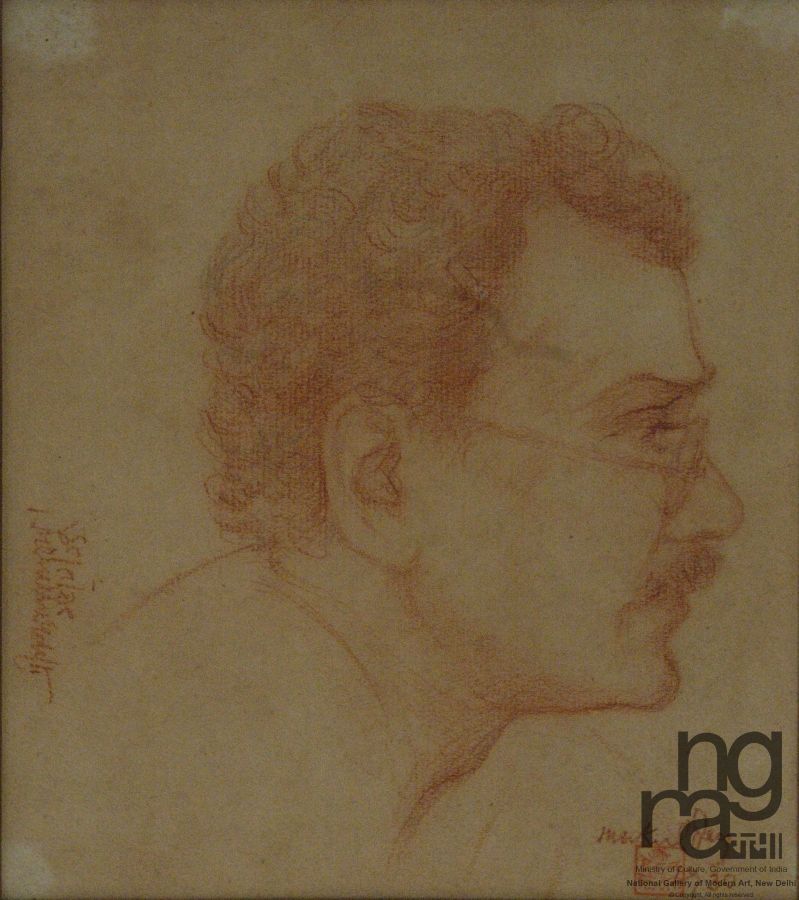
ngma-01554 | Chalk and Pencil on Paper | Mukul Dey
Tribute to The pioneer of Modern Indian Art and a key figure of Contextual Modernism Nandalal Bose on his 139th Birth Anniversary
Artist's Profile
In all forms, ordinary or extraordinary, I seek the life rhythm (pranachanda) of the reality whose vitality has generated the whole world and all its forms, actual and imaginary, and pulsates within them.
Nandalal Bose
Your paint-brush colors India’s heart,
And fills Bengal`s treasury with new riches.
Rabindranath Tagore, 1914
At a time when India’s artistic traditions had been largely lost after years of British colonial rule, one artist, Nandalal Bose made a unique contribution through art and education towards the cultural regeneration and independence of the nation.
Unmistakably Nandalal Bose occupies the central position within development of modern art sphere. Nandalal merits attention as the prime exponent of modernist values and certainly, it is possible to trace the unique strain of modern Indian art – directly through him. The paintings and graphic works of Nandalal Bose are filled with intense beauty and endless invention. Remarkable as works of art, they also reflect the trajectory of modern Indian cultural development. The varied range of expressions within his creations reveal his innate skills more clearly than any other medium. His endless inventions were motivated by the ideal of reviving classical Indian culture. Remarkably, Nandalal’s oeuvre is not as neatly divided into demarcated phases like those of established western artists such as Picasso. He moved from one mode to another, from Classical Indian to Mughal and Rajput Miniature, to Folk art and many of other art forms he had mastered, with élan.
Yet, instead of jumping from one style and topic to another, he probed deep into the subject matter, mastering the principles of each of the modes he had worked with.
Nandalal was the first among modern artists of India to return to and effectively revitalized the wall painting tradition that for millennia had been the mainstay of historical Indian painters. He as a teacher also emphasized the importance of becoming closely familiar with ancient Indian forms of art.
For good reasons, the Master Artist is considered as the Father of Modern Art in India. Equally important is the fact that he stood as one of the last essentially traditional Indian painters. By serving both, as a painter who worked and as a teacher of Indian Modern and Contemporary art, he effectively rejuvenated his country’s art form and liberated classical Indian form from the clutches of colonial rule and indeed contributed to the freedom of India.
Nandalal Bose, popularly known as the Master Moshai, was born on December 3rd, 1882 in Kharagpur, Monghyr District, Bihar. A disciple of Abanindranath Tagore, he graduated from Government School of Art, Calcutta in 1910. Nandalal was fascinated by the potential of folk art and indigenous modes of expression and inculcated them in his works although stylising them in a unique representation for depiction and narration of local life. His explorative temperament with artistic materials allowed him to create a vast body of work with printmaking techniques such as lithography, linoleum prints and Sino-Japanese techniques while remaining faithful to his narrative subject: India's environment and its ethos. Nandalal Bose's art conjures newness unbound, yet it is flushed with the memories of yesterday. Inspired by Far Eastern sensibilities that celebrate the traditional, the genius of his art lies in the interplay of sensual silhouettes and his powerful rendering of contemporary themes with the traditions, customs and sensibilities of Indian heritage. It is this intermingling that invigorates his works and captures the minds of his viewers. He began his artistic career in the fervour of the Swadeshi movement, rejecting western colonial norms of art and taking inspiration from the ancient murals of Ajanta and Bagh caves as well as Mughal miniatures. In 1919, Nandalal Bose accepted Rabindranath Tagore's invitation to become the Principal of the newly established art school Kala Bhavan at Visvabharati University in Santiniketan. He travelled in and out of India including places like Burma, China, Japan, Malaysia, Java and Sri Lanka seeking artistic stimulus from observing different cultural traditions. He also painted a series of posters for the Indian National Congress at Haripura in February 1938. The range of Nandalal's artistic expression is seen in his various landscapes with human figures, his varied images of nature and the Santiniketan Murals. His works reflect the changing landscape, portraying people and places at a time when modern India's cultural development was at its threshold. Nandalal Bose died on April 16th, 1966 in Santiniketan, West Bengal. He won several accolades including the Padma Vibhushan by the President of India in 1953. He was awarded with an honorary Doctorate in Letters (D. Litt.) from Banaras Hindu University in 1950 and Calcutta University in 1957. The NGMA has over 6800 of his works in its collection.
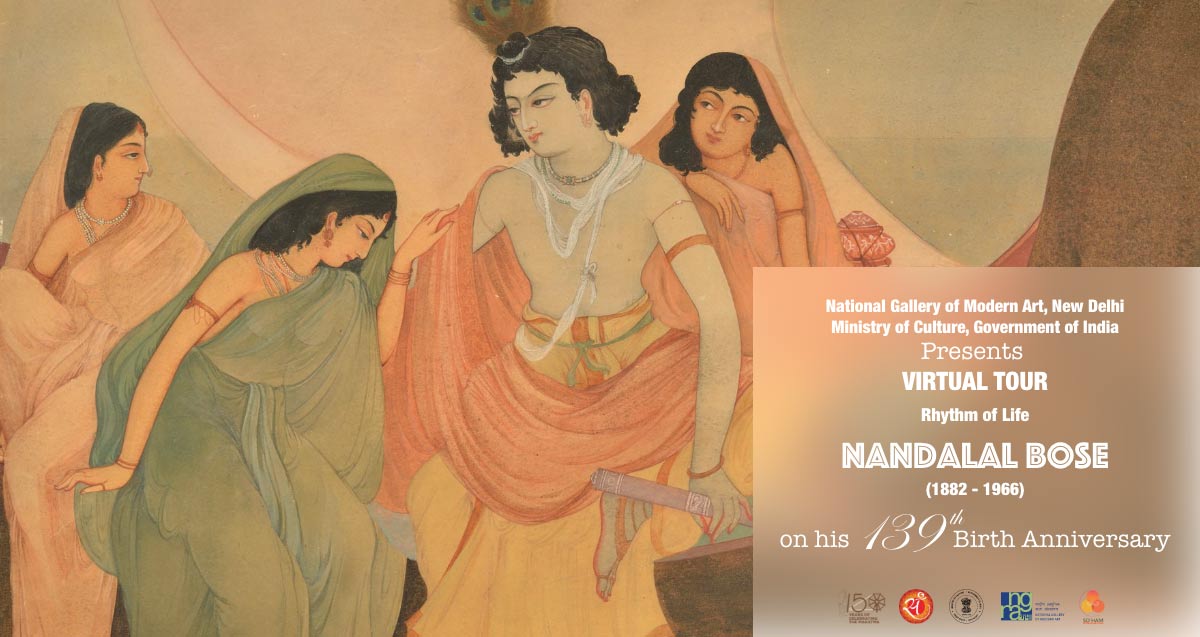
Research Material
Team JATAN, NGMA New Delhi
Concept, Design & Development
IT Cell, NGMA
S S Paul, Information Systems Manager,
Aniruddha Mukherjee, Systems Analyst
Yogesh Vats, Systems Analyst
Content Management
IT Cell, NGMA
Literary Reference
The Catalogue : "Rhythms of India-The Art of Nandalal Bose" published by San Diego Foundation
Video Courtesy : Video documentation is based on the video production by San Diego Museum of Art
-
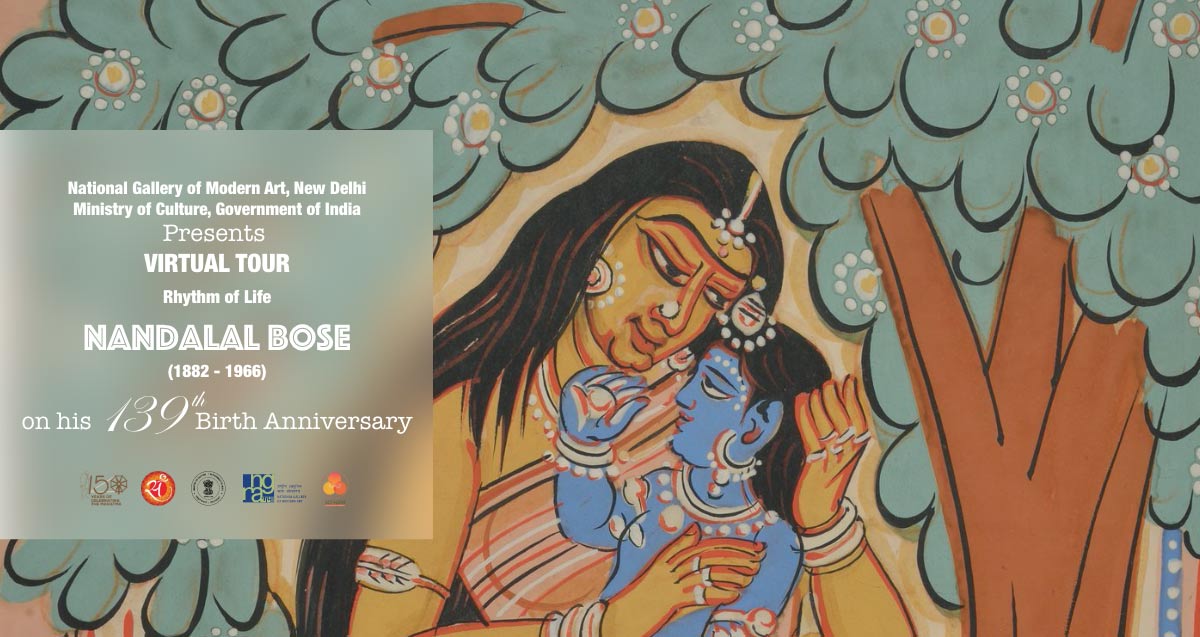 ×
×Concept Note
Virtual Tour
Virtual Tour | Rhythm of Life - Nandalal Bose
The pioneer of modern Indian Art and a key figure of Contextual Modernism.
The Virtual Tour titled “Rhythm of Life : Nandalal Bose” is organized to commemorate the 139th Birth Anniversary of Nandalal Bose on 3rd December 2020. Nandalal is known to have fervently sketched on postcard sized papers mostly using ink and brush, recording his surroundings. The compositions are rendered with linear, soft brush strokes delineating the cheerful forms and suggesting the demeanour of the subject. National Gallery of Modern Art, New Delhi acquired the largest collection of 6744 artworks of Nandalal Bose from his family some of which were exhibited in the Centenary celebratory exhibition organised by the museum in the year 1983. A major portion of the museum's collection includes monochromatic pencil sketches, pen and ink drawings on postcard and paper, watercolour paintings and sketches apart from the more detailed and elaborate tempera and wash paintings, Haripura posters and prints from the artist's extensive oeuvre. This virtual tour presents the 150 works of art from the prominent artworks of Nandalal Bose from reserve collection of NGMA, grouped in a series of four different themes of (i) Haripura Posters, (ii) Flow of Life, (iii) Monochrome and (iv) Transcendental. This virtual tour also showcases artists creation on Post Cards from the collection of NGMA containing 175 works of art. I take pride of the tireless effort of our entire IT Cell to conceive and conceptualize the idea of launching a series of Virtual Tours and designed and developed the same during this pandemic period to facilitate our esteemed visitors with the prestigious collection of NGMA.
-
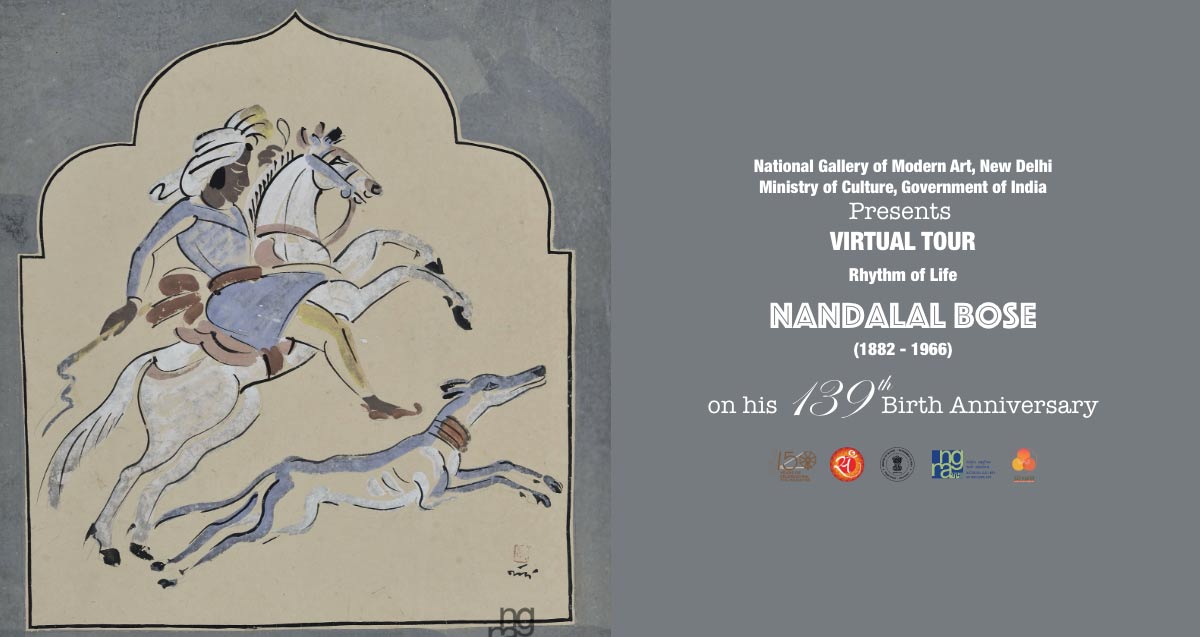 ×
×Concept Note
Virtual Tour
Virtual Tour | Rhythm of Life - Nandalal Bose
The pioneer of modern Indian Art and a key figure of Contextual Modernism.
The Virtual Tour titled “Rhythm of Life : Nandalal Bose” is organized to commemorate the 139th Birth Anniversary of Nandalal Bose on 3rd December 2020. Nandalal is known to have fervently sketched on postcard sized papers mostly using ink and brush, recording his surroundings. The compositions are rendered with linear, soft brush strokes delineating the cheerful forms and suggesting the demeanour of the subject. National Gallery of Modern Art, New Delhi acquired the largest collection of 6744 artworks of Nandalal Bose from his family some of which were exhibited in the Centenary celebratory exhibition organised by the museum in the year 1983. A major portion of the museum's collection includes monochromatic pencil sketches, pen and ink drawings on postcard and paper, watercolour paintings and sketches apart from the more detailed and elaborate tempera and wash paintings, Haripura posters and prints from the artist's extensive oeuvre. This virtual tour presents the 150 works of art from the prominent artworks of Nandalal Bose from reserve collection of NGMA, grouped in a series of four different themes of (i) Haripura Posters, (ii) Flow of Life, (iii) Monochrome and (iv) Transcendental. This virtual tour also showcases artists creation on Post Cards from the collection of NGMA containing 175 works of art. I take pride of the tireless effort of our entire IT Cell to conceive and conceptualize the idea of launching a series of Virtual Tours and designed and developed the same during this pandemic period to facilitate our esteemed visitors with the prestigious collection of NGMA. Adwaita Charan Gadanayak
Director General, NGMA -
Painting
 ×Haripura posters by Nandalal capture moments of everyday Indian village life and culture. In this poster, he has depicted a woman draped in saree, sits on the ground in the act of 'Pranam';( it is a form of ""respectful salutation"" or ""reverential bowing"" before something, or another person - usually grandparents, parents, elders or teachers or someone deeply respected such as a deity). The female figure has been articulated with earthen colour palette and swift strokes executed the contours in a calligraphic manner that both the styles and subject matter exude the charm and playfulness often found in folk art. This aptly limns the figure with the artist's personal sensibilities.
×Haripura posters by Nandalal capture moments of everyday Indian village life and culture. In this poster, he has depicted a woman draped in saree, sits on the ground in the act of 'Pranam';( it is a form of ""respectful salutation"" or ""reverential bowing"" before something, or another person - usually grandparents, parents, elders or teachers or someone deeply respected such as a deity). The female figure has been articulated with earthen colour palette and swift strokes executed the contours in a calligraphic manner that both the styles and subject matter exude the charm and playfulness often found in folk art. This aptly limns the figure with the artist's personal sensibilities. -
Painting
 ×Haripura posters by Nandalal capture moments of everyday Indian village life and culture. This poster is one of many examples of acute observation of his surrounding in which he has depicted a farmer engaged in the act of 'ploughing the field'. The illustration has been articulated with earthen colour palette and swift strokes executed the contours in a calligraphic manner that both the styles and subject matter exude the charm and playfulness often found in folk art. This aptly limns the figure with the artist's personal sensibilities.
×Haripura posters by Nandalal capture moments of everyday Indian village life and culture. This poster is one of many examples of acute observation of his surrounding in which he has depicted a farmer engaged in the act of 'ploughing the field'. The illustration has been articulated with earthen colour palette and swift strokes executed the contours in a calligraphic manner that both the styles and subject matter exude the charm and playfulness often found in folk art. This aptly limns the figure with the artist's personal sensibilities. -
Painting
 ×Among his prolific body of work, Nandlal Bose also painted a series of posters for the Indian National Congress at Haripura in February 1937. This work was commissioned to him by Mahatma Gandhi to decorate the pandal for the Congress session at Haripura. These were the portrayals of the common people in a very simple visual language like that of the folk art.
×Among his prolific body of work, Nandlal Bose also painted a series of posters for the Indian National Congress at Haripura in February 1937. This work was commissioned to him by Mahatma Gandhi to decorate the pandal for the Congress session at Haripura. These were the portrayals of the common people in a very simple visual language like that of the folk art. -
Painting
 ×Among his prolific body of work, Nandlal Bose also painted a series of posters for the Indian National Congress at Haripura in February 1937. This work was commissioned to him by Mahatma Gandhi to decorate the pandal for the Congress session at Haripura. These were the portrayals of the common people in a very simple visual language like that of the folk art.
×Among his prolific body of work, Nandlal Bose also painted a series of posters for the Indian National Congress at Haripura in February 1937. This work was commissioned to him by Mahatma Gandhi to decorate the pandal for the Congress session at Haripura. These were the portrayals of the common people in a very simple visual language like that of the folk art. -
Painting
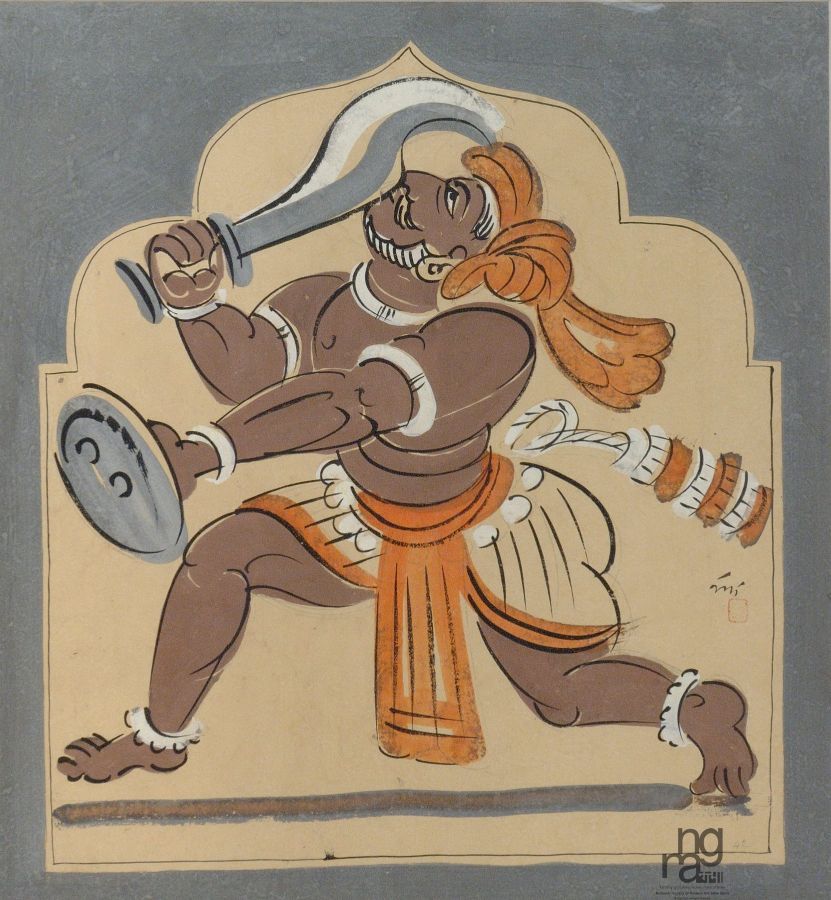 ×Among his prolific body of work, Nandlal Bose also painted a series of posters for the Indian National Congress at Haripura in February 1937. This work was commissioned to him by Mahatma Gandhi to decorate the pandal for the Congress session at Haripura. This painting depicts a Indian warrior with his sword in action in a war.
×Among his prolific body of work, Nandlal Bose also painted a series of posters for the Indian National Congress at Haripura in February 1937. This work was commissioned to him by Mahatma Gandhi to decorate the pandal for the Congress session at Haripura. This painting depicts a Indian warrior with his sword in action in a war. -
Painting
 ×Among his prolific body of work, Nandlal Bose also painted a series of posters for the Indian National Congress at Haripura in February 1937. This work was commissioned to him by Mahatma Gandhi to decorate the pandal for the Congress session at Haripura. This painting depicts a Dhaki, traditional drummer in Bengal.
×Among his prolific body of work, Nandlal Bose also painted a series of posters for the Indian National Congress at Haripura in February 1937. This work was commissioned to him by Mahatma Gandhi to decorate the pandal for the Congress session at Haripura. This painting depicts a Dhaki, traditional drummer in Bengal. -
Painting
 ×"Haripura posters by Nandalal capture moments of everyday Indian village life and culture. This particular poster shows his acute observation of the surroundings in which he has depicted a cobbler engaged in the process of repairing a shoe. The illustration has been articulated with the earthy colour palette and spontaneous and energetic graphic lines which aptly limn the figure with the artist's personal sensibilities.
×"Haripura posters by Nandalal capture moments of everyday Indian village life and culture. This particular poster shows his acute observation of the surroundings in which he has depicted a cobbler engaged in the process of repairing a shoe. The illustration has been articulated with the earthy colour palette and spontaneous and energetic graphic lines which aptly limn the figure with the artist's personal sensibilities. -
Painting
 ×"Haripura posters by Nandalal captured moments of everyday Indian village life and culture. In these illustrations, the artist evolves his visual language to bring out the rhythm and coherence in his subjects rather than their imitation in formal resemblance. In this poster, he has depicted a Mughal warrior sitting with his shield and spear, executed in earthen colours and swift strokes in calligraphic manner reminiscent of Indian folk art.
×"Haripura posters by Nandalal captured moments of everyday Indian village life and culture. In these illustrations, the artist evolves his visual language to bring out the rhythm and coherence in his subjects rather than their imitation in formal resemblance. In this poster, he has depicted a Mughal warrior sitting with his shield and spear, executed in earthen colours and swift strokes in calligraphic manner reminiscent of Indian folk art. -
Painting
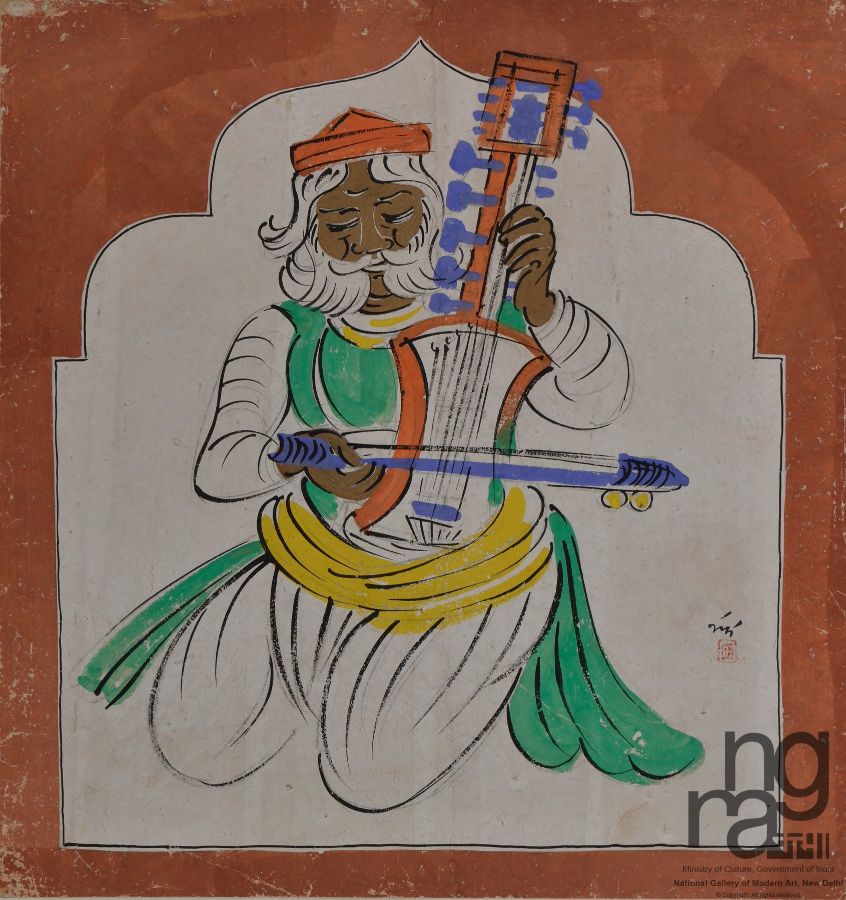 ×"Haripura posters by Nandalal capture moments of everyday Indian village life and culture. In this poster, he has depicted an old man playing ‘Sarangi' (an instrument used in Indian classical music), filled with action and expressive of her mood and character. The illustration has been executed with vibrant earthy colours and spontaneous, energetic contouring lines aptly limn the figure with the artist's personal sensibilities.
×"Haripura posters by Nandalal capture moments of everyday Indian village life and culture. In this poster, he has depicted an old man playing ‘Sarangi' (an instrument used in Indian classical music), filled with action and expressive of her mood and character. The illustration has been executed with vibrant earthy colours and spontaneous, energetic contouring lines aptly limn the figure with the artist's personal sensibilities. -
Painting
 ×"Haripura posters by Nandalal capture moments of everyday Indian village life and culture. In this poster, he has depicted an old man playing ‘Sarangi' (an instrument used in Indian classical music), filled with action and expressive of her mood and character. The illustration has been executed with vibrant earthy colours and spontaneous, energetic contouring lines aptly limn the figure with the artist's personal sensibilities.
×"Haripura posters by Nandalal capture moments of everyday Indian village life and culture. In this poster, he has depicted an old man playing ‘Sarangi' (an instrument used in Indian classical music), filled with action and expressive of her mood and character. The illustration has been executed with vibrant earthy colours and spontaneous, energetic contouring lines aptly limn the figure with the artist's personal sensibilities. -
Painting
 ×Among his prolific body of work, Nandlal Bose also painted a series of posters for the Indian National Congress at Haripura in February 1937. This work was commissioned to him by Mahatma Gandhi to decorate the pandal for the Congress session at Haripura. This image depicts the musiciam=na playing the Shanai and drums.
×Among his prolific body of work, Nandlal Bose also painted a series of posters for the Indian National Congress at Haripura in February 1937. This work was commissioned to him by Mahatma Gandhi to decorate the pandal for the Congress session at Haripura. This image depicts the musiciam=na playing the Shanai and drums. -
Painting
 ×"Haripura posters by Nandalal captured moments of everyday Indian village life and culture. In these illustrations, the artist evolves his visual language to bring out the rhythm and coherence in his subjects rather than their imitation in formal resemblance. In this poster, he has depicted a drummer sitting on the floor and playing his instrument, executed in vibrant earthy colors and spontaneous, energetic contouring lines.
×"Haripura posters by Nandalal captured moments of everyday Indian village life and culture. In these illustrations, the artist evolves his visual language to bring out the rhythm and coherence in his subjects rather than their imitation in formal resemblance. In this poster, he has depicted a drummer sitting on the floor and playing his instrument, executed in vibrant earthy colors and spontaneous, energetic contouring lines. -
Painting
 ×"Haripura posters by Nandalal capture moments of everyday Indian village life and culture. This poster is one of many examples of acute observation of his surrounding in which he has depicted a woman sitting on a lower platform and cutting vegetables. The figure has been articulated with earthen colour palette and swift strokes executed in a calligraphic manner that both the styles and subject matter exude the charm and playfulness often found in folk art.
×"Haripura posters by Nandalal capture moments of everyday Indian village life and culture. This poster is one of many examples of acute observation of his surrounding in which he has depicted a woman sitting on a lower platform and cutting vegetables. The figure has been articulated with earthen colour palette and swift strokes executed in a calligraphic manner that both the styles and subject matter exude the charm and playfulness often found in folk art. -
Painting
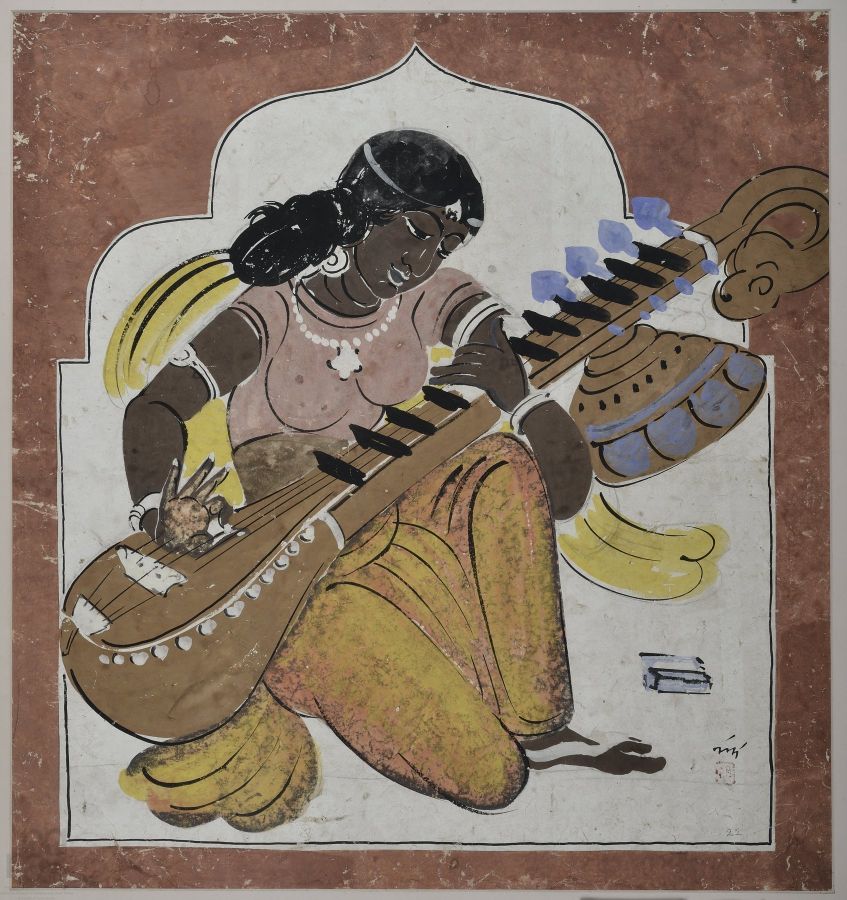 ×"Haripura posters by Nandalal capture moments of everyday Indian village life and culture. In this poster, he has depicted a woman playing ‘Vina' (a large plucked string instrument used in Hindustani classical music), filled with action and expressive of her mood and character. The illustration has been executed with vibrant earthy colours and spontaneous, energetic contouring lines aptly limn the figure with the artist's personal sensibilities.
×"Haripura posters by Nandalal capture moments of everyday Indian village life and culture. In this poster, he has depicted a woman playing ‘Vina' (a large plucked string instrument used in Hindustani classical music), filled with action and expressive of her mood and character. The illustration has been executed with vibrant earthy colours and spontaneous, energetic contouring lines aptly limn the figure with the artist's personal sensibilities. -
Painting
 ×"Haripura posters by Nandalal capture moments of everyday Indian village life and culture. This particular poster shows his acute observation of the surroundings in which he has depicted a man engaged in cleaning ear of a woman sitting on a stool. The illustration has been articulated with the earthy colour palette and spontaneous and energetic graphic lines which aptly limn the figure with the artist's personal sensibilities.
×"Haripura posters by Nandalal capture moments of everyday Indian village life and culture. This particular poster shows his acute observation of the surroundings in which he has depicted a man engaged in cleaning ear of a woman sitting on a stool. The illustration has been articulated with the earthy colour palette and spontaneous and energetic graphic lines which aptly limn the figure with the artist's personal sensibilities. -
Painting
 ×"Haripura posters by Nandalal captured moments of everyday Indian village life and culture. In these illustrations, the artist evolves his visual language to bring out the rhythm and coherence in his subjects rather than their imitation in formal resemblance. In this poster, he has depicted a camel sitting near a palm tree, executed in earthen colors and swift strokes in calligraphic manner reminiscent of Indian folk art.
×"Haripura posters by Nandalal captured moments of everyday Indian village life and culture. In these illustrations, the artist evolves his visual language to bring out the rhythm and coherence in his subjects rather than their imitation in formal resemblance. In this poster, he has depicted a camel sitting near a palm tree, executed in earthen colors and swift strokes in calligraphic manner reminiscent of Indian folk art. -
Painting
 ×Haripura Poster Haripura posters by Nandalal capture moments of everyday Indian village life and culture. In this poster, he has depicted a woman figure that has a pair of wings on her head and she sits on a raised platform. He has articulated this picture with earthy colour palette and spontaneous and energetic graphic lines aptly limn the figure with his personal sensibilities.
×Haripura Poster Haripura posters by Nandalal capture moments of everyday Indian village life and culture. In this poster, he has depicted a woman figure that has a pair of wings on her head and she sits on a raised platform. He has articulated this picture with earthy colour palette and spontaneous and energetic graphic lines aptly limn the figure with his personal sensibilities. -
Painting
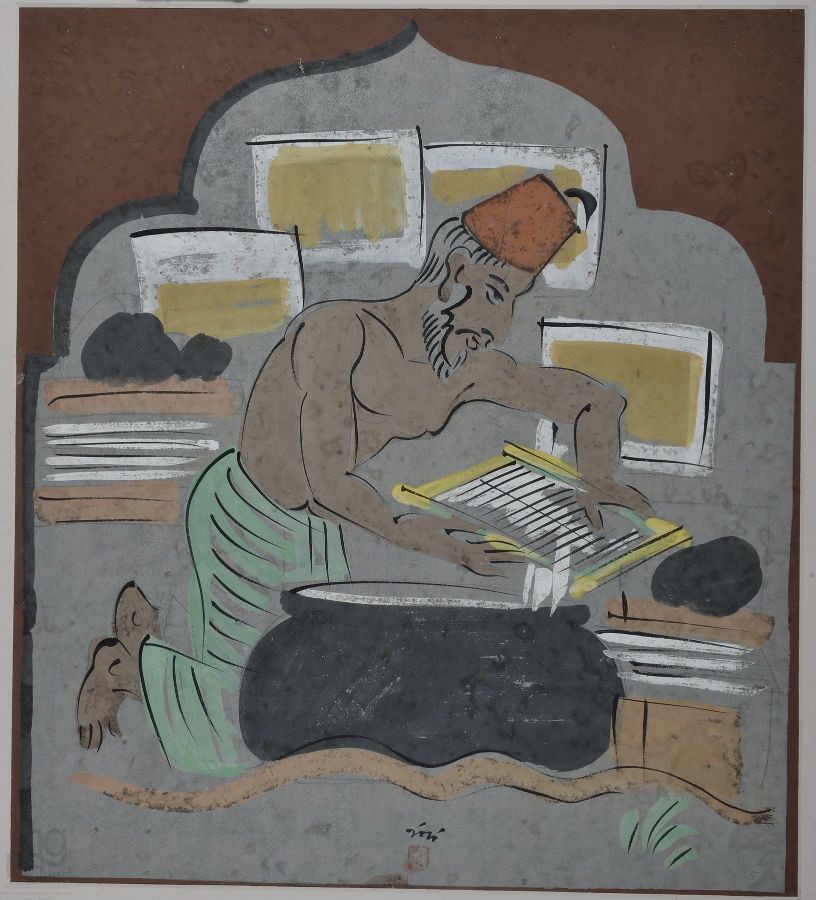 ×Haripura posters by Nandalal capture moments of everyday Indian village life and culture. In this poster, he has depicted a woman figure that has a pair of wings on her head and she sits on a raised platform. He has articulated this picture with earthy colour palette and spontaneous and energetic graphic lines aptly limn the figure with his personal sensibilities.
×Haripura posters by Nandalal capture moments of everyday Indian village life and culture. In this poster, he has depicted a woman figure that has a pair of wings on her head and she sits on a raised platform. He has articulated this picture with earthy colour palette and spontaneous and energetic graphic lines aptly limn the figure with his personal sensibilities. -
Painting
 ×"Haripura posters by Nandalal capture moments of everyday Indian village life and culture. In this poster he has depicted a 'dhol wala' (a drummer) sitting on the floor and playing his instrument, filled with action and expressive of his mood and character. The illustration has been executed with vibrant earthy colours and spontaneous, energetic contouring lines which aptly limn the figure with the artist's personal sensibilities.
×"Haripura posters by Nandalal capture moments of everyday Indian village life and culture. In this poster he has depicted a 'dhol wala' (a drummer) sitting on the floor and playing his instrument, filled with action and expressive of his mood and character. The illustration has been executed with vibrant earthy colours and spontaneous, energetic contouring lines which aptly limn the figure with the artist's personal sensibilities. -
Painting
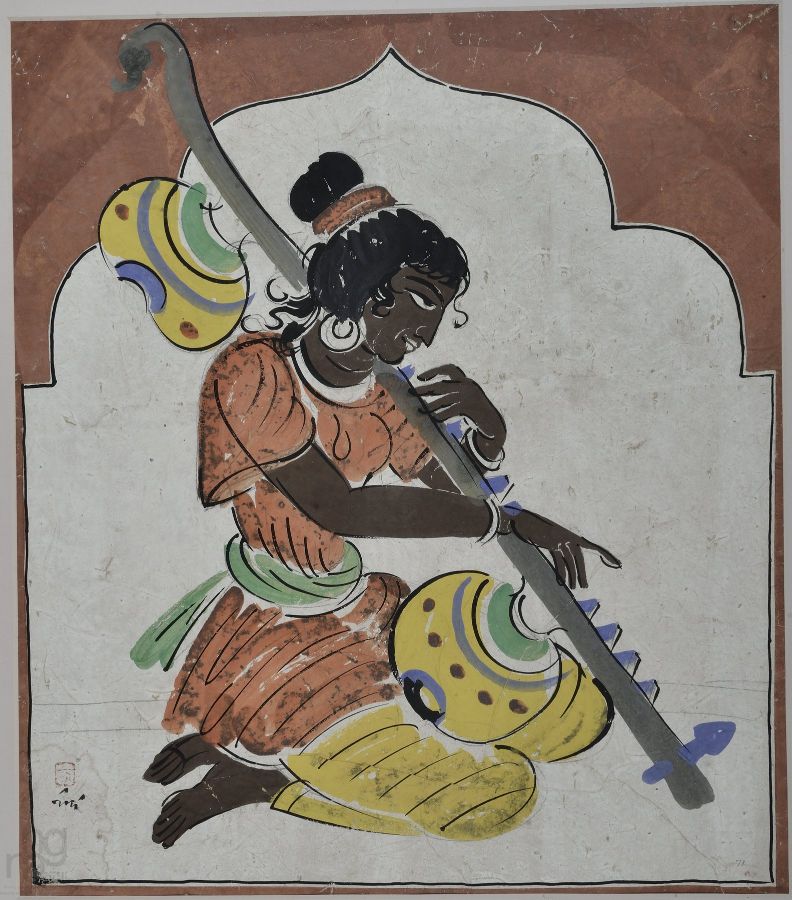 ×Haripura posters by Nandalal capture moments of everyday Indian village life and culture. In this poster, he has depicted a woman playing 'Rudra Vina' (a large plucked string instrument used in Hindustani classical music), filled with action and expressive of her mood and character. The illustration has been executed with vibrant earthy colours and spontaneous, energetic contouring lines aptly limn the figure with the artist's personal sensibilities.
×Haripura posters by Nandalal capture moments of everyday Indian village life and culture. In this poster, he has depicted a woman playing 'Rudra Vina' (a large plucked string instrument used in Hindustani classical music), filled with action and expressive of her mood and character. The illustration has been executed with vibrant earthy colours and spontaneous, energetic contouring lines aptly limn the figure with the artist's personal sensibilities. -
Painting
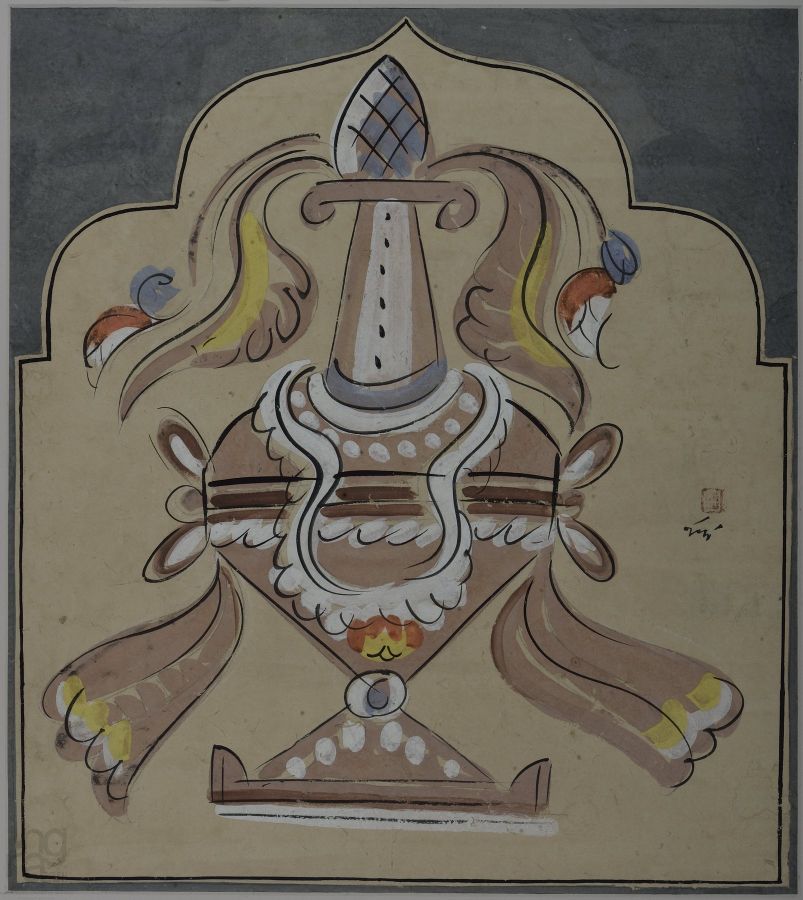 ×Haripura posters by Nandalal capture moments of everyday Indian village life and culture. In these illustrations, Nandalal evolves his visual language to bring out the rhythm and coherence in his subjects rather than their imitation in formal.
×Haripura posters by Nandalal capture moments of everyday Indian village life and culture. In these illustrations, Nandalal evolves his visual language to bring out the rhythm and coherence in his subjects rather than their imitation in formal. -
Painting
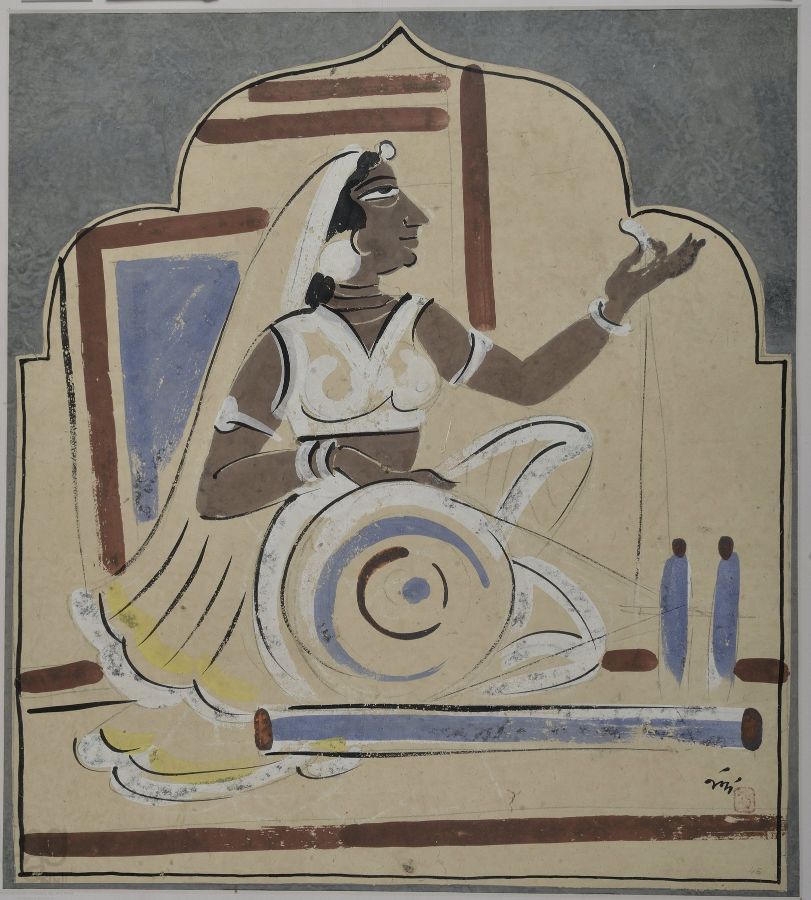 ×"Haripura posters by Nandalal capture moments of everyday Indian village life and culture. In this poster, he has depicted a woman engaged in the process of wool spinning. He has articulated this picture with the earthy colour palette and spontaneous, energetic graphic lines which aptly limn the figure with his personal sensibilities.
×"Haripura posters by Nandalal capture moments of everyday Indian village life and culture. In this poster, he has depicted a woman engaged in the process of wool spinning. He has articulated this picture with the earthy colour palette and spontaneous, energetic graphic lines which aptly limn the figure with his personal sensibilities. -
Painting
 ×Haripura posters by Nandalal capture moments of everyday Indian village life and culture. This poster is one of many examples of acute observation of his surrounding in which he has depicted 'a Baul' (a mystic minstrel from Bengal) playing his instrument. The figure is filled with action and expressive of his mood and character, executed with vibrant earthy colours and spontaneous, energetic contouring lines aptly limn the figure with the artist's personal sensibilities toward Indian folk arts.
×Haripura posters by Nandalal capture moments of everyday Indian village life and culture. This poster is one of many examples of acute observation of his surrounding in which he has depicted 'a Baul' (a mystic minstrel from Bengal) playing his instrument. The figure is filled with action and expressive of his mood and character, executed with vibrant earthy colours and spontaneous, energetic contouring lines aptly limn the figure with the artist's personal sensibilities toward Indian folk arts. -
Painting
 ×"Haripura posters by Nandalal capture moments of everyday Indian village life and culture. This poster is one of many examples of acute observation of his surrounding in which he has depicted a woman playing 'manjira' (a traditional percussion instrument from India. In its simplest form, it consists of a pair of small hand cymbals). The female figure is filled with action and expressive of her mood and character, executed with vibrant earthy colours and spontaneous, energetic contouring lines which aptly limn the figure with the artist's personal sensibilities toward Indian folk arts.
×"Haripura posters by Nandalal capture moments of everyday Indian village life and culture. This poster is one of many examples of acute observation of his surrounding in which he has depicted a woman playing 'manjira' (a traditional percussion instrument from India. In its simplest form, it consists of a pair of small hand cymbals). The female figure is filled with action and expressive of her mood and character, executed with vibrant earthy colours and spontaneous, energetic contouring lines which aptly limn the figure with the artist's personal sensibilities toward Indian folk arts. -
Painting
 ×"Haripura posters by Nandalal capture moments of everyday Indian village life and culture. This poster is one of many examples of acute observation of his surrounding in which he has depicted a woman playing 'manjira' (a traditional percussion instrument from India. In its simplest form, it consists of a pair of small hand cymbals). The female figure is filled with action and expressive of her mood and character, executed with vibrant earthy colours and spontaneous, energetic contouring lines which aptly limn the figure with the artist's personal sensibilities toward Indian folk arts.
×"Haripura posters by Nandalal capture moments of everyday Indian village life and culture. This poster is one of many examples of acute observation of his surrounding in which he has depicted a woman playing 'manjira' (a traditional percussion instrument from India. In its simplest form, it consists of a pair of small hand cymbals). The female figure is filled with action and expressive of her mood and character, executed with vibrant earthy colours and spontaneous, energetic contouring lines which aptly limn the figure with the artist's personal sensibilities toward Indian folk arts. -
Painting
 ×"Haripura posters by Nandalal capture moments of everyday Indian village life and culture. In this poster, he has depicted a woman (a pith worker) engaged in the process of peeling the stems of shola pith (it is a dried milky-white spongy plant matter which can be pressed and shaped into delicate and beautiful objects of art) and a child is embracing her from the back. The artist has articulated this picture with earthy colour palette and spontaneous, energetic graphic lines which aptly limn the figure with his personal sensibilities and reflect the affection between a mother and child relationship.
×"Haripura posters by Nandalal capture moments of everyday Indian village life and culture. In this poster, he has depicted a woman (a pith worker) engaged in the process of peeling the stems of shola pith (it is a dried milky-white spongy plant matter which can be pressed and shaped into delicate and beautiful objects of art) and a child is embracing her from the back. The artist has articulated this picture with earthy colour palette and spontaneous, energetic graphic lines which aptly limn the figure with his personal sensibilities and reflect the affection between a mother and child relationship. -
Painting
 ×"Haripura posters by Nandalal capture moments of everyday Indian village life and culture. This particular poster shows his acute observation of the surroundings in which he has depicted 'a potter' ardently in the process of pot making. The illustration has been articulated with the earthy colour palette and spontaneous and energetic graphic lines which aptly limn the figure with the artist's personal sensibilities.
×"Haripura posters by Nandalal capture moments of everyday Indian village life and culture. This particular poster shows his acute observation of the surroundings in which he has depicted 'a potter' ardently in the process of pot making. The illustration has been articulated with the earthy colour palette and spontaneous and energetic graphic lines which aptly limn the figure with the artist's personal sensibilities. -
Painting
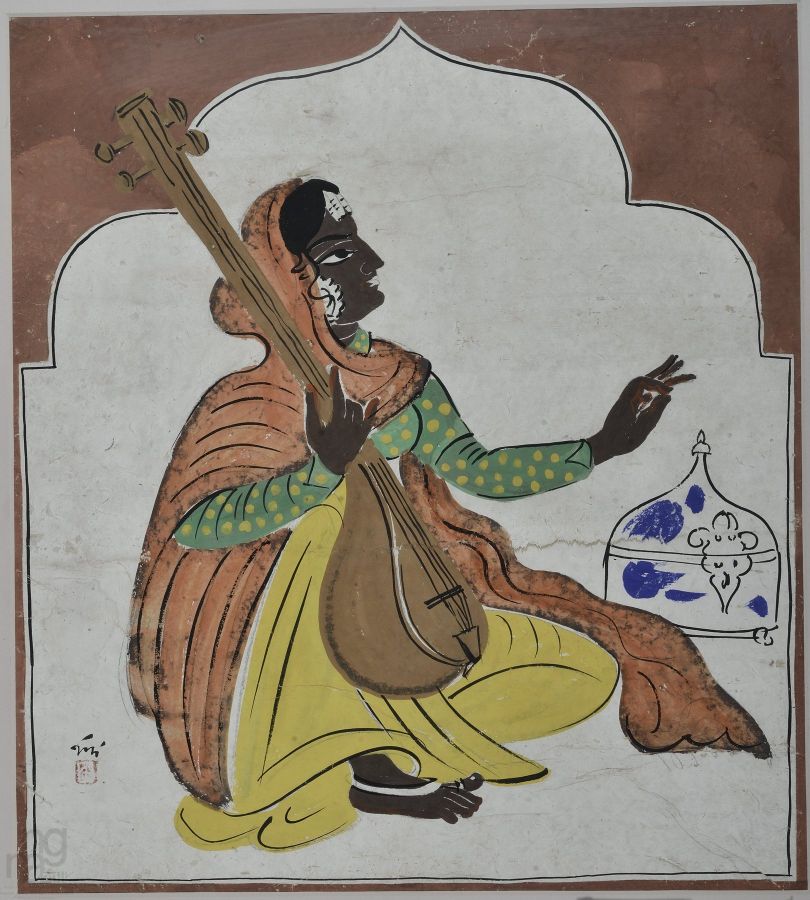 ×"Haripura posters by Nandalal capture moments of everyday Indian village life and culture. This particular poster shows his acute observation of the surroundings in which he has depicted 'a potter' ardently in the process of pot making. The illustration has been articulated with the earthy colour palette and spontaneous and energetic graphic lines which aptly limn the figure with the artist's personal sensibilities.
×"Haripura posters by Nandalal capture moments of everyday Indian village life and culture. This particular poster shows his acute observation of the surroundings in which he has depicted 'a potter' ardently in the process of pot making. The illustration has been articulated with the earthy colour palette and spontaneous and energetic graphic lines which aptly limn the figure with the artist's personal sensibilities. -
Painting
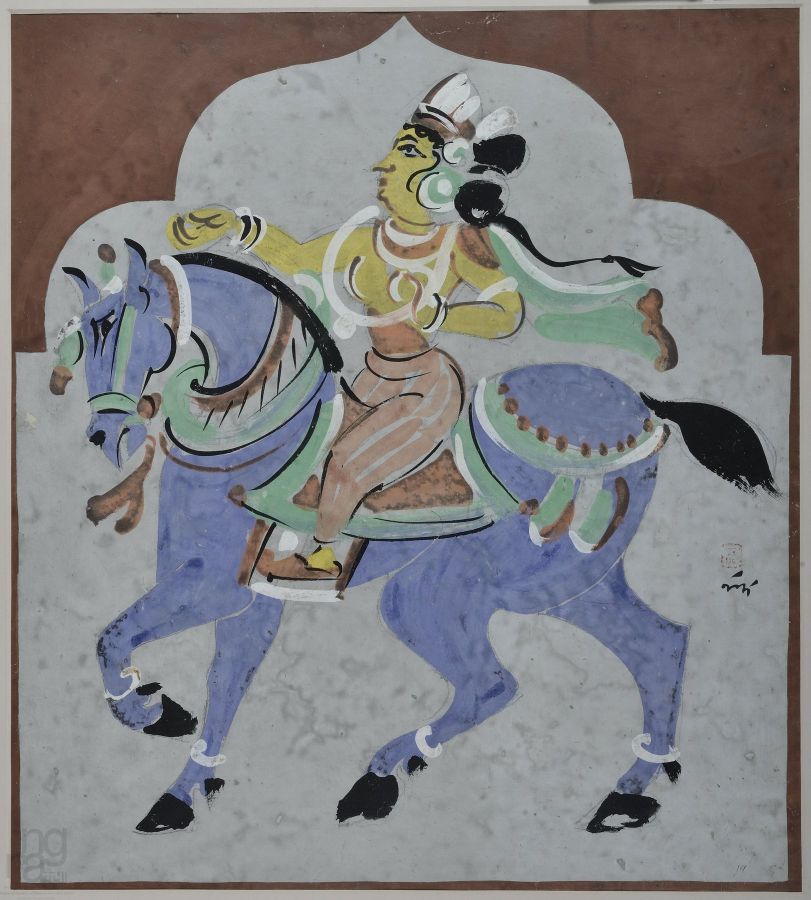 ×Haripura poster by Nandalal capture moments of everyday Indian village life and culture. This poster is one of many examples of acute observation of his surrounding in which he has depicted 'a lady on a horse'. This figure is filled with confidence and symbolises the strength and potency of the Indian woman and their role in the struggle of achieving the independence of India. The forms in poster have been articulated with earthen colour palette and swift strokes executed their contours in a calligraphic manner that both the styles and subject matter exude the charm and playfulness often found in folk art. This aptly limns the figure with the artist's personal sensibilities.
×Haripura poster by Nandalal capture moments of everyday Indian village life and culture. This poster is one of many examples of acute observation of his surrounding in which he has depicted 'a lady on a horse'. This figure is filled with confidence and symbolises the strength and potency of the Indian woman and their role in the struggle of achieving the independence of India. The forms in poster have been articulated with earthen colour palette and swift strokes executed their contours in a calligraphic manner that both the styles and subject matter exude the charm and playfulness often found in folk art. This aptly limns the figure with the artist's personal sensibilities. -
Painting
 ×Haripura posters by Nandalal capture moments of everyday Indian village life and culture. This poster is one of many examples of acute observation of his surrounding in which he has depicted 'a gardener', engaged in digging the ground. The forms have been articulated with earthen colour palette and swift strokes executed their contours in a calligraphic manner that both the styles and subject matter exude the charm and playfulness often found in folk art. This aptly limns the figure with the artist's personal sensibilities.
×Haripura posters by Nandalal capture moments of everyday Indian village life and culture. This poster is one of many examples of acute observation of his surrounding in which he has depicted 'a gardener', engaged in digging the ground. The forms have been articulated with earthen colour palette and swift strokes executed their contours in a calligraphic manner that both the styles and subject matter exude the charm and playfulness often found in folk art. This aptly limns the figure with the artist's personal sensibilities. -
Painting
 ×Haripura posters by Nandalal capture moments of everyday Indian village life and culture. This poster is one of many examples of acute observation of his surrounding in which he has depicted 'a gardener', engaged in digging the ground. The forms have been articulated with earthen colour palette and swift strokes executed their contours in a calligraphic manner that both the styles and subject matter exude the charm and playfulness often found in folk art. This aptly limns the figure with the artist's personal sensibilities.
×Haripura posters by Nandalal capture moments of everyday Indian village life and culture. This poster is one of many examples of acute observation of his surrounding in which he has depicted 'a gardener', engaged in digging the ground. The forms have been articulated with earthen colour palette and swift strokes executed their contours in a calligraphic manner that both the styles and subject matter exude the charm and playfulness often found in folk art. This aptly limns the figure with the artist's personal sensibilities. -
Painting
 ×Haripura posters by Nandalal capture moments of everyday Indian village life and culture. This poster is one of many examples of acute observation of his surrounding in which he has depicted a woman engaged in the act of 'winnowing'. The forms in poster have been articulated with earthen colour palette and swift strokes executed their contours in a calligraphic manner that both the styles and subject matter exude the charm and playfulness often found in folk art. This aptly limns the figure with the artist's personal sensibilities.
×Haripura posters by Nandalal capture moments of everyday Indian village life and culture. This poster is one of many examples of acute observation of his surrounding in which he has depicted a woman engaged in the act of 'winnowing'. The forms in poster have been articulated with earthen colour palette and swift strokes executed their contours in a calligraphic manner that both the styles and subject matter exude the charm and playfulness often found in folk art. This aptly limns the figure with the artist's personal sensibilities. -
Painting
 ×Haripura posters by Nandalal capture moments of everyday Indian village life and culture. In this poster, he has depicted 'a housewife' draped in saree and sits on a lower chair in leisure. The female figure has been articulated with earthen colour palette and swift strokes executed the contours in a calligraphic manner that both the styles and subject matter exude the charm and playfulness often found in folk art. This aptly limns the figure with the artist's personal sensibilities and his acute observation of the surroundings.
×Haripura posters by Nandalal capture moments of everyday Indian village life and culture. In this poster, he has depicted 'a housewife' draped in saree and sits on a lower chair in leisure. The female figure has been articulated with earthen colour palette and swift strokes executed the contours in a calligraphic manner that both the styles and subject matter exude the charm and playfulness often found in folk art. This aptly limns the figure with the artist's personal sensibilities and his acute observation of the surroundings. -
Print
 ×"Haripura posters by Nandalal captured moments of everyday Indian village life and culture. In these illustrations, the artist evolves his visual language to bring out the hythm and coherence in his subjects rather than their imitation in formal resemblance. In this poster, he has depicted a woman cooking, executed in earthen colours and swift strokes in a calligraphic manner reminiscent of Indian folk art.
×"Haripura posters by Nandalal captured moments of everyday Indian village life and culture. In these illustrations, the artist evolves his visual language to bring out the hythm and coherence in his subjects rather than their imitation in formal resemblance. In this poster, he has depicted a woman cooking, executed in earthen colours and swift strokes in a calligraphic manner reminiscent of Indian folk art. -
Print
 ×Haripura posters by Nandalal capture moments of everyday Indian village life and culture. In this poster, he has depicted 'a housewife' draped in saree and sits on a lower chair in leisure. The female figure has been articulated with earthen colour palette and swift strokes executed the contours in a calligraphic manner that both the styles and subject matter exude the charm and playfulness often found in folk art. This aptly limns the figure with the artist's personal sensibilities and his acute observation of the surroundings.
×Haripura posters by Nandalal capture moments of everyday Indian village life and culture. In this poster, he has depicted 'a housewife' draped in saree and sits on a lower chair in leisure. The female figure has been articulated with earthen colour palette and swift strokes executed the contours in a calligraphic manner that both the styles and subject matter exude the charm and playfulness often found in folk art. This aptly limns the figure with the artist's personal sensibilities and his acute observation of the surroundings. -
Painting
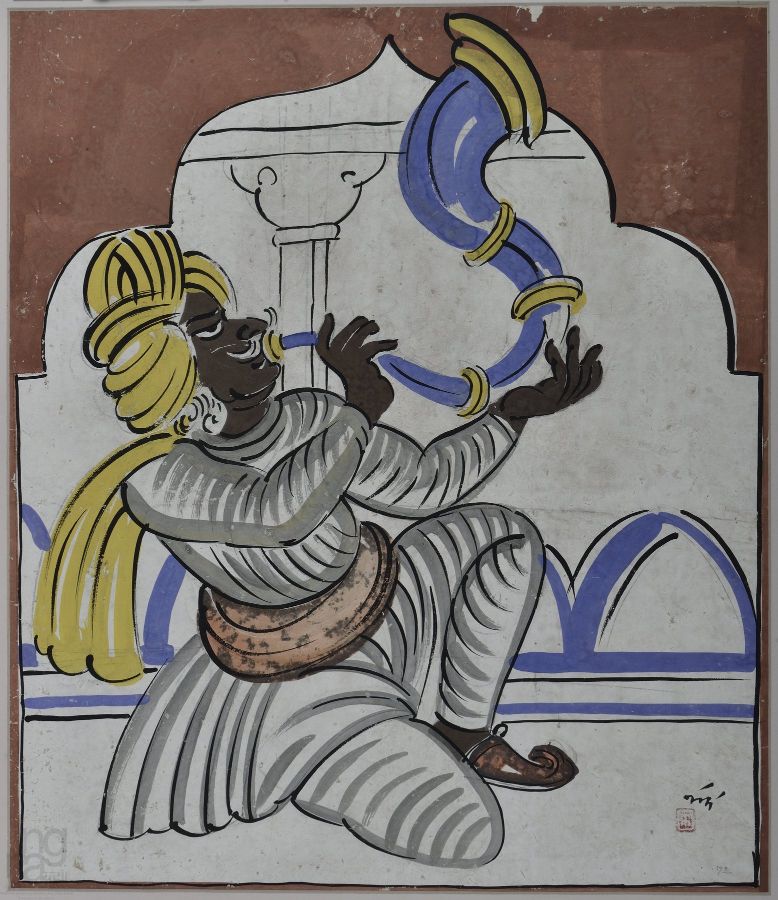 ×"Haripura posters by Nandalal captured moments of everyday Indian village life and culture. In these illustrations, the artist evolves his visual language to bring out the rhythm and coherence in his subjects rather than their imitation in formal resemblance. In this poster, he has depicted a man playing trumpet filled with action. This has been executed in vibrant earthy colors and spontaneous, energetic contouring lines aptly limn the figure with the artist's personal sensibilities.
×"Haripura posters by Nandalal captured moments of everyday Indian village life and culture. In these illustrations, the artist evolves his visual language to bring out the rhythm and coherence in his subjects rather than their imitation in formal resemblance. In this poster, he has depicted a man playing trumpet filled with action. This has been executed in vibrant earthy colors and spontaneous, energetic contouring lines aptly limn the figure with the artist's personal sensibilities. -
Painting
 ×"Haripura posters by Nandalal captured moments of everyday Indian village life and culture. In these illustrations, the artist evolves his visual language to bring out the rhythm and coherence in his subjects rather than their imitation in formal resemblance. In this poster, he has depicted a chariot having national flag leading by a galloping horse. This has been executed in vibrant earthy colors and spontaneous, energetic contouring lines aptly limn the form with the artist's personal sensibilities.
×"Haripura posters by Nandalal captured moments of everyday Indian village life and culture. In these illustrations, the artist evolves his visual language to bring out the rhythm and coherence in his subjects rather than their imitation in formal resemblance. In this poster, he has depicted a chariot having national flag leading by a galloping horse. This has been executed in vibrant earthy colors and spontaneous, energetic contouring lines aptly limn the form with the artist's personal sensibilities. -
Painting
 ×"Haripura posters by Nandalal capture moments of everyday Indian village life and culture. This poster is one of many examples of acute observation of his surrounding in which he has depicted two wrestlers fighting. Both are filled with action and expressive of their mood and character as they have attempted to gain or maintain the superior position. The illustration has been executed with vibrant earthy colours and spontaneous, energetic contouring lines which aptly limn the figure with artist's personal sensibilities toward Indian folk arts.
×"Haripura posters by Nandalal capture moments of everyday Indian village life and culture. This poster is one of many examples of acute observation of his surrounding in which he has depicted two wrestlers fighting. Both are filled with action and expressive of their mood and character as they have attempted to gain or maintain the superior position. The illustration has been executed with vibrant earthy colours and spontaneous, energetic contouring lines which aptly limn the figure with artist's personal sensibilities toward Indian folk arts. -
Painting
 ×"Haripura posters by Nandalal capture moments of everyday Indian village life and culture. This poster is one of many examples of acute observation of his surrounding in which he has depicted two wrestlers fighting. Both are filled with action and expressive of their mood and character as they have attempted to gain or maintain the superior position. The illustration has been executed with vibrant earthy colours and spontaneous, energetic contouring lines which aptly limn the figure with artist's personal sensibilities toward Indian folk arts.
×"Haripura posters by Nandalal capture moments of everyday Indian village life and culture. This poster is one of many examples of acute observation of his surrounding in which he has depicted two wrestlers fighting. Both are filled with action and expressive of their mood and character as they have attempted to gain or maintain the superior position. The illustration has been executed with vibrant earthy colours and spontaneous, energetic contouring lines which aptly limn the figure with artist's personal sensibilities toward Indian folk arts. -
Painting
 ×"Haripura posters by Nandalal capture moments of everyday Indian village life and culture. This poster is one of many examples of acute observation of his surrounding in which he has depicted a'Khanjani wala' (a folk musician who plays a percussion musical instrument called Kahanjani). It is an important part of Indian village culture where after the hard work in the field all farmers and villagers gather in a small club at evening and sing songs and use this musical instrument. Artist has executed this illustration with vibrant earthy colours and spontaneous, energetic contouring lines which aptly limn the figure with the artist's personal sensibilities toward Indian folk arts and tradition.
×"Haripura posters by Nandalal capture moments of everyday Indian village life and culture. This poster is one of many examples of acute observation of his surrounding in which he has depicted a'Khanjani wala' (a folk musician who plays a percussion musical instrument called Kahanjani). It is an important part of Indian village culture where after the hard work in the field all farmers and villagers gather in a small club at evening and sing songs and use this musical instrument. Artist has executed this illustration with vibrant earthy colours and spontaneous, energetic contouring lines which aptly limn the figure with the artist's personal sensibilities toward Indian folk arts and tradition. -
Painting
 ×Haripura posters by Nandalal capture moments of everyday Indian village life and culture. This poster is one of many examples of acute observation of his surrounding in which he has depicted a woman engaged in the act of 'Pounding of Rice'. The forms in poster have been articulated with earthen colour palette and swift strokes executed their contours in a calligraphic manner that both the styles and subject matter exude the charm and playfulness often found in folk art. This aptly limns the figure with the artist's personal sensibilities.
×Haripura posters by Nandalal capture moments of everyday Indian village life and culture. This poster is one of many examples of acute observation of his surrounding in which he has depicted a woman engaged in the act of 'Pounding of Rice'. The forms in poster have been articulated with earthen colour palette and swift strokes executed their contours in a calligraphic manner that both the styles and subject matter exude the charm and playfulness often found in folk art. This aptly limns the figure with the artist's personal sensibilities. -
Painting
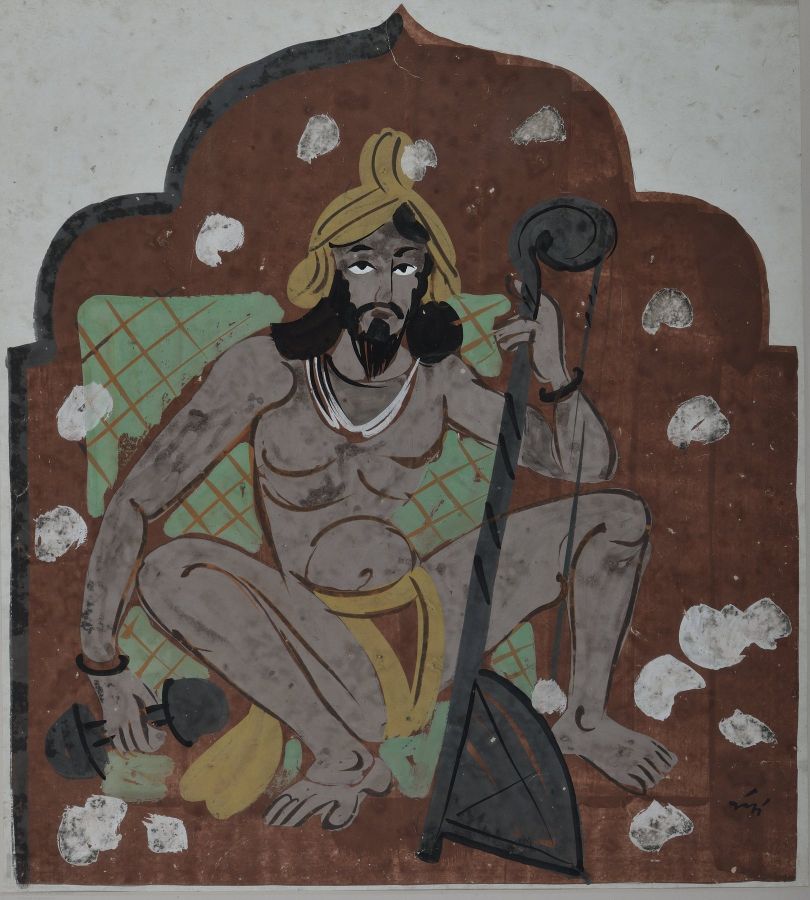 ×"Haripura posters by Nandalal capture moments of everyday Indian village life and culture. This particular poster shows his acute observation of the surroundings in which he has depicted 'a Dhuniya' (cotton carder) engaged in the process of carding. The illustration has been articulated with the earthy colour palette and spontaneous and energetic graphic lines which aptly limn the figure with the artist's personal sensibilities.
×"Haripura posters by Nandalal capture moments of everyday Indian village life and culture. This particular poster shows his acute observation of the surroundings in which he has depicted 'a Dhuniya' (cotton carder) engaged in the process of carding. The illustration has been articulated with the earthy colour palette and spontaneous and energetic graphic lines which aptly limn the figure with the artist's personal sensibilities. -
Painting
 ×"Haripura posters by Nandalal capture moments of everyday Indian village life and culture. In this poster, he has depicted a washerman carrying cloths loaded on a donkey. He has articulated this picture with earthy colour palette and spontaneous and energetic graphic lines, which aptly limn the figure with his personal sensibilities.
×"Haripura posters by Nandalal capture moments of everyday Indian village life and culture. In this poster, he has depicted a washerman carrying cloths loaded on a donkey. He has articulated this picture with earthy colour palette and spontaneous and energetic graphic lines, which aptly limn the figure with his personal sensibilities. -
Painting
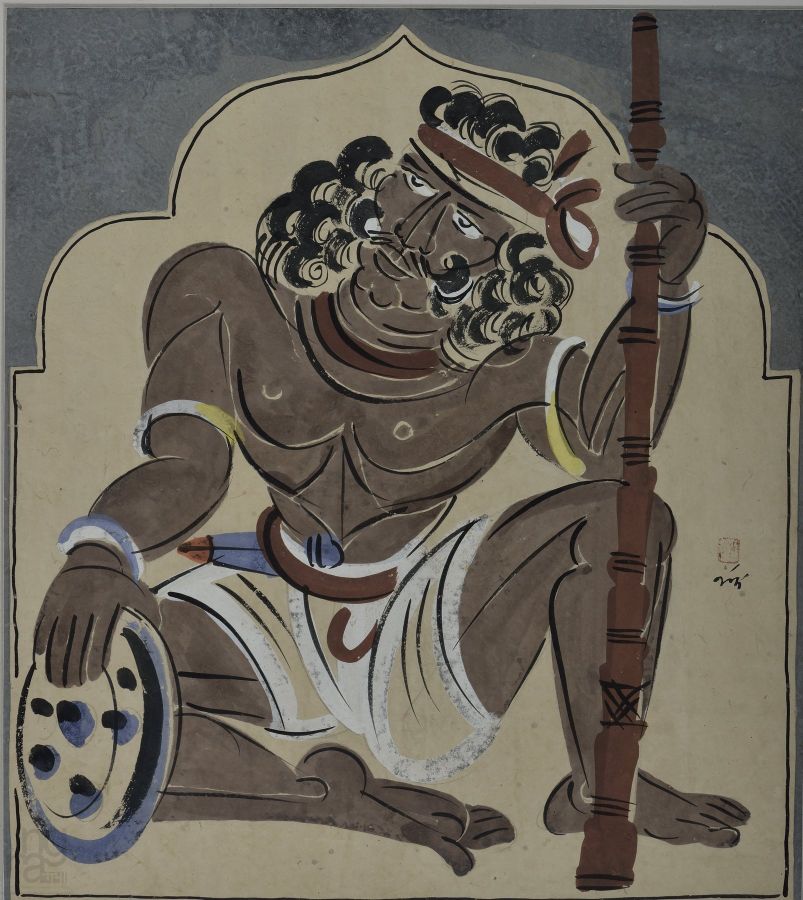 ×"Haripura posters by Nandalal captured moments of everyday Indian village life and culture. In these illustrations, the artist evolves his visual language to bring out the rhythm and coherence in his subjects rather than their imitation in formal resemblance. In this poster, he has depicted a warrior sitting with his shield and spear, executed in earthen colors and swift strokes in calligraphic manner reminiscent of Indian folk art.
×"Haripura posters by Nandalal captured moments of everyday Indian village life and culture. In these illustrations, the artist evolves his visual language to bring out the rhythm and coherence in his subjects rather than their imitation in formal resemblance. In this poster, he has depicted a warrior sitting with his shield and spear, executed in earthen colors and swift strokes in calligraphic manner reminiscent of Indian folk art. -
Painting
 ×Haripura posters by Nandalal captured moments of everyday Indian village life and culture. In these illustrations, the artist evolves his visual language to bring out the rhythm and coherence in his subjects rather than their imitation in formal resemblance. In this poster, he has depicted a goat leaping against a tree, executed in earthen colors and swift strokes in calligraphic manner reminiscent of Indian folk art.
×Haripura posters by Nandalal captured moments of everyday Indian village life and culture. In these illustrations, the artist evolves his visual language to bring out the rhythm and coherence in his subjects rather than their imitation in formal resemblance. In this poster, he has depicted a goat leaping against a tree, executed in earthen colors and swift strokes in calligraphic manner reminiscent of Indian folk art. -
Painting
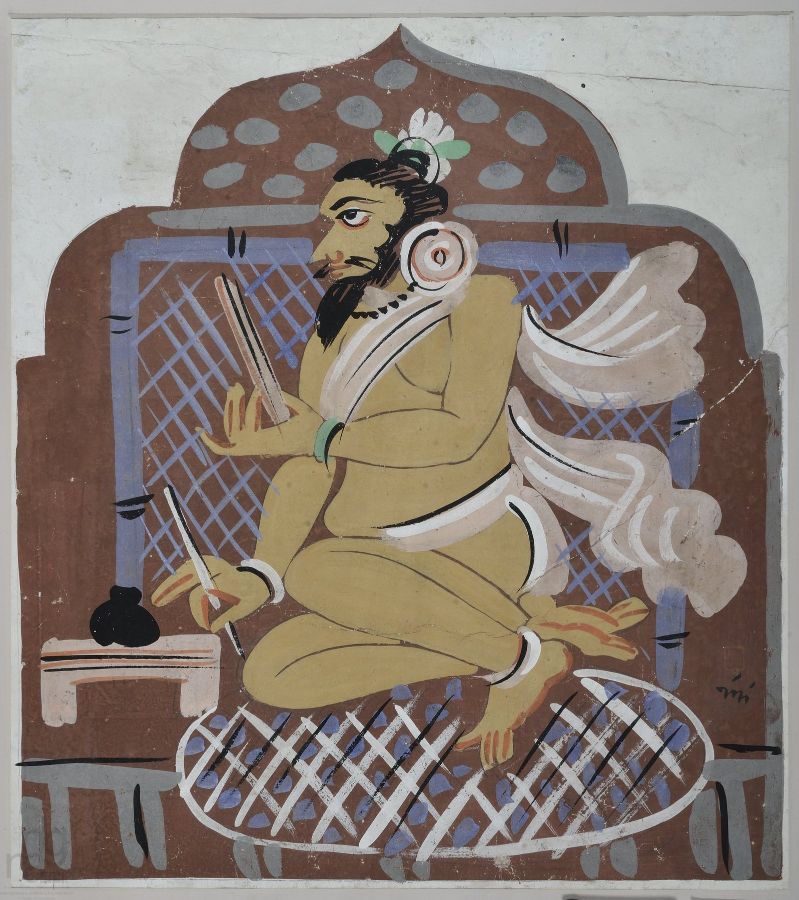 ×"Haripura posters by Nandalal captured moments of everyday Indian village life and culture. In these illustrations, the artist evolves his visual language to bring out the rhythm and coherence in his subjects rather than their imitation in formal resemblance. In this poster, he has depicted ‘a Pandit’ (Hindu priest) sitting over a cushion and studying Vedas, executed in earthen colors and swift strokes in calligraphic manner reminiscent of Indian folk art.
×"Haripura posters by Nandalal captured moments of everyday Indian village life and culture. In these illustrations, the artist evolves his visual language to bring out the rhythm and coherence in his subjects rather than their imitation in formal resemblance. In this poster, he has depicted ‘a Pandit’ (Hindu priest) sitting over a cushion and studying Vedas, executed in earthen colors and swift strokes in calligraphic manner reminiscent of Indian folk art. -
Painting
 ×"Haripura posters by Nandalal captured moments of everyday Indian village life and culture. In these illustrations, the artist evolves his visual language to bring out the rhythm and coherence in his subjects rather than their imitation in formal resemblance. In this poster, he has depicted a 'decorative flagon' executed in earthen colors and swift strokes in calligraphic manner reminiscent of Indian folk art.
×"Haripura posters by Nandalal captured moments of everyday Indian village life and culture. In these illustrations, the artist evolves his visual language to bring out the rhythm and coherence in his subjects rather than their imitation in formal resemblance. In this poster, he has depicted a 'decorative flagon' executed in earthen colors and swift strokes in calligraphic manner reminiscent of Indian folk art. -
Painting
 ×"Haripura posters by Nandalal captured moments of everyday Indian village life and culture. In these illustrations, the artist evolves his visual language to bring out the rhythm and coherence in his subjects rather than their imitation in formal resemblance. In this poster, he has depicted cow with her calf and a woman milking a cow. This has been executed in vibrant earthy colors and spontaneous, energetic contouring lines aptly limn the figure with the artist's personal sensibilities.
×"Haripura posters by Nandalal captured moments of everyday Indian village life and culture. In these illustrations, the artist evolves his visual language to bring out the rhythm and coherence in his subjects rather than their imitation in formal resemblance. In this poster, he has depicted cow with her calf and a woman milking a cow. This has been executed in vibrant earthy colors and spontaneous, energetic contouring lines aptly limn the figure with the artist's personal sensibilities. -
Painting
 ×Haripura posters by Nandalal captured moments of everyday Indian village life and culture. In these illustrations, the artist evolves his visual language to bring out the rhythm and coherence in his subjects rather than their imitation in formal resemblance. In this poster, he has depicted a Jain warrior sitting with his sword, executed in earthen colors and swift strokes in calligraphic manner reminiscent of Indian folk art.
×Haripura posters by Nandalal captured moments of everyday Indian village life and culture. In these illustrations, the artist evolves his visual language to bring out the rhythm and coherence in his subjects rather than their imitation in formal resemblance. In this poster, he has depicted a Jain warrior sitting with his sword, executed in earthen colors and swift strokes in calligraphic manner reminiscent of Indian folk art. -
Painting
 ×Haripura posters by Nandalal captured moments of everyday Indian village life and culture. In these illustrations, the artist evolves his visual language to bring out the rhythm and coherence in his subjects rather than their imitation in formal resemblance. In this poster, he has depicted a Jain warrior sitting with his sword, executed in earthen colors and swift strokes in calligraphic manner reminiscent of Indian folk art.
×Haripura posters by Nandalal captured moments of everyday Indian village life and culture. In these illustrations, the artist evolves his visual language to bring out the rhythm and coherence in his subjects rather than their imitation in formal resemblance. In this poster, he has depicted a Jain warrior sitting with his sword, executed in earthen colors and swift strokes in calligraphic manner reminiscent of Indian folk art. -
Painting
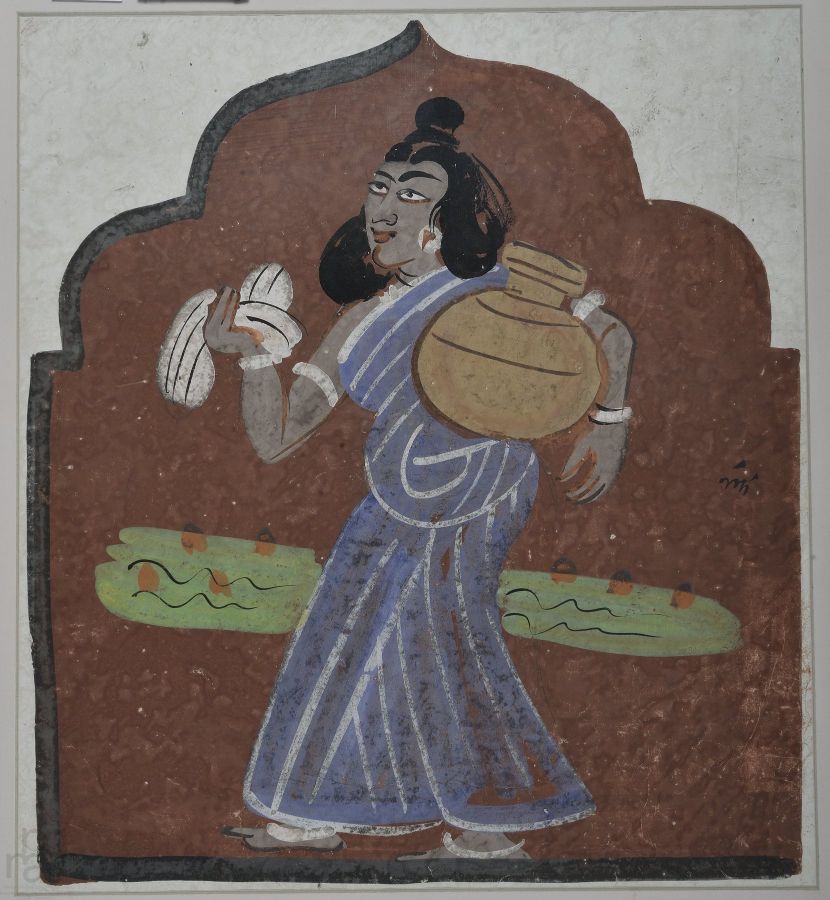 ×Haripura posters by Nandalal capture moments of everyday Indian village life and culture. This poster is one of many examples of acute observation of his surrounding in which he has depicted a woman walking holding an earthen pot and a cloth coming after a bath. The figure have been articulated with earthen colour palette and swift strokes executed in a calligraphic manner that both the styles and subject matter exude the charm and playfulness often found in folk art.
×Haripura posters by Nandalal capture moments of everyday Indian village life and culture. This poster is one of many examples of acute observation of his surrounding in which he has depicted a woman walking holding an earthen pot and a cloth coming after a bath. The figure have been articulated with earthen colour palette and swift strokes executed in a calligraphic manner that both the styles and subject matter exude the charm and playfulness often found in folk art. -
Painting
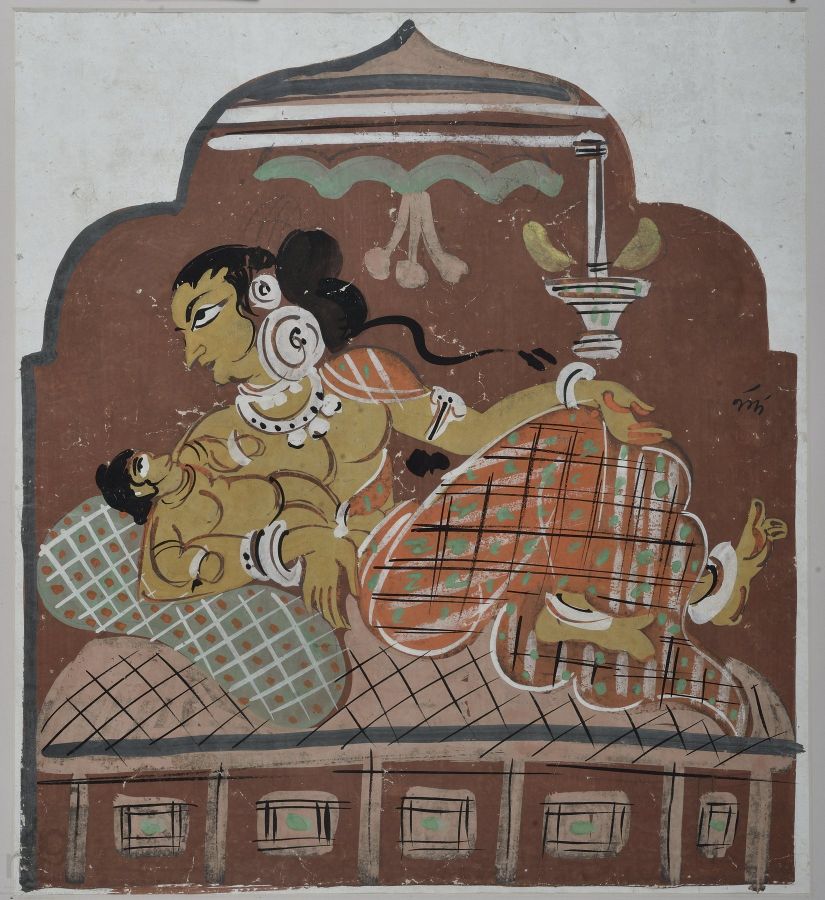 ×"Haripura posters by Nandalal capture moments of everyday Indian village life and culture. In this poster, he has depicted a woman feeding her child lying on a bed. The artist has articulated this picture with earthy colour palette and spontaneous, energetic graphic lines which aptly limn the figure with his personal sensibilities and reflect the affection between a mother and child relationship.
×"Haripura posters by Nandalal capture moments of everyday Indian village life and culture. In this poster, he has depicted a woman feeding her child lying on a bed. The artist has articulated this picture with earthy colour palette and spontaneous, energetic graphic lines which aptly limn the figure with his personal sensibilities and reflect the affection between a mother and child relationship. -
Painting
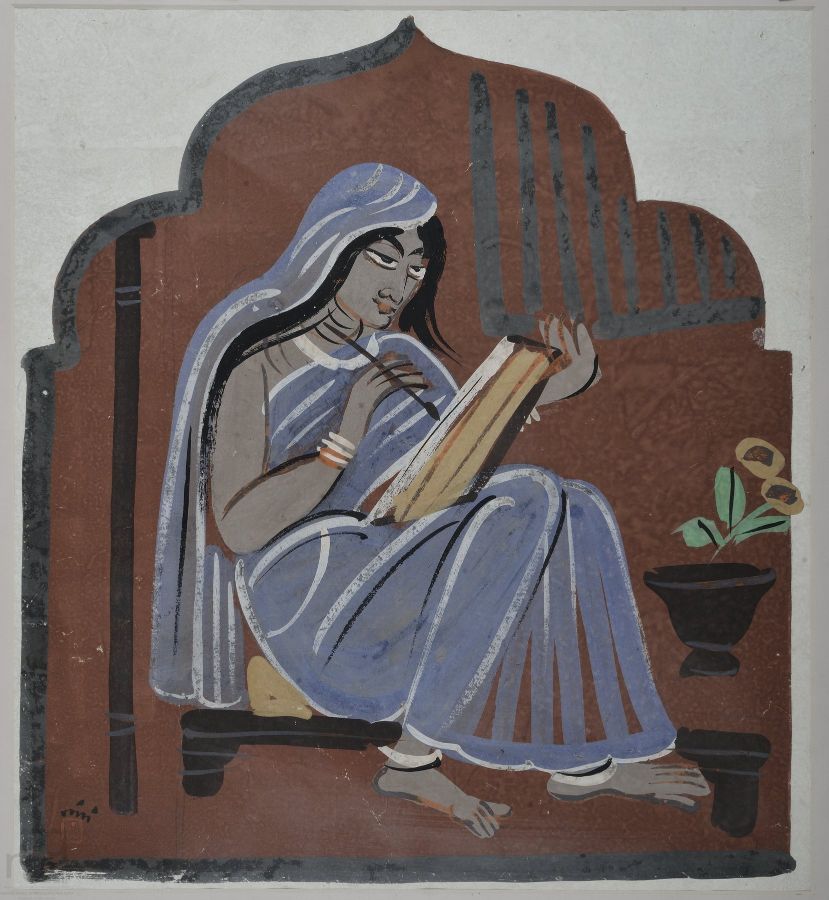 ×Haripura posters by Nandalal captured moments of everyday Indian village life and culture. In these illustrations, the artist evolves his visual language to bring out the rhythm and coherence in his subjects rather than their imitation in formal resemblance. In this poster, he has depicted a Jain warrior sitting with his sword, executed in earthen colors and swift strokes in calligraphic manner reminiscent of Indian folk art.
×Haripura posters by Nandalal captured moments of everyday Indian village life and culture. In these illustrations, the artist evolves his visual language to bring out the rhythm and coherence in his subjects rather than their imitation in formal resemblance. In this poster, he has depicted a Jain warrior sitting with his sword, executed in earthen colors and swift strokes in calligraphic manner reminiscent of Indian folk art. -
Painting
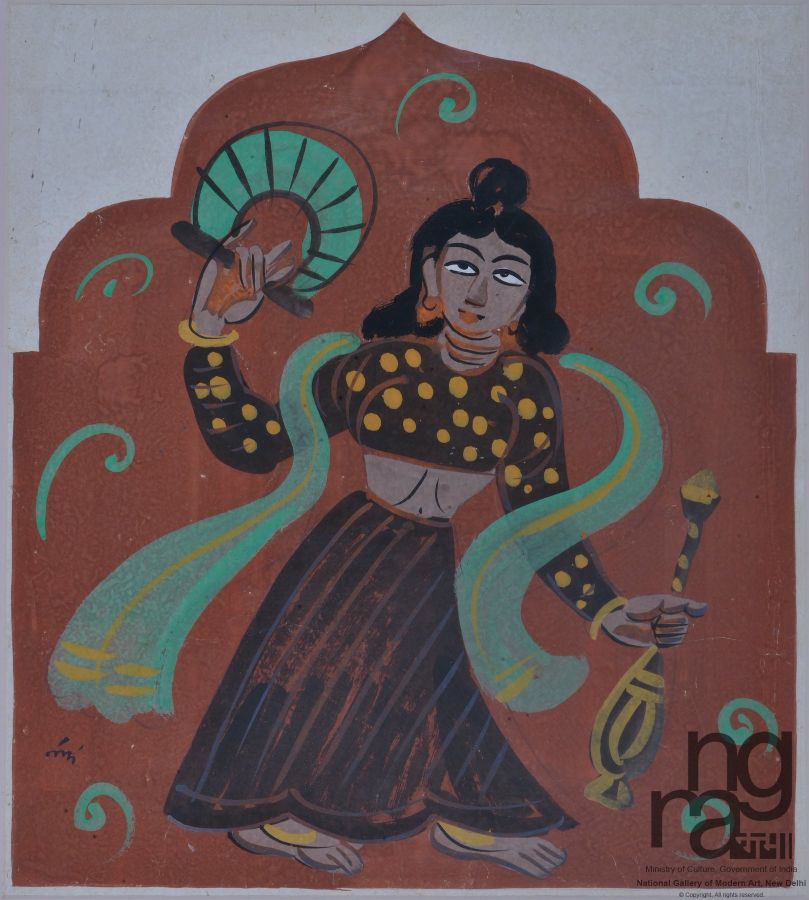 ×Haripura posters by Nandalal captured moments of everyday Indian village life and culture. In these illustrations, the artist evolves his visual language to bring out the rhythm and coherence in his subjects rather than their imitation in formal resemblance. In this poster, he has depicted a Jain warrior sitting with his sword, executed in earthen colors and swift strokes in calligraphic manner reminiscent of Indian folk art.
×Haripura posters by Nandalal captured moments of everyday Indian village life and culture. In these illustrations, the artist evolves his visual language to bring out the rhythm and coherence in his subjects rather than their imitation in formal resemblance. In this poster, he has depicted a Jain warrior sitting with his sword, executed in earthen colors and swift strokes in calligraphic manner reminiscent of Indian folk art. -
Painting
 ×"Haripura posters by Nandalal capture moments of everyday Indian village life and culture. This poster is one of many examples of acute observation of his surrounding in which he has depicted a man sitting on the floor and engaged in an activity of writing. The illustration has been articulated with the earthy colour palette and spontaneous and energetic graphic lines which aptly limn the figure with the artist's personal sensibilities.
×"Haripura posters by Nandalal capture moments of everyday Indian village life and culture. This poster is one of many examples of acute observation of his surrounding in which he has depicted a man sitting on the floor and engaged in an activity of writing. The illustration has been articulated with the earthy colour palette and spontaneous and energetic graphic lines which aptly limn the figure with the artist's personal sensibilities. -
Painting
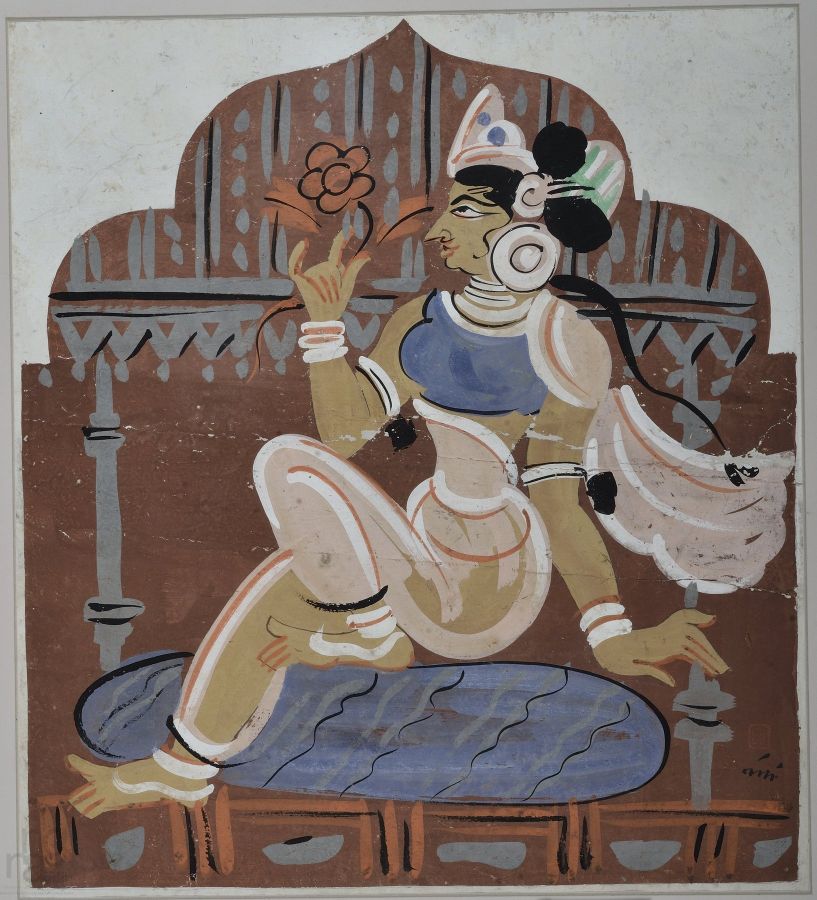 ×"Haripura posters by Nandalal capture moments of everyday Indian village life and culture. In this poster, he has depicted a sensuous figure of a woman sitting and holding a flower waiting for her beloved. The figure is filled with expression of her mood and character, executed with vibrant earthy colours and spontaneous, energetic contouring lines aptly limn the figure with the artist's personal sensibilities toward Indian folk arts.
×"Haripura posters by Nandalal capture moments of everyday Indian village life and culture. In this poster, he has depicted a sensuous figure of a woman sitting and holding a flower waiting for her beloved. The figure is filled with expression of her mood and character, executed with vibrant earthy colours and spontaneous, energetic contouring lines aptly limn the figure with the artist's personal sensibilities toward Indian folk arts. -
Painting
 ×Haripura posters by Nandalal captured moments of everyday Indian village life and culture. In these illustrations, the artist evolves his visual language to bring out the rhythm and coherence in his subjects rather than their imitation in formal resemblance. In this poster, he has depicted a Jain warrior sitting with his sword, executed in earthen colors and swift strokes in calligraphic manner reminiscent of Indian folk art.
×Haripura posters by Nandalal captured moments of everyday Indian village life and culture. In these illustrations, the artist evolves his visual language to bring out the rhythm and coherence in his subjects rather than their imitation in formal resemblance. In this poster, he has depicted a Jain warrior sitting with his sword, executed in earthen colors and swift strokes in calligraphic manner reminiscent of Indian folk art.
-
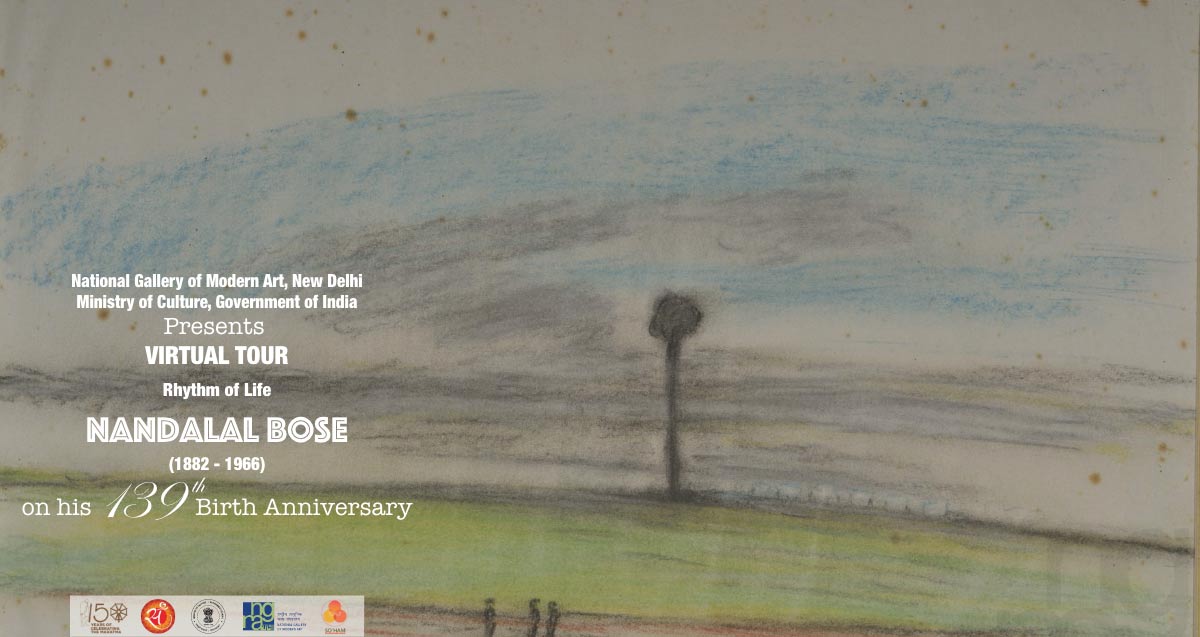 ×
×Concept Note
Virtual Tour
Virtual Tour | Rhythm of Life - Nandalal Bose
The pioneer of modern Indian Art and a key figure of Contextual Modernism.
The Virtual Tour titled “Rhythm of Life : Nandalal Bose” is organized to commemorate the 139th Birth Anniversary of Nandalal Bose on 3rd December 2020. Nandalal is known to have fervently sketched on postcard sized papers mostly using ink and brush, recording his surroundings. The compositions are rendered with linear, soft brush strokes delineating the cheerful forms and suggesting the demeanour of the subject. National Gallery of Modern Art, New Delhi acquired the largest collection of 6744 artworks of Nandalal Bose from his family some of which were exhibited in the Centenary celebratory exhibition organised by the museum in the year 1983. A major portion of the museum's collection includes monochromatic pencil sketches, pen and ink drawings on postcard and paper, watercolour paintings and sketches apart from the more detailed and elaborate tempera and wash paintings, Haripura posters and prints from the artist's extensive oeuvre. This virtual tour presents the 150 works of art from the prominent artworks of Nandalal Bose from reserve collection of NGMA, grouped in a series of four different themes of (i) Haripura Posters, (ii) Flow of Life, (iii) Monochrome and (iv) Transcendental. This virtual tour also showcases artists creation on Post Cards from the collection of NGMA containing 175 works of art. I take pride of the tireless effort of our entire IT Cell to conceive and conceptualize the idea of launching a series of Virtual Tours and designed and developed the same during this pandemic period to facilitate our esteemed visitors with the prestigious collection of NGMA. Adwaita Charan Gadanayak
Director General, NGMA -
Painting
 ×Nandalal had a strong affinity for sketching, his subjects being the surrounding environs, people in their everyday life or anything that he found fascinating. In the above painting the artist has depicted a woman as she sensuously plays with her hair. Like most of Nandalal's later wash paintings this too focuses on a single figure with elongated limbs and a face with sharp features and drowsy eyes. The figure is rendered with clearly defined contour lines filled with colours bringing about a corporeality of form.
×Nandalal had a strong affinity for sketching, his subjects being the surrounding environs, people in their everyday life or anything that he found fascinating. In the above painting the artist has depicted a woman as she sensuously plays with her hair. Like most of Nandalal's later wash paintings this too focuses on a single figure with elongated limbs and a face with sharp features and drowsy eyes. The figure is rendered with clearly defined contour lines filled with colours bringing about a corporeality of form. -
Painting
 ×Nandalal had a strong affinity for sketching, his subjects being the surrounding environs, people in their everyday life or anything that he found fascinating. In this painting, he has depicted Lord Krishna with Radha and two Gopies going for boating. Rendered with the use of colours in tonal variation, delineating the contours of the figures and adding depth to the composition.
×Nandalal had a strong affinity for sketching, his subjects being the surrounding environs, people in their everyday life or anything that he found fascinating. In this painting, he has depicted Lord Krishna with Radha and two Gopies going for boating. Rendered with the use of colours in tonal variation, delineating the contours of the figures and adding depth to the composition. -
Painting
 ×Nandalal is known to have fervently sketched on postcard sized papers mostly using ink and brush, recording his surroundings. The above sketch by the artist depicts a woman planting coconut palms in the field. The composition is rendered with fluid, soft brush strokes delineating the contours of her body and suggesting the demeanour of the subject.
×Nandalal is known to have fervently sketched on postcard sized papers mostly using ink and brush, recording his surroundings. The above sketch by the artist depicts a woman planting coconut palms in the field. The composition is rendered with fluid, soft brush strokes delineating the contours of her body and suggesting the demeanour of the subject. -
Painting
 ×Nandalal had a strong affinity for sketching and drawing, instantly recording in the postcard sized papers his subjects from the surrounding environs, people in their everyday life, or anything he found fascinating. In this painting, he has depicted a woman hiding behind a trunk of a tree against the background of orange- red, rendered with shades of flat color in tonal variation delineating the forms.
×Nandalal had a strong affinity for sketching and drawing, instantly recording in the postcard sized papers his subjects from the surrounding environs, people in their everyday life, or anything he found fascinating. In this painting, he has depicted a woman hiding behind a trunk of a tree against the background of orange- red, rendered with shades of flat color in tonal variation delineating the forms. -
Painting
 ×Nandalal had a strong affinity for sketching, his subjects being the surrounding environs, people in their everyday life or anything that he found fascinating. In this painting, he has depicted a woman sitting in the veranda and reading book, besides her is a tree of ‘Krisnachura Flower’ (referring to the type of flower of spring). Rendered with the use of colours in tonal variation, delineating the contours and adding depth to the composition.
×Nandalal had a strong affinity for sketching, his subjects being the surrounding environs, people in their everyday life or anything that he found fascinating. In this painting, he has depicted a woman sitting in the veranda and reading book, besides her is a tree of ‘Krisnachura Flower’ (referring to the type of flower of spring). Rendered with the use of colours in tonal variation, delineating the contours and adding depth to the composition. -
Painting
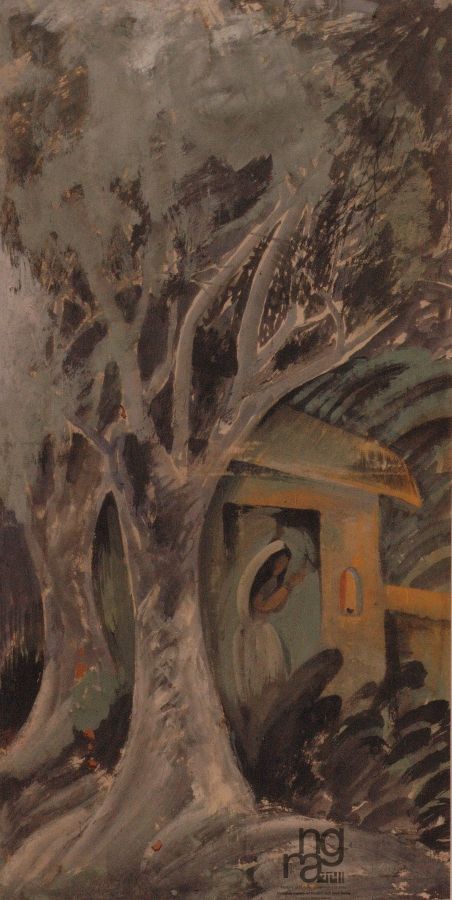 ×Nandalal's work reflected changing landscapes, portraits of people, sketches from life and places at the time of changing outlook in the modern Indian cultural domain. His nature to explore the various materials and mediums allowed him to make a prolific body of work in different mediums. Along with the techniques of art he imbibed from the European indigenous tradition and the Japanese wash technique, he also explored the art of Rabindranath Tagore, Abnindranath, who was his teacher. Thus the techniques of their art also reflect in Nandalal's visual expressions. This work depicts the Autumn season with the lady praying at the evening lamp.
×Nandalal's work reflected changing landscapes, portraits of people, sketches from life and places at the time of changing outlook in the modern Indian cultural domain. His nature to explore the various materials and mediums allowed him to make a prolific body of work in different mediums. Along with the techniques of art he imbibed from the European indigenous tradition and the Japanese wash technique, he also explored the art of Rabindranath Tagore, Abnindranath, who was his teacher. Thus the techniques of their art also reflect in Nandalal's visual expressions. This work depicts the Autumn season with the lady praying at the evening lamp. -
Painting
 ×Nandalal's work reflected changing landscapes, portraits of people, sketches from life and places at the time of changing outlook in the modern Indian cultural domain. His nature to explore the various materials and mediums allowed him to make a prolific body of work in different mediums. Along with the techniques of art he imbibed from the European indigenous tradition and the Japanese wash technique, he also explored the art of Rabindranath Tagore, Abnindranath, who was his teacher. Thus the techniques of their art also reflect in Nandalal's visual expressions. This painting is a study of a Lotus done in the wash technique.
×Nandalal's work reflected changing landscapes, portraits of people, sketches from life and places at the time of changing outlook in the modern Indian cultural domain. His nature to explore the various materials and mediums allowed him to make a prolific body of work in different mediums. Along with the techniques of art he imbibed from the European indigenous tradition and the Japanese wash technique, he also explored the art of Rabindranath Tagore, Abnindranath, who was his teacher. Thus the techniques of their art also reflect in Nandalal's visual expressions. This painting is a study of a Lotus done in the wash technique. -
Painting
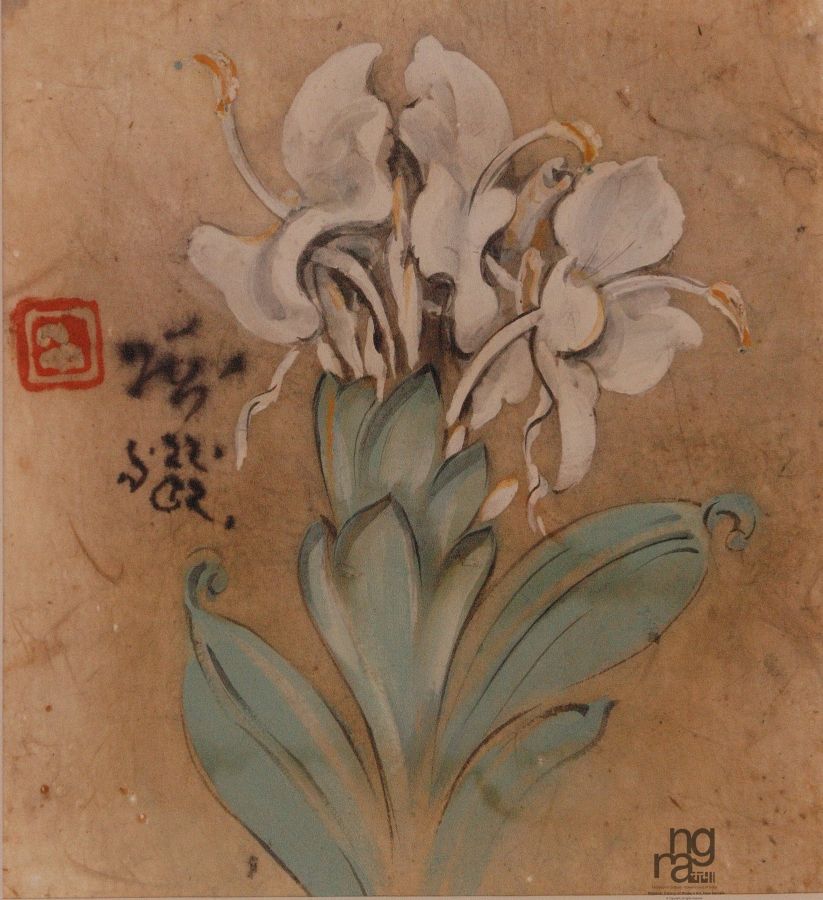 ×Nandalal's work reflected changing landscapes, portraits of people, sketches from life, nature sketches and places at the time of changing outlook in the modern Indian cultural domain. His nature to explore the various materials and mediums allowed him to make a prolific body of work in different mediums. The study of this Dolan Champa flower is one of his works.
×Nandalal's work reflected changing landscapes, portraits of people, sketches from life, nature sketches and places at the time of changing outlook in the modern Indian cultural domain. His nature to explore the various materials and mediums allowed him to make a prolific body of work in different mediums. The study of this Dolan Champa flower is one of his works. -
Painting
 ×The painting details out a beautiful summer landscape. Nandalal Bose was inspired by the traditional Indian art history, the miniatures and the folk art traditions, which reflects in his work at many junctures.
×The painting details out a beautiful summer landscape. Nandalal Bose was inspired by the traditional Indian art history, the miniatures and the folk art traditions, which reflects in his work at many junctures. -
Painting
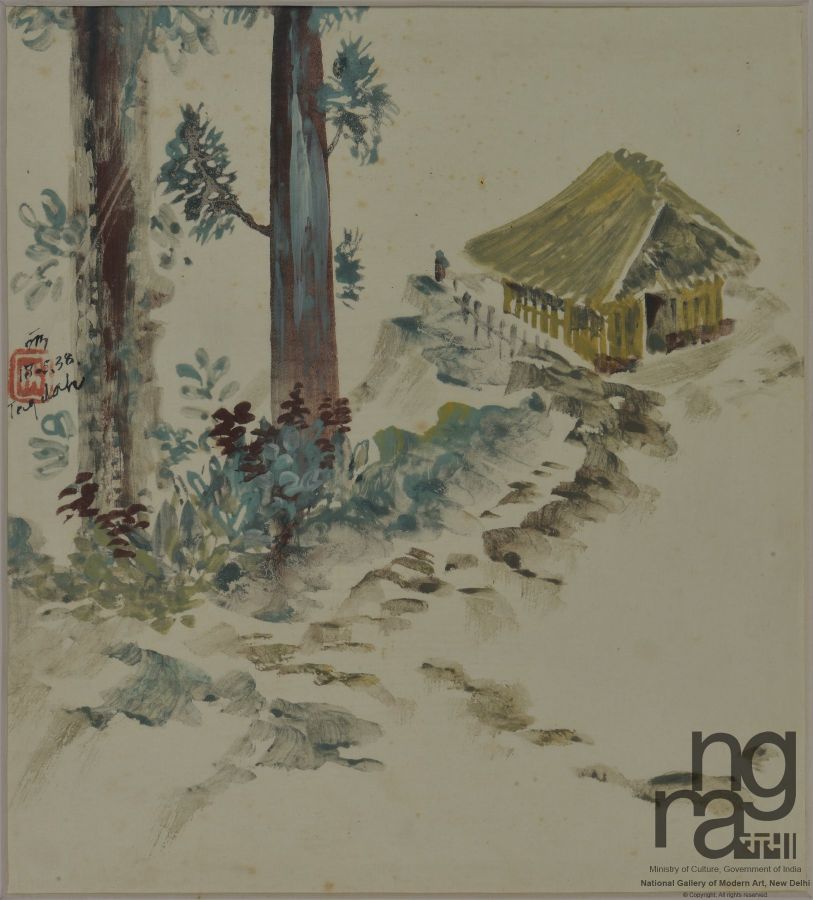 ×In this postcard sketch, Nandalal has depicted a landscape with a hut and tress. The sketch has been swiftly executed in swift, loose brush strokes that suggest the depth and light in the composition, sparing much detail in the image.
×In this postcard sketch, Nandalal has depicted a landscape with a hut and tress. The sketch has been swiftly executed in swift, loose brush strokes that suggest the depth and light in the composition, sparing much detail in the image. -
Painting
 ×Fascinated by the folk art and indigenous modes of expression, Nandalal Bose incorporated these themes in his work with a unique stylized form in his representations and narratives of the local life. His work reflected changing landscapes, portraits of people, sketches from life and places at the time of changing outlook in the modern Indian cultural domain. His nature to explore the various materials and mediums allowed him to make a prolific body of work in different mediums. This painting in watercolors depicts the very indigenous theme where the Santhal people are shown dancing during the harvest season.
×Fascinated by the folk art and indigenous modes of expression, Nandalal Bose incorporated these themes in his work with a unique stylized form in his representations and narratives of the local life. His work reflected changing landscapes, portraits of people, sketches from life and places at the time of changing outlook in the modern Indian cultural domain. His nature to explore the various materials and mediums allowed him to make a prolific body of work in different mediums. This painting in watercolors depicts the very indigenous theme where the Santhal people are shown dancing during the harvest season. -
Painting
 ×Nandalal had a strong affinity for sketching, his subjects being the surrounding environs, people in their everyday life or anything that he found fascinating. In this painting, he has depicted a woman sitting outside a hut and holding a flower, probably waiting for someone. This has been rendered with the use of colours in tonal variation, delineating the contours of the figure and adding depth to the composition.
×Nandalal had a strong affinity for sketching, his subjects being the surrounding environs, people in their everyday life or anything that he found fascinating. In this painting, he has depicted a woman sitting outside a hut and holding a flower, probably waiting for someone. This has been rendered with the use of colours in tonal variation, delineating the contours of the figure and adding depth to the composition. -
Painting

Santhals Acc. No. 5072 | Linocut Print
-
Print
 ×Nandalal preferred drawing from life, often sketching outdoors with the subject being life, nature studies, landscapes, figure drawings and animals. He also experimented with printmaking in his long artistic career. In the above print the artist depicts two women standing on the door, rendered with thin lines incised on a copper plate and imprinted on a plain surface with the use of black ink.
×Nandalal preferred drawing from life, often sketching outdoors with the subject being life, nature studies, landscapes, figure drawings and animals. He also experimented with printmaking in his long artistic career. In the above print the artist depicts two women standing on the door, rendered with thin lines incised on a copper plate and imprinted on a plain surface with the use of black ink.
The firm yet fluid lines, articulate the elongated structures of the women and suggest their demeanour. -
Print
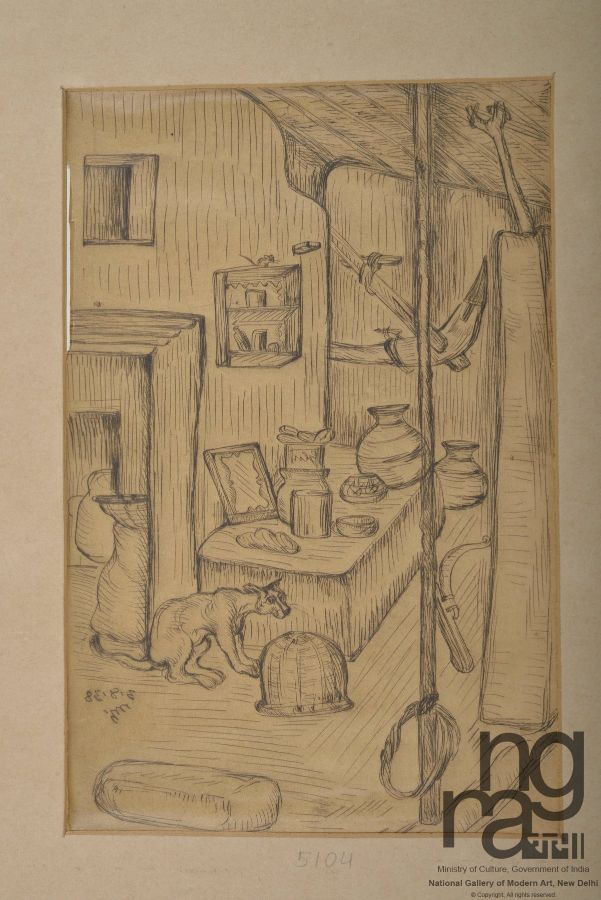 ×Nandalal preferred drawing from life, often sketching outdoors with the subject being life, nature studies, landscapes, figure drawings and animals. In the above print the artist depicts the inside of a farmer’s hut, rendered with sharp, thin lines incised in a copper plate and transferred on the plain surface with the use of black ink. The fluid, fine strokes delineating the form, add grace to the composition.
×Nandalal preferred drawing from life, often sketching outdoors with the subject being life, nature studies, landscapes, figure drawings and animals. In the above print the artist depicts the inside of a farmer’s hut, rendered with sharp, thin lines incised in a copper plate and transferred on the plain surface with the use of black ink. The fluid, fine strokes delineating the form, add grace to the composition. -
Print
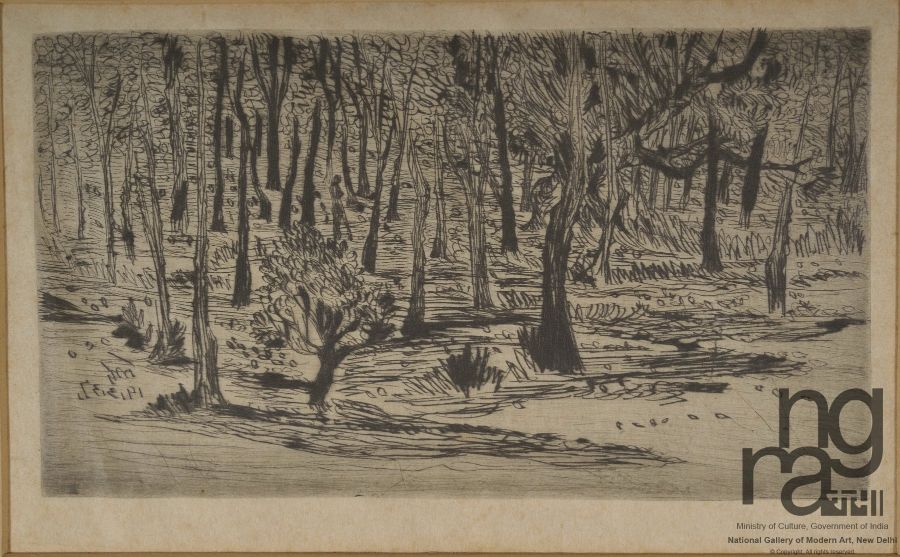 ×Nandalal preferred drawing from life, often sketching outdoors with the subject being life, nature studies, landscapes, figure drawings and animals. He also experimented with printmaking in his long artistic career. In the above print the artist depicts a Saal forest, rendered with sharp, thin lines incised in a copper plate and transferred on the plain surface with the use of black ink. The incised lines, articulate the stiff contours of the Saal trees and adds vigour to the composition.
×Nandalal preferred drawing from life, often sketching outdoors with the subject being life, nature studies, landscapes, figure drawings and animals. He also experimented with printmaking in his long artistic career. In the above print the artist depicts a Saal forest, rendered with sharp, thin lines incised in a copper plate and transferred on the plain surface with the use of black ink. The incised lines, articulate the stiff contours of the Saal trees and adds vigour to the composition. -
Print
 ×Nandalal preferred drawing from life, often sketching outdoors with the subject being life, nature studies, landscapes, figure drawings and animals. He also experimented with printmaking in his long artistic career. In the above print the artist depicts a mango grove, rendered with sharp, thin lines incised in a copper plate and transferred on the plain surface with the use of black ink. The incised lines, articulate the stiff contours of the mango trees and adds vigour to the composition.
×Nandalal preferred drawing from life, often sketching outdoors with the subject being life, nature studies, landscapes, figure drawings and animals. He also experimented with printmaking in his long artistic career. In the above print the artist depicts a mango grove, rendered with sharp, thin lines incised in a copper plate and transferred on the plain surface with the use of black ink. The incised lines, articulate the stiff contours of the mango trees and adds vigour to the composition. -
Print
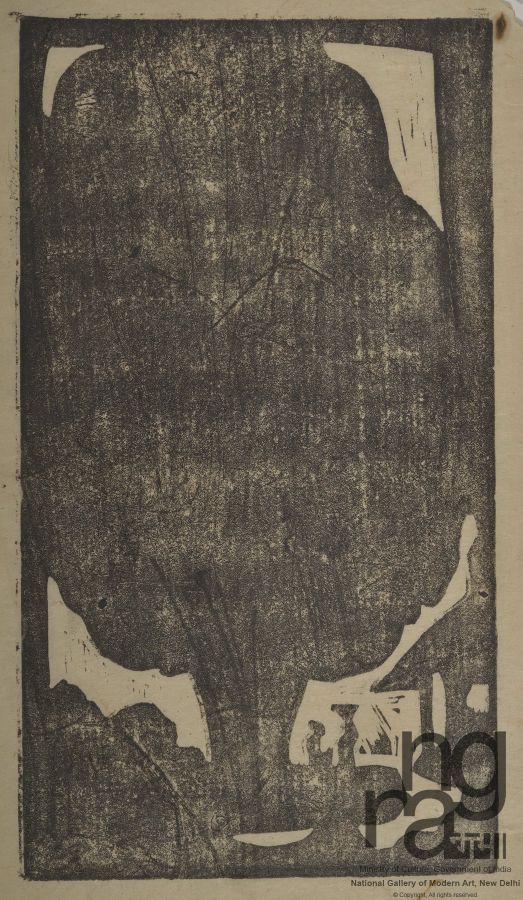 ×Nandalal explored a wide range of traditions to arrive at his unique visual language and has left behind a large corpus of works in a wide variety of styles, expressions and techniques. In this particular bold lino cut illustration the artist depicts a landscape with a tree in the foreground and two human figures sitting under the tree and a hut in the background, by using negative positive space, sparing much detail.
×Nandalal explored a wide range of traditions to arrive at his unique visual language and has left behind a large corpus of works in a wide variety of styles, expressions and techniques. In this particular bold lino cut illustration the artist depicts a landscape with a tree in the foreground and two human figures sitting under the tree and a hut in the background, by using negative positive space, sparing much detail. -
Painting
 ×Nandalal preferred drawing from life, often sketching outdoors with the subject being life, nature studies, landscapes, figure drawings and animals. In this particular painting, Nandalal has depicted two deer striding through the dense forest rendered with bold, linear ink strokes articulating the contours of the deer and trees while adding vigour to the composition.
×Nandalal preferred drawing from life, often sketching outdoors with the subject being life, nature studies, landscapes, figure drawings and animals. In this particular painting, Nandalal has depicted two deer striding through the dense forest rendered with bold, linear ink strokes articulating the contours of the deer and trees while adding vigour to the composition. -
Painting
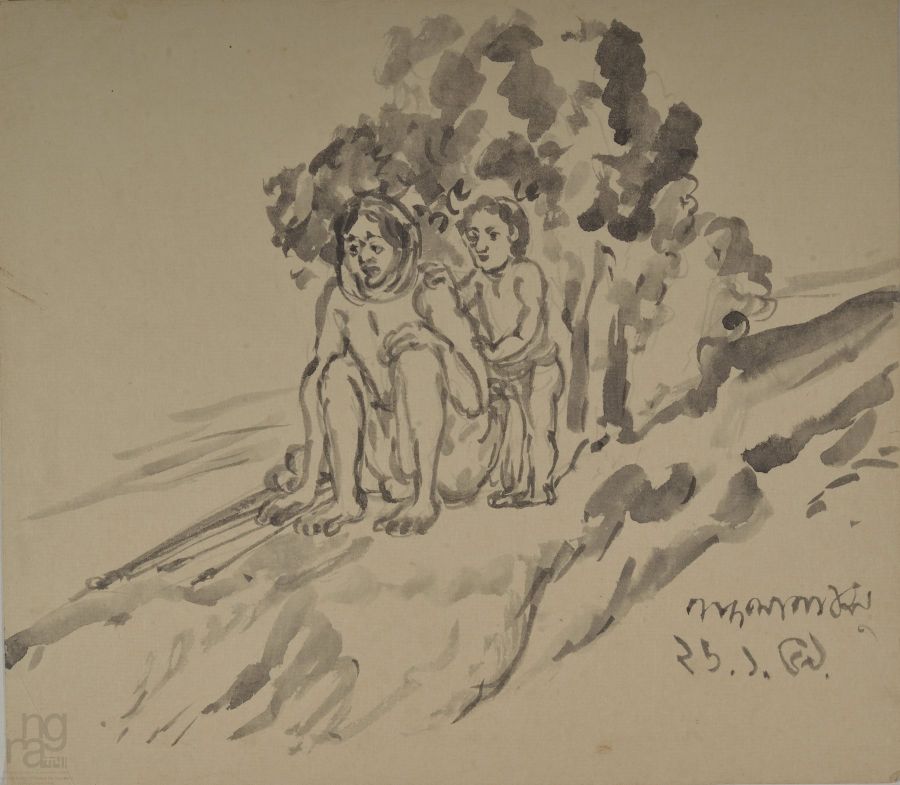 ×This painting belongs to a series of monochromatic ink and watercolour paintings inspired by the Sumi-e Japanese technique the artist employed in the last phase of his life. These compositions were stripped to the bare minimum where only a few strokes of ink were employed to create natural forms in an effortless approach. In this sketch, Nandalal has executed a mother and child and trees in the background, with a range of strokes in tonal variations capturing the rhythm and pattern in the image. This painting was purchased from the collection of Shri Biswaroop.
×This painting belongs to a series of monochromatic ink and watercolour paintings inspired by the Sumi-e Japanese technique the artist employed in the last phase of his life. These compositions were stripped to the bare minimum where only a few strokes of ink were employed to create natural forms in an effortless approach. In this sketch, Nandalal has executed a mother and child and trees in the background, with a range of strokes in tonal variations capturing the rhythm and pattern in the image. This painting was purchased from the collection of Shri Biswaroop. -
Painting
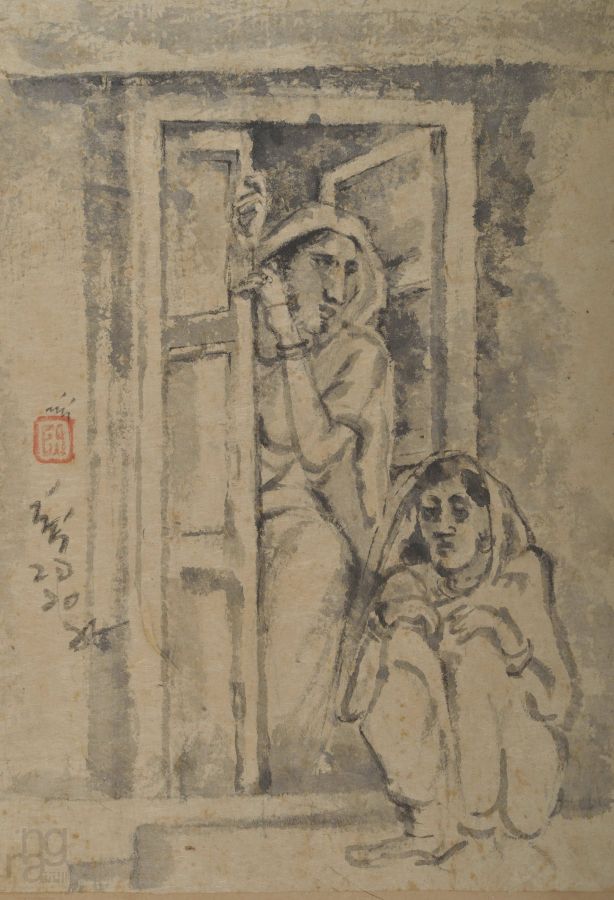 ×This painting belongs to a series of monochromatic ink and watercolour paintings inspired by the Sumi-e Japanese technique the artist employed in the last phase of his life. These compositions were stripped to the bare minimum where only a few strokes of ink were employed to create natural forms in an effortless approach. The above painting belongs to the 'Two Ladies at the Door' series. The artist has executed two ladies, one standing at the door and the other lady sitting at the corner of the door, with a range of strokes in tonal variations capturing the rhythm and pattern of the image. This painting was purchased from the collection of Shri Biswaroop Bose and Smt. Nivedita Bose, children of Nandalal Bose.
×This painting belongs to a series of monochromatic ink and watercolour paintings inspired by the Sumi-e Japanese technique the artist employed in the last phase of his life. These compositions were stripped to the bare minimum where only a few strokes of ink were employed to create natural forms in an effortless approach. The above painting belongs to the 'Two Ladies at the Door' series. The artist has executed two ladies, one standing at the door and the other lady sitting at the corner of the door, with a range of strokes in tonal variations capturing the rhythm and pattern of the image. This painting was purchased from the collection of Shri Biswaroop Bose and Smt. Nivedita Bose, children of Nandalal Bose. -
Painting
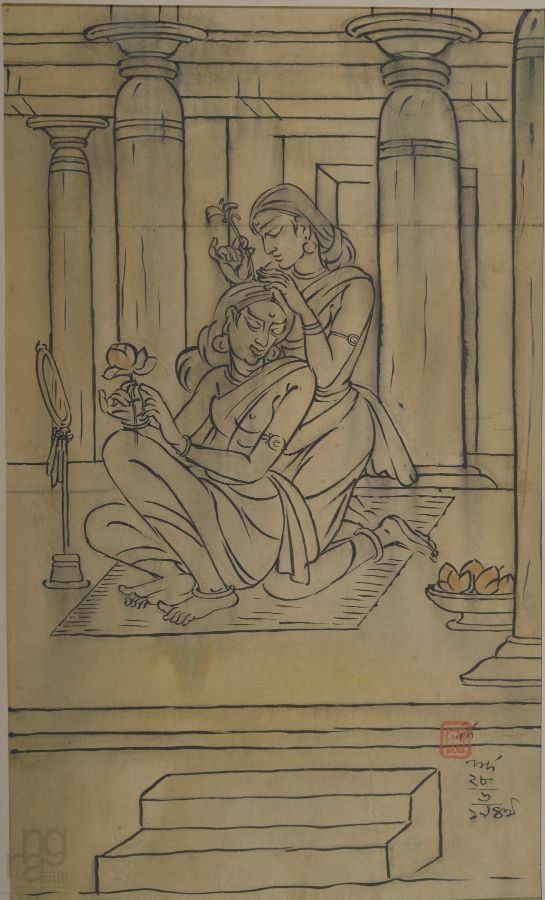 ×This sketch by Nandalal depicts two women, caught in an intimate moment by the artist. He uses sharp, curvilinear strokes to delineate their figures and subtle touches to convey their facial expressions in an easy, delicate manner.
×This sketch by Nandalal depicts two women, caught in an intimate moment by the artist. He uses sharp, curvilinear strokes to delineate their figures and subtle touches to convey their facial expressions in an easy, delicate manner. -
Painting
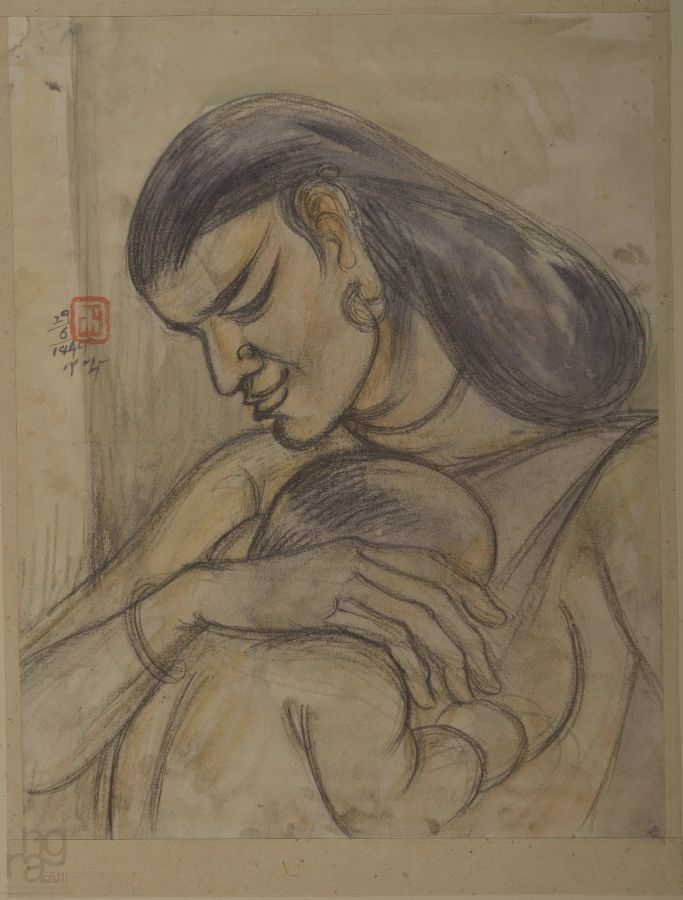 ×Nandalal preferred drawing from life, often sketching outdoors with the subject being life, nature studies, landscapes, figure drawings, animals and birds or anything that he found fascinating. In his pencil sketches he has experimented with the use of lines to add texture, vigour and life to his sketches. This sketch is a rendition of a woman, feeding her child, rendered in dark pencil and brush strokes that suggest the modelling of the body highlighting the facial features of the figure.
×Nandalal preferred drawing from life, often sketching outdoors with the subject being life, nature studies, landscapes, figure drawings, animals and birds or anything that he found fascinating. In his pencil sketches he has experimented with the use of lines to add texture, vigour and life to his sketches. This sketch is a rendition of a woman, feeding her child, rendered in dark pencil and brush strokes that suggest the modelling of the body highlighting the facial features of the figure. -
Painting
 ×Nandalal had a strong affinity for sketching, his subjects being the surrounding environs, people in their everyday life or anything that he found fascinating. The above illustration by the artist is a perceptible representation of the cover of one of the art journals of Sri lanka named 'Ceylon Observer'. The sketch depicts a meeting of a Sinhalese and a Bengali girl, rendered with linear, continuous coloured strokes delineating the delicate structures and suggesting their demeanours.
×Nandalal had a strong affinity for sketching, his subjects being the surrounding environs, people in their everyday life or anything that he found fascinating. The above illustration by the artist is a perceptible representation of the cover of one of the art journals of Sri lanka named 'Ceylon Observer'. The sketch depicts a meeting of a Sinhalese and a Bengali girl, rendered with linear, continuous coloured strokes delineating the delicate structures and suggesting their demeanours. -
Painting
 ×Nandalal preferred drawing from life, often sketching outdoors with the subjects being life, nature studies, landscapes, figure drawings and animals. In the above sketch the artist has depicted a man wearing a dhoti and standing with a stick on a hilly terrain, against a bucolic scenery. The composition is rendered with dabs and dashes of colours articulating the contours of the man and suggesting his demeanour.
×Nandalal preferred drawing from life, often sketching outdoors with the subjects being life, nature studies, landscapes, figure drawings and animals. In the above sketch the artist has depicted a man wearing a dhoti and standing with a stick on a hilly terrain, against a bucolic scenery. The composition is rendered with dabs and dashes of colours articulating the contours of the man and suggesting his demeanour. -
Painting
 ×Nandalal had a strong affinity for sketching, his subjects being the surrounding environs, people in their everyday life or anything that he found fascinating. In this painting, he has depicted a scene of an ‘Ashram’ where one woman is seen carrying a basket, other women sitting under the tree and a donkey standing in the foreground. Rendered with the use of colours in tonal variation, delineating the contours of the forms and adding depth to the composition.
×Nandalal had a strong affinity for sketching, his subjects being the surrounding environs, people in their everyday life or anything that he found fascinating. In this painting, he has depicted a scene of an ‘Ashram’ where one woman is seen carrying a basket, other women sitting under the tree and a donkey standing in the foreground. Rendered with the use of colours in tonal variation, delineating the contours of the forms and adding depth to the composition. -
Painting
 ×Nandalal has here rendered a view of Darjeeling fog, in monochromatic style with black ink, emphasising on its tonal variations. He has painted in deep tints of black, the distinctive shape of the clouds and used grey patches to give an impression of the fog and mist.
×Nandalal has here rendered a view of Darjeeling fog, in monochromatic style with black ink, emphasising on its tonal variations. He has painted in deep tints of black, the distinctive shape of the clouds and used grey patches to give an impression of the fog and mist.
-
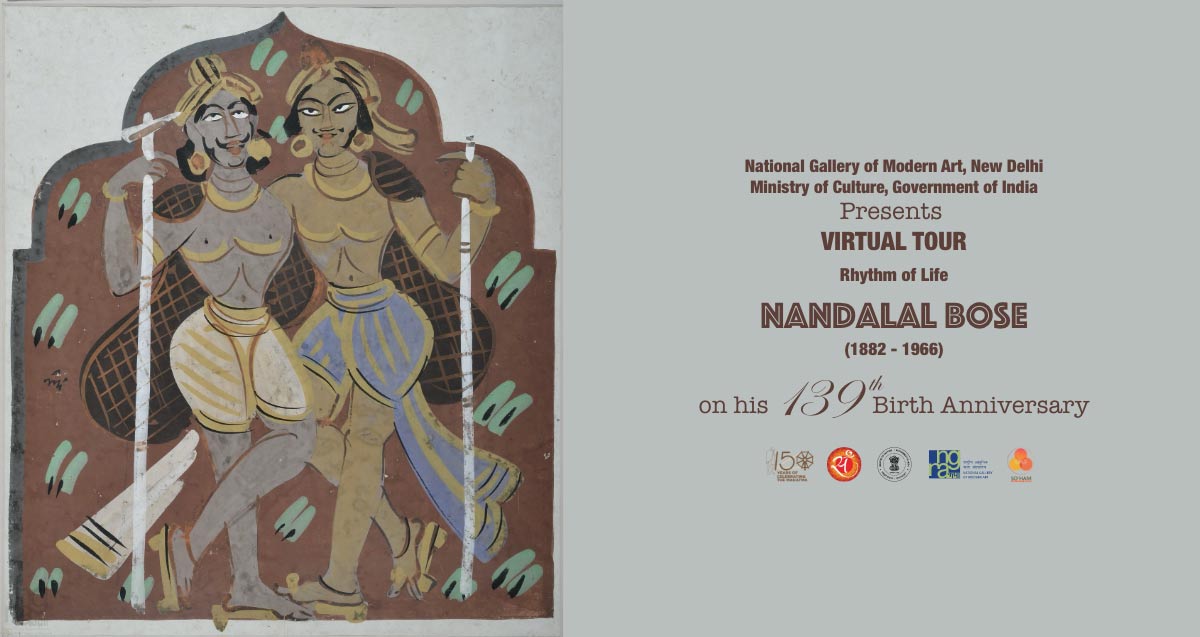 ×
×Concept Note
Virtual Tour
Virtual Tour | Rhythm of Life - Nandalal Bose
The pioneer of modern Indian Art and a key figure of Contextual Modernism.
The Virtual Tour titled “Rhythm of Life : Nandalal Bose” is organized to commemorate the 139th Birth Anniversary of Nandalal Bose on 3rd December 2020. Nandalal is known to have fervently sketched on postcard sized papers mostly using ink and brush, recording his surroundings. The compositions are rendered with linear, soft brush strokes delineating the cheerful forms and suggesting the demeanour of the subject. National Gallery of Modern Art, New Delhi acquired the largest collection of 6744 artworks of Nandalal Bose from his family some of which were exhibited in the Centenary celebratory exhibition organised by the museum in the year 1983. A major portion of the museum's collection includes monochromatic pencil sketches, pen and ink drawings on postcard and paper, watercolour paintings and sketches apart from the more detailed and elaborate tempera and wash paintings, Haripura posters and prints from the artist's extensive oeuvre. This virtual tour presents the 150 works of art from the prominent artworks of Nandalal Bose from reserve collection of NGMA, grouped in a series of four different themes of (i) Haripura Posters, (ii) Flow of Life, (iii) Monochrome and (iv) Transcendental. This virtual tour also showcases artists creation on Post Cards from the collection of NGMA containing 175 works of art. I take pride of the tireless effort of our entire IT Cell to conceive and conceptualize the idea of launching a series of Virtual Tours and designed and developed the same during this pandemic period to facilitate our esteemed visitors with the prestigious collection of NGMA. Adwaita Charan Gadanayak
Director General, NGMA -
Painting
 ×This painting belongs to a series of monochromatic ink and watercolour paintings inspired by the Sumi-e Japanese technique the artist employed in the last phase of his life. These compositions were stripped to the bare minimum where only a few strokes of ink were employed to create natural forms in an effortless approach. The above painting belongs to the 'Peacock' series. The artist has executed two peacocks standing on stones surrounded by cluster of trees, with a range of strokes in tonal variations capturing the rhythm and pattern of the image. This painting was purchased from the collection of Shri Biswaroop Bose and Smt. Nivedita Bose, children of Nandalal
×This painting belongs to a series of monochromatic ink and watercolour paintings inspired by the Sumi-e Japanese technique the artist employed in the last phase of his life. These compositions were stripped to the bare minimum where only a few strokes of ink were employed to create natural forms in an effortless approach. The above painting belongs to the 'Peacock' series. The artist has executed two peacocks standing on stones surrounded by cluster of trees, with a range of strokes in tonal variations capturing the rhythm and pattern of the image. This painting was purchased from the collection of Shri Biswaroop Bose and Smt. Nivedita Bose, children of Nandalal -
Painting
 ×This painting belongs to a series of monochromatic ink and watercolour paintings inspired by the Sumi-e Japanese technique the artist employed. These compositions were stripped to the bare minimum where only a few strokes of ink were employed to create natural forms in an effortless approach. The artist has executed hillock in Santiniketan, with a range of strokes in tonal variations capturing the rhythm and pattern of the image. This painting was purchased from the collection of Shri Biswaroop Bose and Smt. Nivedita Bose, children of Nandalal
×This painting belongs to a series of monochromatic ink and watercolour paintings inspired by the Sumi-e Japanese technique the artist employed. These compositions were stripped to the bare minimum where only a few strokes of ink were employed to create natural forms in an effortless approach. The artist has executed hillock in Santiniketan, with a range of strokes in tonal variations capturing the rhythm and pattern of the image. This painting was purchased from the collection of Shri Biswaroop Bose and Smt. Nivedita Bose, children of Nandalal -
Painting
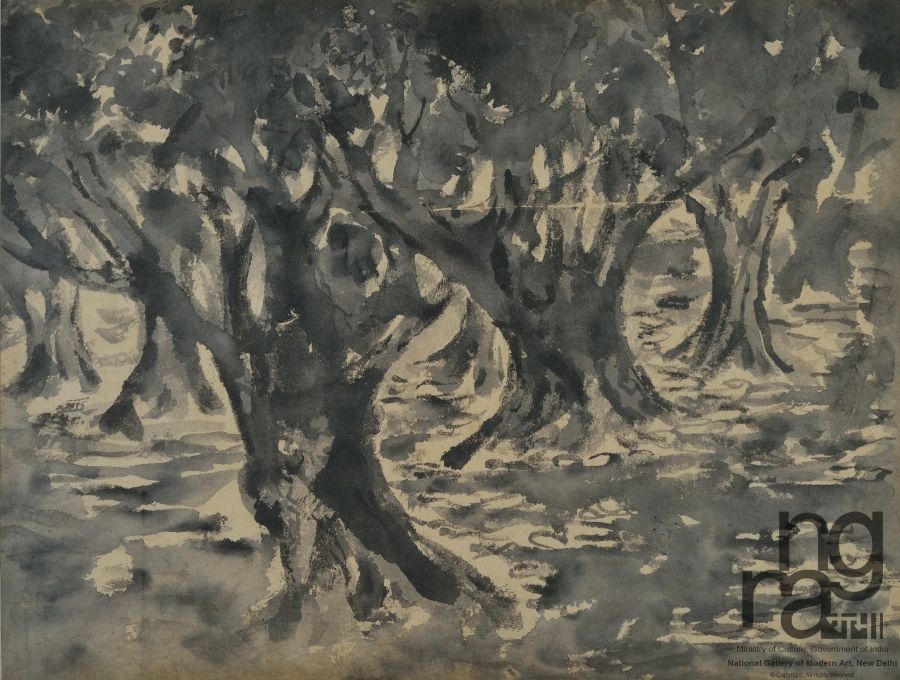 ×This painting belongs to a series of monochromatic ink and watercolour paintings inspired by the Sumi-e Japanese technique the artist employed. These compositions were stripped to the bare minimum where only a few strokes of ink were employed to create natural forms in an effortless approach. The artist has executed Mango grove in Santiniketan, with a range of strokes in tonal variations capturing the rhythm and pattern of the image. This painting was purchased from the collection of Shri Biswaroop Bose and Smt. Nivedita Bose, children of Nandalal
×This painting belongs to a series of monochromatic ink and watercolour paintings inspired by the Sumi-e Japanese technique the artist employed. These compositions were stripped to the bare minimum where only a few strokes of ink were employed to create natural forms in an effortless approach. The artist has executed Mango grove in Santiniketan, with a range of strokes in tonal variations capturing the rhythm and pattern of the image. This painting was purchased from the collection of Shri Biswaroop Bose and Smt. Nivedita Bose, children of Nandalal -
Painting
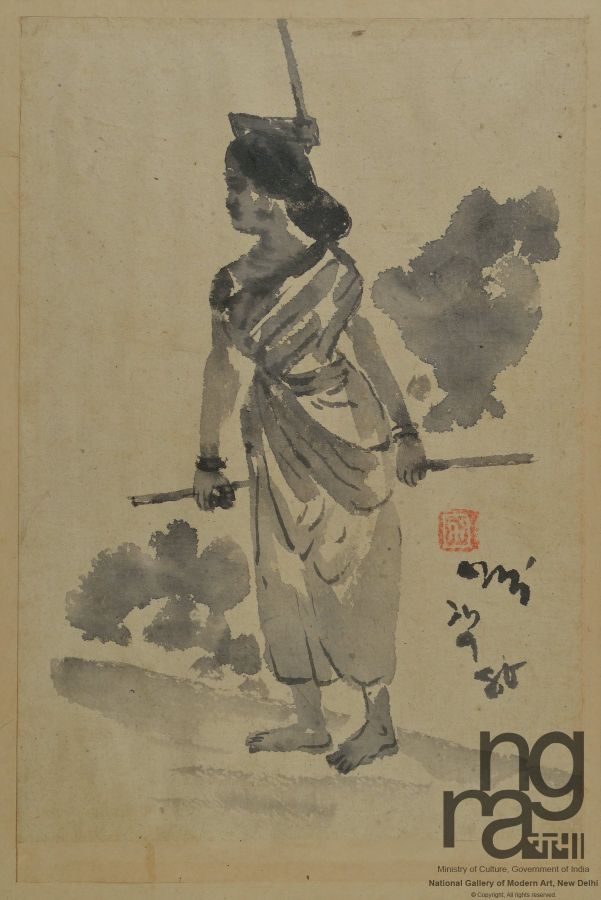 ×This painting belongs to a series of monochromatic ink and watercolour paintings inspired by the Sumi-e Japanese technique the artist employed. These compositions were stripped to the bare minimum where only a few strokes of ink were employed to create natural forms in an effortless approach. The artist has executed a Santhal woman, with a range of strokes in tonal variations capturing the rhythm and pattern of the image. This painting was purchased from the collection of Shri Biswaroop Bose and Smt. Nivedita Bose, children of Nandalal Bose.
×This painting belongs to a series of monochromatic ink and watercolour paintings inspired by the Sumi-e Japanese technique the artist employed. These compositions were stripped to the bare minimum where only a few strokes of ink were employed to create natural forms in an effortless approach. The artist has executed a Santhal woman, with a range of strokes in tonal variations capturing the rhythm and pattern of the image. This painting was purchased from the collection of Shri Biswaroop Bose and Smt. Nivedita Bose, children of Nandalal Bose. -
Painting
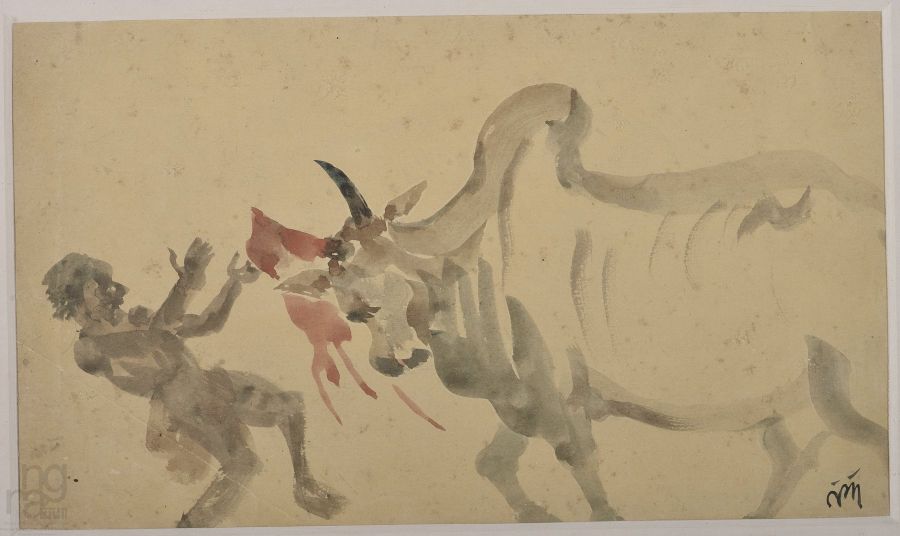 ×This painting belongs to a series of monochromatic ink and watercolour paintings inspired by the Sumi-e Japanese technique the artist employed. These compositions were stripped to the bare minimum where only a few strokes of ink were employed to create natural forms in an effortless approach. The artist has executed a bull fight, with a range of strokes in tonal variations capturing the rhythm and pattern of the image. This painting was purchased from the collection of Shri Biswaroop Bose and Smt. Nivedita Bose, children of Nandalal Bose.
×This painting belongs to a series of monochromatic ink and watercolour paintings inspired by the Sumi-e Japanese technique the artist employed. These compositions were stripped to the bare minimum where only a few strokes of ink were employed to create natural forms in an effortless approach. The artist has executed a bull fight, with a range of strokes in tonal variations capturing the rhythm and pattern of the image. This painting was purchased from the collection of Shri Biswaroop Bose and Smt. Nivedita Bose, children of Nandalal Bose. -
Painting
 ×This painting belongs to a series of monochromatic ink and watercolour paintings inspired by the Sumi-e Japanese technique the artist employed in the last phase of his life. These compositions were stripped to the bare minimum where only a few strokes of ink were employed to create natural forms in an effortless approach. The above painting belongs to the 'A waterfall' series. The artist has executed a waterfall, with a range of strokes in tonal variations capturing the rhythm and pattern of the image. This painting was purchased from the collection of Shri Biswaroop Bose and Smt. Nivedita Bose, children of Nandalal Bose.
×This painting belongs to a series of monochromatic ink and watercolour paintings inspired by the Sumi-e Japanese technique the artist employed in the last phase of his life. These compositions were stripped to the bare minimum where only a few strokes of ink were employed to create natural forms in an effortless approach. The above painting belongs to the 'A waterfall' series. The artist has executed a waterfall, with a range of strokes in tonal variations capturing the rhythm and pattern of the image. This painting was purchased from the collection of Shri Biswaroop Bose and Smt. Nivedita Bose, children of Nandalal Bose. -
Painting
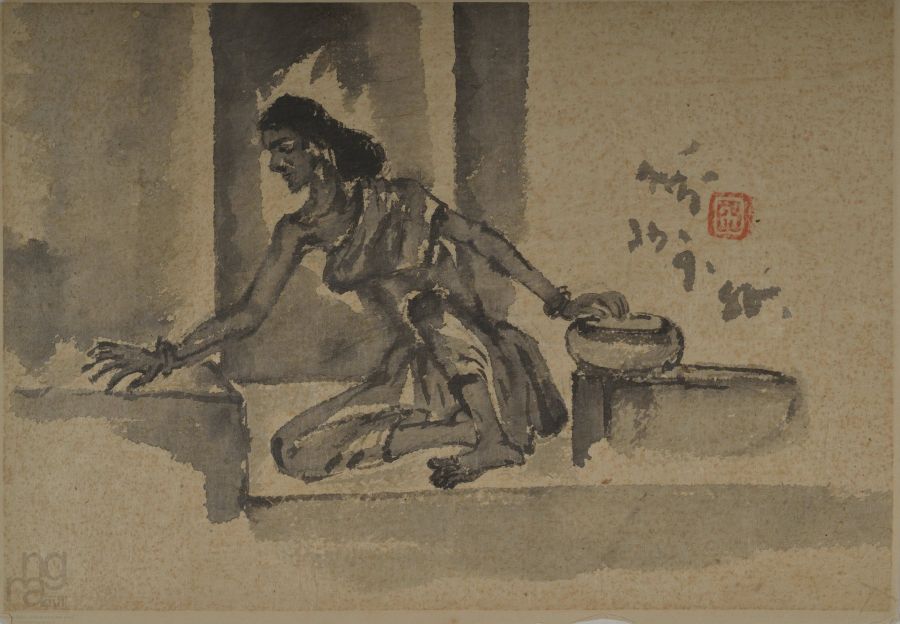 ×This painting belongs to a series of monochromatic ink and watercolour paintings inspired by the Sumi-e Japanese technique the artist employed. These compositions were stripped to the bare minimum where only a few strokes of ink were employed to create natural forms in an effortless approach. The artist has executed a woman sitting and applying mud on the wall, with a range of strokes in tonal variations capturing the rhythm and pattern of the image. This painting was purchased from the collection of Shri Biswaroop Bose and Smt. Nivedita Bose, children of Nandalal Bose.
×This painting belongs to a series of monochromatic ink and watercolour paintings inspired by the Sumi-e Japanese technique the artist employed. These compositions were stripped to the bare minimum where only a few strokes of ink were employed to create natural forms in an effortless approach. The artist has executed a woman sitting and applying mud on the wall, with a range of strokes in tonal variations capturing the rhythm and pattern of the image. This painting was purchased from the collection of Shri Biswaroop Bose and Smt. Nivedita Bose, children of Nandalal Bose. -
Painting
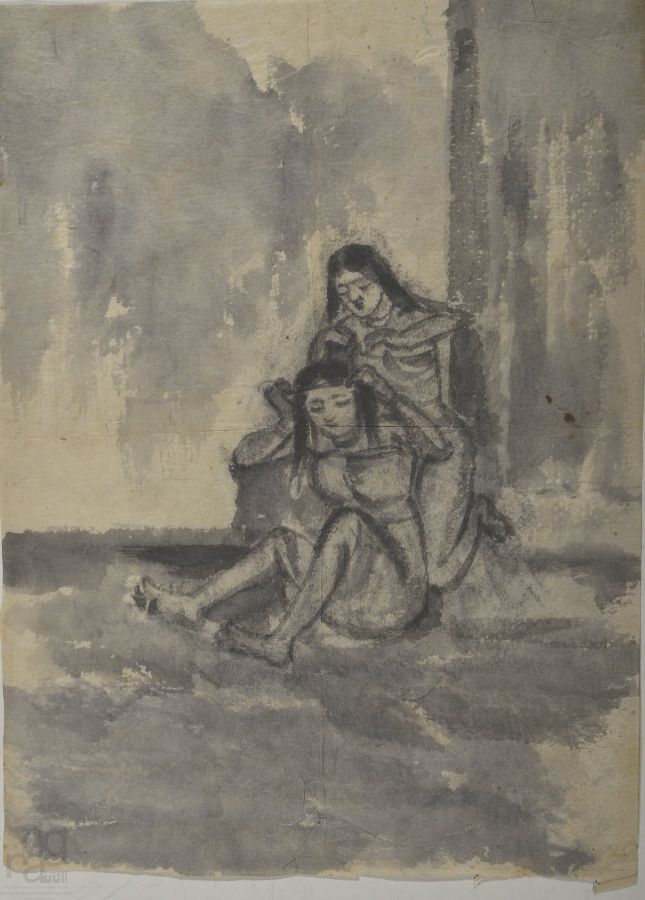 ×This painting belongs to a series of monochromatic ink and watercolour paintings inspired by the Sumi-e Japanese technique the artist employed in the last phase of his life. These compositions were stripped to the bare minimum where only a few strokes of ink were employed to create natural forms in an effortless approach. The above painting belongs to the 'Girls' series. The artist has executed two girls, one girl sitting and other tying ribbon on her hair, with a range of strokes in tonal variations capturing the rhythm and pattern of the image. This painting was purchased from the collection of Shri Biswaroop Bose and Smt. Nivedita Bose, children of Nandalal Bose.
×This painting belongs to a series of monochromatic ink and watercolour paintings inspired by the Sumi-e Japanese technique the artist employed in the last phase of his life. These compositions were stripped to the bare minimum where only a few strokes of ink were employed to create natural forms in an effortless approach. The above painting belongs to the 'Girls' series. The artist has executed two girls, one girl sitting and other tying ribbon on her hair, with a range of strokes in tonal variations capturing the rhythm and pattern of the image. This painting was purchased from the collection of Shri Biswaroop Bose and Smt. Nivedita Bose, children of Nandalal Bose. -
Painting
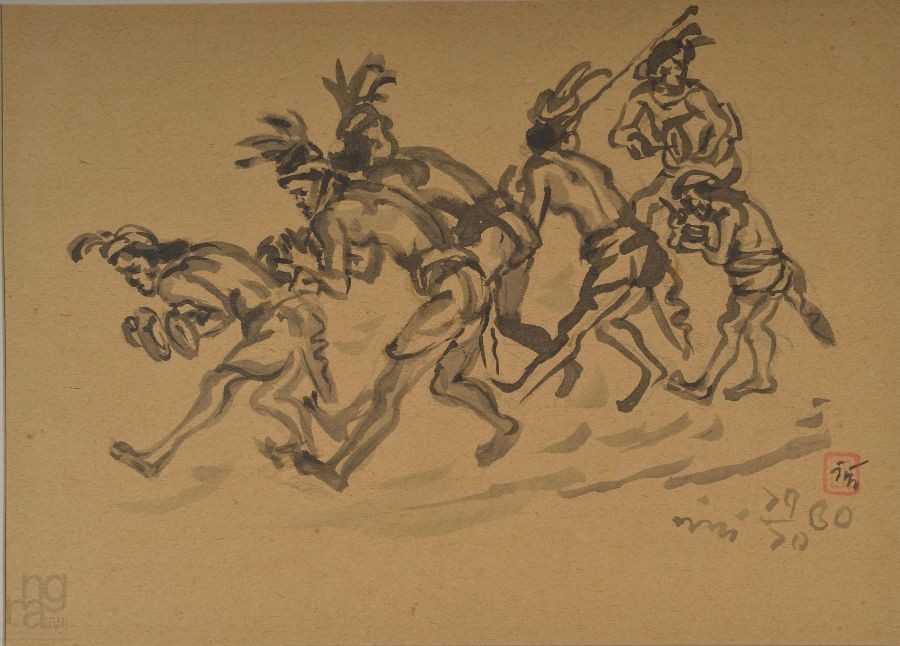 ×This painting belongs to a series of monochromatic ink and watercolour paintings inspired by the Sumi-e Japanese technique the artist employed in the last phase of his life. These compositions were stripped to the bare minimum where only a few strokes of ink were employed to create natural forms in an effortless approach. The above painting belongs to the 'Santhal Harvest Dance' series. The artist has executed a group of santhal tribal people performing harvest dance, with a range of strokes in tonal variations capturing the rhythm and pattern of the image. This painting was purchased from the collection of Shri Biswaroop Bose and Smt. Nivedita Bose, children of Nandalal Bose.
×This painting belongs to a series of monochromatic ink and watercolour paintings inspired by the Sumi-e Japanese technique the artist employed in the last phase of his life. These compositions were stripped to the bare minimum where only a few strokes of ink were employed to create natural forms in an effortless approach. The above painting belongs to the 'Santhal Harvest Dance' series. The artist has executed a group of santhal tribal people performing harvest dance, with a range of strokes in tonal variations capturing the rhythm and pattern of the image. This painting was purchased from the collection of Shri Biswaroop Bose and Smt. Nivedita Bose, children of Nandalal Bose. -
Painting
 ×This painting belongs to a series of monochromatic ink and watercolour paintings inspired by the Sumi-e Japanese technique the artist employed in the last phase of his life. These compositions were stripped to the bare minimum where only a few strokes of ink were employed to create natural forms in an effortless approach. The above painting belongs to the 'Girl Dancing' series. The artist has executed a girl dancing in the foreground and group of people sitting in the background, with a range of strokes in tonal variations capturing the rhythm and pattern of the image. This painting was purchased from the collection of Shri Biswaroop Bose and Smt. Nivedita Bose, children of Nandalal Bose.
×This painting belongs to a series of monochromatic ink and watercolour paintings inspired by the Sumi-e Japanese technique the artist employed in the last phase of his life. These compositions were stripped to the bare minimum where only a few strokes of ink were employed to create natural forms in an effortless approach. The above painting belongs to the 'Girl Dancing' series. The artist has executed a girl dancing in the foreground and group of people sitting in the background, with a range of strokes in tonal variations capturing the rhythm and pattern of the image. This painting was purchased from the collection of Shri Biswaroop Bose and Smt. Nivedita Bose, children of Nandalal Bose. -
Painting
 ×This painting belongs to a series of monochromatic ink and watercolour paintings inspired by the Sumi-e Japanese technique the artist employed in the last phase of his life. These compositions were stripped to the bare minimum where only a few strokes of ink were employed to create natural forms in an effortless approach. The artist has executed a girl of Nulia tribe sitting on a raised platform, with a range of strokes in tonal variations capturing the rhythm and pattern of the image. This painting was purchased from the collection of Shri Biswaroop Bose and Smt. Nivedita Bose, children of Nandalal Bose.
×This painting belongs to a series of monochromatic ink and watercolour paintings inspired by the Sumi-e Japanese technique the artist employed in the last phase of his life. These compositions were stripped to the bare minimum where only a few strokes of ink were employed to create natural forms in an effortless approach. The artist has executed a girl of Nulia tribe sitting on a raised platform, with a range of strokes in tonal variations capturing the rhythm and pattern of the image. This painting was purchased from the collection of Shri Biswaroop Bose and Smt. Nivedita Bose, children of Nandalal Bose. -
Painting
 ×This painting belongs to a series of monochromatic ink and watercolour paintings inspired by the Sumi-e Japanese technique the artist employed in the last phase of his life. These compositions were stripped to the bare minimum where only a few strokes of ink were employed to create natural forms in an effortless approach. The artist has executed a girl of Nulia tribe sitting on a raised platform, with a range of strokes in tonal variations capturing the rhythm and pattern of the image. This painting was purchased from the collection of Shri Biswaroop Bose and Smt. Nivedita Bose, children of Nandalal Bose.
×This painting belongs to a series of monochromatic ink and watercolour paintings inspired by the Sumi-e Japanese technique the artist employed in the last phase of his life. These compositions were stripped to the bare minimum where only a few strokes of ink were employed to create natural forms in an effortless approach. The artist has executed a girl of Nulia tribe sitting on a raised platform, with a range of strokes in tonal variations capturing the rhythm and pattern of the image. This painting was purchased from the collection of Shri Biswaroop Bose and Smt. Nivedita Bose, children of Nandalal Bose. -
Painting
 ×This painting belongs to a series of monochromatic ink and watercolour paintings inspired by the Sumi-e Japanese technique the artist employed in the last phase of his life. These compositions were stripped to the bare minimum where only a few strokes of ink were employed to create natural forms in an effortless approach. In the above painting Nandalal has executed to fishermen at work, as he was inspired by the daily lives of the Nulia tribe. He has used similar brushwork in the rendering of the sea and the figures, thus conveying the idea of nature and humans as different expression of the same underlying unity. This painting was purchased from the collection of Shri Biswaroop Bose and Smt. Nivedita Bose, children of Nandalal Bose.
×This painting belongs to a series of monochromatic ink and watercolour paintings inspired by the Sumi-e Japanese technique the artist employed in the last phase of his life. These compositions were stripped to the bare minimum where only a few strokes of ink were employed to create natural forms in an effortless approach. In the above painting Nandalal has executed to fishermen at work, as he was inspired by the daily lives of the Nulia tribe. He has used similar brushwork in the rendering of the sea and the figures, thus conveying the idea of nature and humans as different expression of the same underlying unity. This painting was purchased from the collection of Shri Biswaroop Bose and Smt. Nivedita Bose, children of Nandalal Bose. -
Painting
 ×This painting belongs to a series of monochromatic ink and watercolour paintings inspired by the Sumi-e Japanese technique the artist employed in the last phase of his life. These compositions were stripped to the bare minimum where only a few strokes of ink were employed to create natural forms in an effortless approach. In this sketch, Nandalal has executed a man sitting inside a bamboo hut surrounded with trees and bushes, with a range of strokes in tonal variations capturing the rhythm and pattern in the image. This painting was purchased from the collection of Shri Biswaroop
×This painting belongs to a series of monochromatic ink and watercolour paintings inspired by the Sumi-e Japanese technique the artist employed in the last phase of his life. These compositions were stripped to the bare minimum where only a few strokes of ink were employed to create natural forms in an effortless approach. In this sketch, Nandalal has executed a man sitting inside a bamboo hut surrounded with trees and bushes, with a range of strokes in tonal variations capturing the rhythm and pattern in the image. This painting was purchased from the collection of Shri Biswaroop -
Painting
 ×This painting belongs to a series of monochromatic ink and watercolour paintings inspired by the Sumi-e Japanese technique the artist employed. These compositions were stripped to the bare minimum where only a few strokes of ink were employed to create natural forms in an effortless approach. The artist has executed an old lady, with a range of strokes in tonal variations capturing the rhythm and pattern of the image. This painting was purchased from the collection of Shri Biswaroop Bose and Smt. Nivedita Bose, children of Nandalal
×This painting belongs to a series of monochromatic ink and watercolour paintings inspired by the Sumi-e Japanese technique the artist employed. These compositions were stripped to the bare minimum where only a few strokes of ink were employed to create natural forms in an effortless approach. The artist has executed an old lady, with a range of strokes in tonal variations capturing the rhythm and pattern of the image. This painting was purchased from the collection of Shri Biswaroop Bose and Smt. Nivedita Bose, children of Nandalal -
Painting
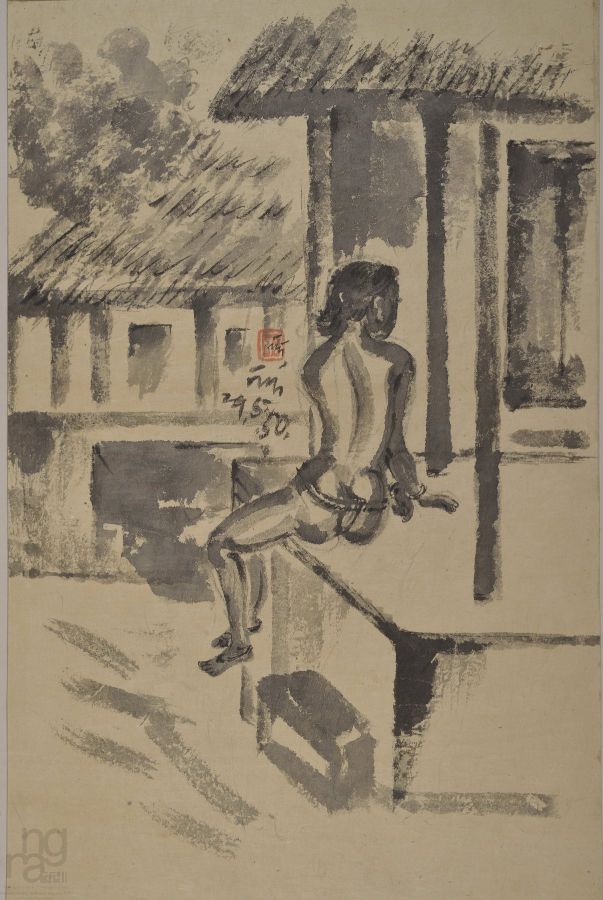 ×This painting belongs to a series of monochromatic ink and watercolour paintings inspired by the Sumi-e Japanese technique the artist employed in the last phase of his life. These compositions were stripped to the bare minimum where only a few strokes of ink were employed to create natural forms in an effortless approach. The above painting, the artist has executed a human figure sitting on the door step of Orissa village, with a range of strokes in tonal variations capturing the rhythm and pattern of the image. This painting was purchased from the collection of Shri Biswaroop Bose and Smt. Nivedita Bose, children of Nandalal Bose.
×This painting belongs to a series of monochromatic ink and watercolour paintings inspired by the Sumi-e Japanese technique the artist employed in the last phase of his life. These compositions were stripped to the bare minimum where only a few strokes of ink were employed to create natural forms in an effortless approach. The above painting, the artist has executed a human figure sitting on the door step of Orissa village, with a range of strokes in tonal variations capturing the rhythm and pattern of the image. This painting was purchased from the collection of Shri Biswaroop Bose and Smt. Nivedita Bose, children of Nandalal Bose. -
Painting
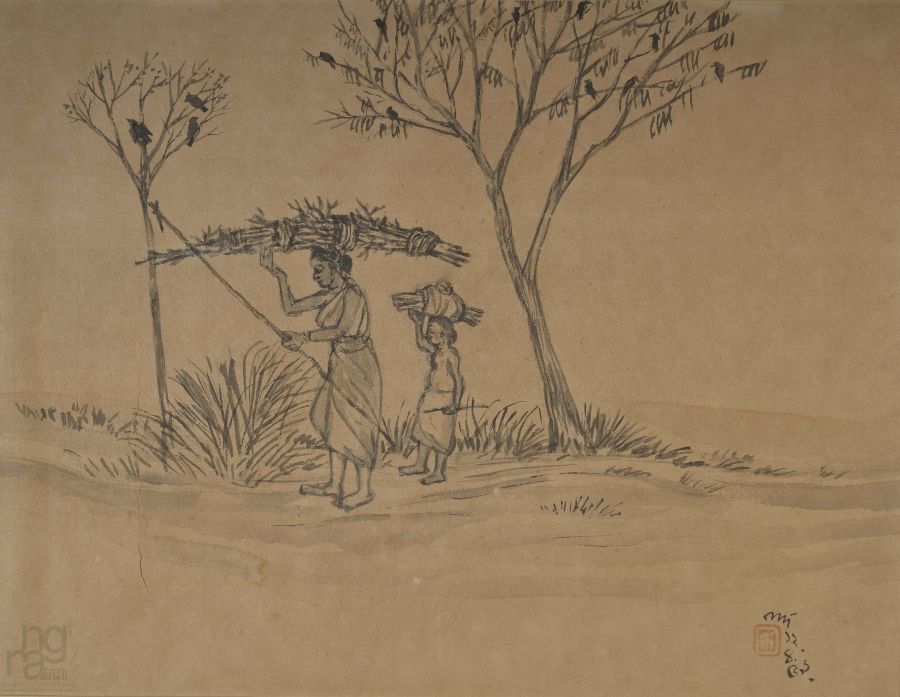 ×This painting belongs to a series of monochromatic ink and watercolour paintings inspired by the Sumi-e Japanese technique the artist employed in the last phase of his life. These compositions were stripped to the bare minimum where only a few strokes of ink were employed to create natural forms in an effortless approach. The above painting belongs to the 'Ladies Carrying Wood' series. The artist has executed a lady and a girl carrying logs of wood in the foreground and trees in the background, with a range of strokes in tonal variations capturing the rhythm and pattern of the image. This painting was purchased from the collection of Shri Biswaroop Bose and Smt. Nivedita Bose, children of Nandalal Bose.
×This painting belongs to a series of monochromatic ink and watercolour paintings inspired by the Sumi-e Japanese technique the artist employed in the last phase of his life. These compositions were stripped to the bare minimum where only a few strokes of ink were employed to create natural forms in an effortless approach. The above painting belongs to the 'Ladies Carrying Wood' series. The artist has executed a lady and a girl carrying logs of wood in the foreground and trees in the background, with a range of strokes in tonal variations capturing the rhythm and pattern of the image. This painting was purchased from the collection of Shri Biswaroop Bose and Smt. Nivedita Bose, children of Nandalal Bose. -
Painting
 ×This painting belongs to a series of monochromatic ink and watercolour paintings inspired by the Sumi-e Japanese technique the artist employed in the last phase of his life. These compositions were stripped to the bare minimum where only a few strokes of ink were employed to create natural forms in an effortless approach. The above painting belongs to the 'Returning From Bazar' series. The artist has executed a family returning from the bazar, with a range of strokes in tonal variations capturing the rhythm and pattern of the image. This painting was purchased from the collection of Shri Biswaroop Bose and Smt. Nivedita Bose, children of Nandalal Bose.
×This painting belongs to a series of monochromatic ink and watercolour paintings inspired by the Sumi-e Japanese technique the artist employed in the last phase of his life. These compositions were stripped to the bare minimum where only a few strokes of ink were employed to create natural forms in an effortless approach. The above painting belongs to the 'Returning From Bazar' series. The artist has executed a family returning from the bazar, with a range of strokes in tonal variations capturing the rhythm and pattern of the image. This painting was purchased from the collection of Shri Biswaroop Bose and Smt. Nivedita Bose, children of Nandalal Bose. -
Painting
 ×This painting belongs to a series of monochromatic ink and watercolour paintings inspired by the Sumi-e Japanese technique the artist employed in the last phase of his life. These compositions were stripped to the bare minimum where only a few strokes of ink were employed to create natural forms in an effortless approach. The above painting belongs to the 'Way to Kenduli Fair' series. The artist has executed a scene from a, way to kenduli fair with trees, bushes and two women cooking inside the hut, with a range of strokes in tonal variations capturing the rhythm and pattern of the image. This painting was purchased from the collection of Shri Biswaroop Bose and Smt. Nivedita Bose, children of Nandalal Bose.
×This painting belongs to a series of monochromatic ink and watercolour paintings inspired by the Sumi-e Japanese technique the artist employed in the last phase of his life. These compositions were stripped to the bare minimum where only a few strokes of ink were employed to create natural forms in an effortless approach. The above painting belongs to the 'Way to Kenduli Fair' series. The artist has executed a scene from a, way to kenduli fair with trees, bushes and two women cooking inside the hut, with a range of strokes in tonal variations capturing the rhythm and pattern of the image. This painting was purchased from the collection of Shri Biswaroop Bose and Smt. Nivedita Bose, children of Nandalal Bose. -
Painting
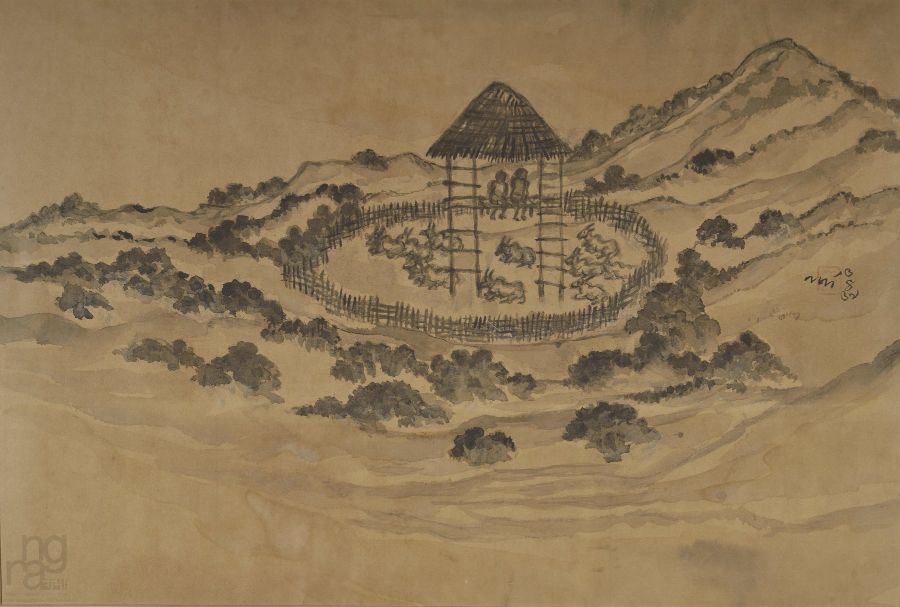 ×This painting belongs to a series of monochromatic ink and watercolour paintings inspired by the Sumi-e Japanese technique the artist employed in the last phase of his life. These compositions were stripped to the bare minimum where only a few strokes of ink were employed to create natural forms in an effortless approach. The above painting belongs to the 'Cow Herd at Bog Cave' series. The artist has executed a herd of cows sitting in bog cave and two human figure, keeping a watch on them, with a range of strokes in tonal variations capturing the rhythm and pattern of the image. This painting was purchased from the collection of Shri Biswaroop Bose and Smt. Nivedita Bose, children of Nandalal Bose.
×This painting belongs to a series of monochromatic ink and watercolour paintings inspired by the Sumi-e Japanese technique the artist employed in the last phase of his life. These compositions were stripped to the bare minimum where only a few strokes of ink were employed to create natural forms in an effortless approach. The above painting belongs to the 'Cow Herd at Bog Cave' series. The artist has executed a herd of cows sitting in bog cave and two human figure, keeping a watch on them, with a range of strokes in tonal variations capturing the rhythm and pattern of the image. This painting was purchased from the collection of Shri Biswaroop Bose and Smt. Nivedita Bose, children of Nandalal Bose. -
Painting
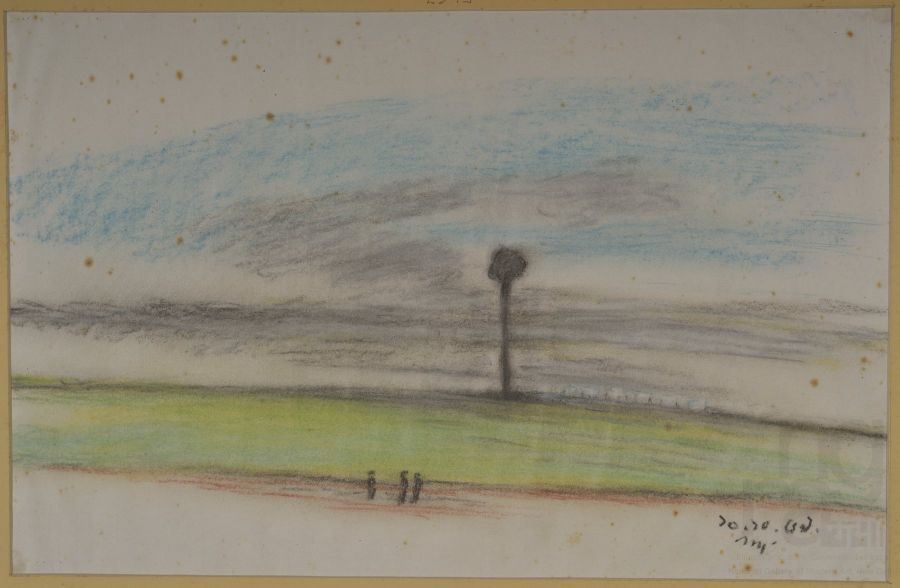 ×This painting belongs to a series of monochromatic ink and watercolour paintings inspired by the Sumi-e Japanese technique the artist employed in the last phase of his life. These compositions were stripped to the bare minimum where only a few strokes of ink were employed to create natural forms in an effortless approach. In this sketch, Nandalal has executed three human figure in the foreground and a tree in the background, with a range of strokes in tonal variations capturing the rhythm and pattern in the image. This painting was purchased from the collection of Shri Biswaroop Bose and Smt. Nivedita Bose, children of Nandalal Bose.
×This painting belongs to a series of monochromatic ink and watercolour paintings inspired by the Sumi-e Japanese technique the artist employed in the last phase of his life. These compositions were stripped to the bare minimum where only a few strokes of ink were employed to create natural forms in an effortless approach. In this sketch, Nandalal has executed three human figure in the foreground and a tree in the background, with a range of strokes in tonal variations capturing the rhythm and pattern in the image. This painting was purchased from the collection of Shri Biswaroop Bose and Smt. Nivedita Bose, children of Nandalal Bose. -
Painting
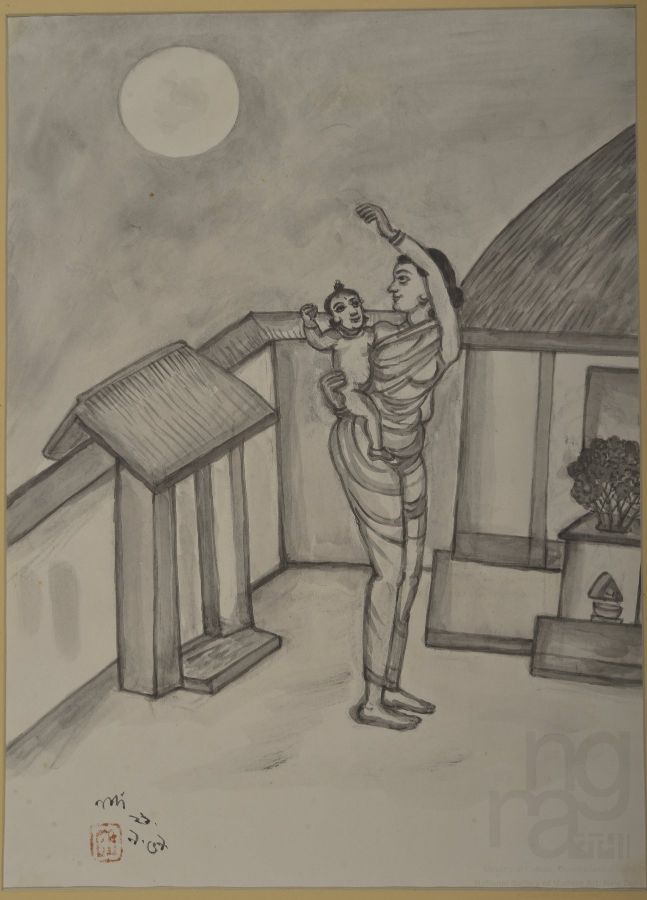 ×This painting belongs to a series of monochromatic ink and watercolour paintings inspired by the Sumi-e Japanese technique the artist employed in the last phase of his life. These compositions were stripped to the bare minimum where only a few strokes of ink were employed to create natural forms in an effortless approach. The above painting belongs to the 'Mother and child' series. The artist has executed a mother holding her child, showing the moon, with a range of strokes in tonal variations capturing the rhythm and pattern of the image. This painting was purchased from the collection of Shri Biswaroop Bose and Smt. Nivedita Bose, children of Nandalal Bose.
×This painting belongs to a series of monochromatic ink and watercolour paintings inspired by the Sumi-e Japanese technique the artist employed in the last phase of his life. These compositions were stripped to the bare minimum where only a few strokes of ink were employed to create natural forms in an effortless approach. The above painting belongs to the 'Mother and child' series. The artist has executed a mother holding her child, showing the moon, with a range of strokes in tonal variations capturing the rhythm and pattern of the image. This painting was purchased from the collection of Shri Biswaroop Bose and Smt. Nivedita Bose, children of Nandalal Bose. -
Painting
 ×This painting belongs to a series of monochromatic ink and watercolour paintings inspired by the Sumi-e Japanese technique the artist employed in the last phase of his life. These compositions were stripped to the bare minimum where only a few strokes of ink were employed to create natural forms in an effortless approach. The above painting belongs to the 'A woman cooking' series. The artist has executed a woman cooking outside a hut and two children sitting in the foreground, with a range of strokes in tonal variations capturing the rhythm and pattern of the image. This painting was purchased from the collection of Shri Biswaroop Bose and Smt. Nivedita Bose, children of Nandalal Bose.
×This painting belongs to a series of monochromatic ink and watercolour paintings inspired by the Sumi-e Japanese technique the artist employed in the last phase of his life. These compositions were stripped to the bare minimum where only a few strokes of ink were employed to create natural forms in an effortless approach. The above painting belongs to the 'A woman cooking' series. The artist has executed a woman cooking outside a hut and two children sitting in the foreground, with a range of strokes in tonal variations capturing the rhythm and pattern of the image. This painting was purchased from the collection of Shri Biswaroop Bose and Smt. Nivedita Bose, children of Nandalal Bose. -
Painting
 ×This painting belongs to a series of monochromatic ink and watercolour paintings inspired by the Sumi-e Japanese technique the artist employed in the last phase of his life. These compositions were stripped to the bare minimum where only a few strokes of ink were employed to create natural forms in an effortless approach. The above painting the artist has executed a scene from Ramayana, where Rama is using his ?asthra? (Arrow) to make the ocean to be dried up through which, he planned to cross that ocean, in order to bring back his wife, who had been kidnapped by the demon king Ravana, with a range of strokes in tonal variations capturing the rhythm and pattern of the image. This painting was purchased from the collection of Shri Biswaroop Bose and Smt. Nivedita Bose, children of Nandalal
×This painting belongs to a series of monochromatic ink and watercolour paintings inspired by the Sumi-e Japanese technique the artist employed in the last phase of his life. These compositions were stripped to the bare minimum where only a few strokes of ink were employed to create natural forms in an effortless approach. The above painting the artist has executed a scene from Ramayana, where Rama is using his ?asthra? (Arrow) to make the ocean to be dried up through which, he planned to cross that ocean, in order to bring back his wife, who had been kidnapped by the demon king Ravana, with a range of strokes in tonal variations capturing the rhythm and pattern of the image. This painting was purchased from the collection of Shri Biswaroop Bose and Smt. Nivedita Bose, children of Nandalal -
Print
 ×The woodcut print by the artist portrays Gandhiji's iconic stance of the 240 miles the Dandi march taken against the British.
×The woodcut print by the artist portrays Gandhiji's iconic stance of the 240 miles the Dandi march taken against the British. -
Print
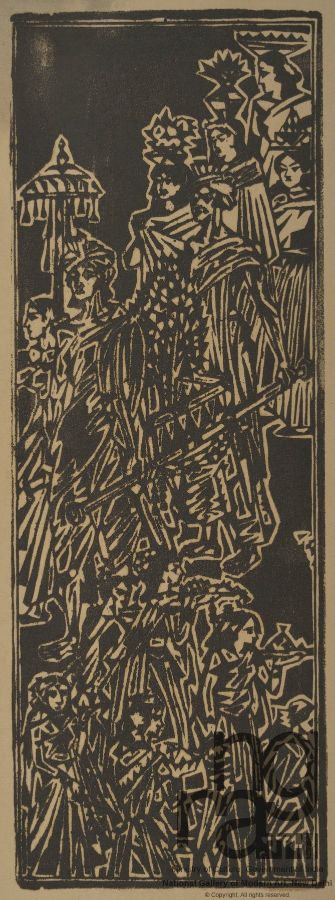 ×Nandalal preferred drawing from life, often sketching outdoors with the subject being life, nature studies, landscapes, figure drawings and animals. In the above print, the artist has depicted a procession in which men and women are walking carrying a canopy, sacred pots over the head, musical instruments and food. The composition is rendered with firm yet fluid lines gauged on the linoleum sheet and printed on a plain surface, creating a dramatic contrast of black and white image, resulting in an effective means of documenting the royal procession.
×Nandalal preferred drawing from life, often sketching outdoors with the subject being life, nature studies, landscapes, figure drawings and animals. In the above print, the artist has depicted a procession in which men and women are walking carrying a canopy, sacred pots over the head, musical instruments and food. The composition is rendered with firm yet fluid lines gauged on the linoleum sheet and printed on a plain surface, creating a dramatic contrast of black and white image, resulting in an effective means of documenting the royal procession. -
Print
 ×Nandalal had a strong affinity for sketching, his subjects being the surrounding environs, people in their everyday life or anything that he found fascinating. In the above sketch the artist has depicted Abdul Ghaffar Khan, one of the freedom fighters of India. The composition is rendered with fluid lines creating a dramatic contrast of black and white image, resulting in an effective means of documenting the presence of this iconic figure of India
×Nandalal had a strong affinity for sketching, his subjects being the surrounding environs, people in their everyday life or anything that he found fascinating. In the above sketch the artist has depicted Abdul Ghaffar Khan, one of the freedom fighters of India. The composition is rendered with fluid lines creating a dramatic contrast of black and white image, resulting in an effective means of documenting the presence of this iconic figure of India -
Print
 ×Nandalal had a strong affinity for sketching, his subjects being the surrounding environs, people in their everyday life or anything that he found fascinating. In the above sketch the artist has depicted Mahatma Gandhi leading Dandi march. The composition is rendered with fluid lines creating a dramatic contrast of black and white image, resulting in an effective means of documenting the presence of this iconic figure of India
×Nandalal had a strong affinity for sketching, his subjects being the surrounding environs, people in their everyday life or anything that he found fascinating. In the above sketch the artist has depicted Mahatma Gandhi leading Dandi march. The composition is rendered with fluid lines creating a dramatic contrast of black and white image, resulting in an effective means of documenting the presence of this iconic figure of India -
Painting
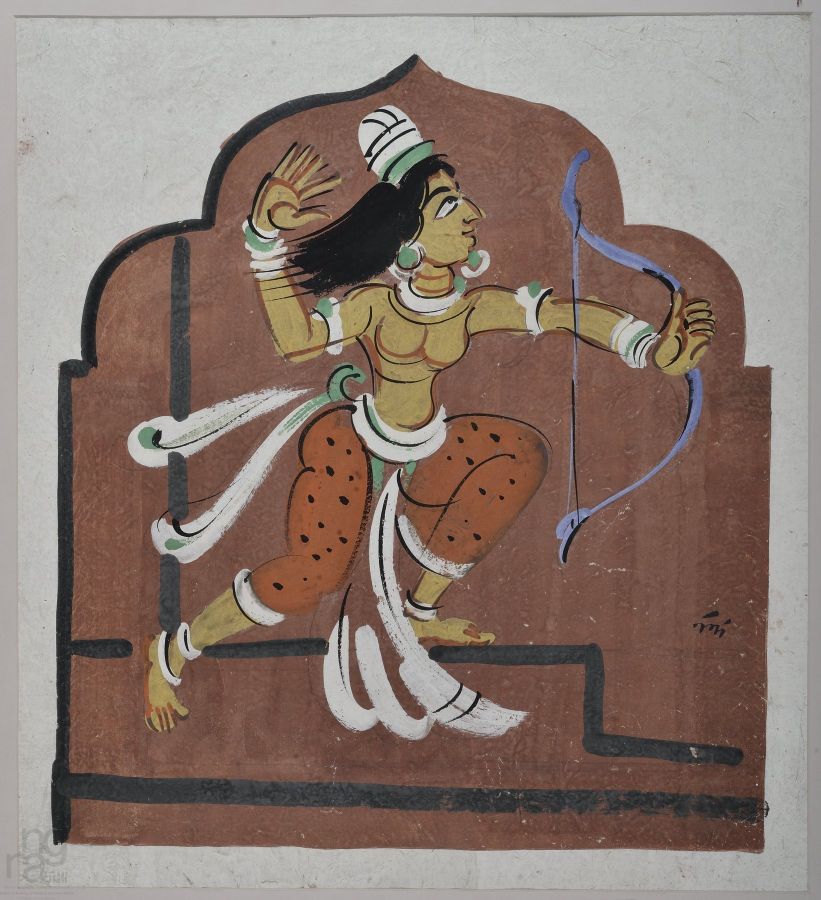 ×Haripura posters by Nandalal captured moments of everyday Indian village life and culture. In this poster, he has depicted ‘Rati’ (a god of love of Hindu mythology) with a bow. The form has been articulated with earthen colour palette and swift strokes, executed their contours in a calligraphic manner that both the styles and subject matter exude the charm and playfulness often found in folk art. This aptly limns the figure with the artist's personal sensibilities towards India mythological sculptures and paintings.
×Haripura posters by Nandalal captured moments of everyday Indian village life and culture. In this poster, he has depicted ‘Rati’ (a god of love of Hindu mythology) with a bow. The form has been articulated with earthen colour palette and swift strokes, executed their contours in a calligraphic manner that both the styles and subject matter exude the charm and playfulness often found in folk art. This aptly limns the figure with the artist's personal sensibilities towards India mythological sculptures and paintings. -
Painting
 ×Nandalal had a strong affinity for sketching, his subjects being the surrounding environs, people in their everyday life or anything that he found fascinating. In the above sketch the artist has depicted Mahatma Gandhi leading Dandi march. The composition is rendered with fluid lines creating a dramatic contrast of black and white image, resulting in an effective means of documenting the presence of this iconic figure of India.
×Nandalal had a strong affinity for sketching, his subjects being the surrounding environs, people in their everyday life or anything that he found fascinating. In the above sketch the artist has depicted Mahatma Gandhi leading Dandi march. The composition is rendered with fluid lines creating a dramatic contrast of black and white image, resulting in an effective means of documenting the presence of this iconic figure of India.
-
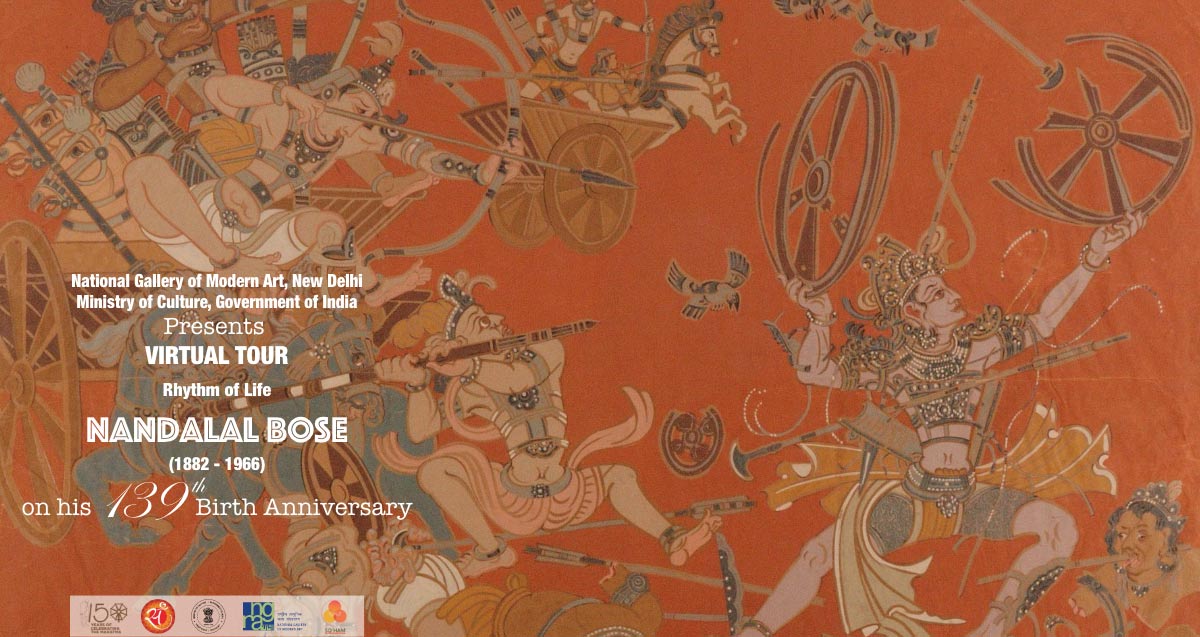 ×
×Concept Note
Virtual Tour
Virtual Tour | Rhythm of Life - Nandalal Bose
The pioneer of modern Indian Art and a key figure of Contextual Modernism.
The Virtual Tour titled “Rhythm of Life : Nandalal Bose” is organized to commemorate the 139th Birth Anniversary of Nandalal Bose on 3rd December 2020. Nandalal is known to have fervently sketched on postcard sized papers mostly using ink and brush, recording his surroundings. The compositions are rendered with linear, soft brush strokes delineating the cheerful forms and suggesting the demeanour of the subject. National Gallery of Modern Art, New Delhi acquired the largest collection of 6744 artworks of Nandalal Bose from his family some of which were exhibited in the Centenary celebratory exhibition organised by the museum in the year 1983. A major portion of the museum's collection includes monochromatic pencil sketches, pen and ink drawings on postcard and paper, watercolour paintings and sketches apart from the more detailed and elaborate tempera and wash paintings, Haripura posters and prints from the artist's extensive oeuvre. This virtual tour presents the 150 works of art from the prominent artworks of Nandalal Bose from reserve collection of NGMA, grouped in a series of four different themes of (i) Haripura Posters, (ii) Flow of Life, (iii) Monochrome and (iv) Transcendental. This virtual tour also showcases artists creation on Post Cards from the collection of NGMA containing 175 works of art. I take pride of the tireless effort of our entire IT Cell to conceive and conceptualize the idea of launching a series of Virtual Tours and designed and developed the same during this pandemic period to facilitate our esteemed visitors with the prestigious collection of NGMA. Adwaita Charan Gadanayak
Director General, NGMA -
Painting
 ×"In this particular painting the artist has depicted an event in Buddha’s life also known as The Great Departure that records his renunciation of royal life. The composition is rendered with bold, clearly defined contours filled with colours, articulating the elongated figure riding on a horse and bringing out the corporeality and substance of the forms. "
×"In this particular painting the artist has depicted an event in Buddha’s life also known as The Great Departure that records his renunciation of royal life. The composition is rendered with bold, clearly defined contours filled with colours, articulating the elongated figure riding on a horse and bringing out the corporeality and substance of the forms. " -
Painting
 ×Nandalal had a strong affinity for sketching, his subjects being the surrounding environs, people in their everyday life or anything that he found fascinating. The above painting by the artist depicts a woman carrying a decorated pot on her head and a young girl holding a flask, walking on the hilly terrain. The graceful figures are rendered with firm yet fluid brush strokes filled with colours, articulating the contours and bringing about the corporeality of the forms.
×Nandalal had a strong affinity for sketching, his subjects being the surrounding environs, people in their everyday life or anything that he found fascinating. The above painting by the artist depicts a woman carrying a decorated pot on her head and a young girl holding a flask, walking on the hilly terrain. The graceful figures are rendered with firm yet fluid brush strokes filled with colours, articulating the contours and bringing about the corporeality of the forms. -
Painting
 ×Nandalal's work reflects changing landscapes, portraits of people, sketches from life and places at the time of changing outlook in the modern Indian cultural domain. His nature to explore the various materials and mediums allowed him to make a prolific body of work in different mediums. Along with his explorations of art learning from the art of the Tagores and Ajanta murals, he also imbibed the techniques of art from the European indigenous tradition and the Japanese wash technique. This painting portraying Shri Chaitanya sitting under the Stambha, one can see the reflection of all these styles, as seen in the wash technique he uses as well as the light effect he creates in the painting.
×Nandalal's work reflects changing landscapes, portraits of people, sketches from life and places at the time of changing outlook in the modern Indian cultural domain. His nature to explore the various materials and mediums allowed him to make a prolific body of work in different mediums. Along with his explorations of art learning from the art of the Tagores and Ajanta murals, he also imbibed the techniques of art from the European indigenous tradition and the Japanese wash technique. This painting portraying Shri Chaitanya sitting under the Stambha, one can see the reflection of all these styles, as seen in the wash technique he uses as well as the light effect he creates in the painting. -
Painting
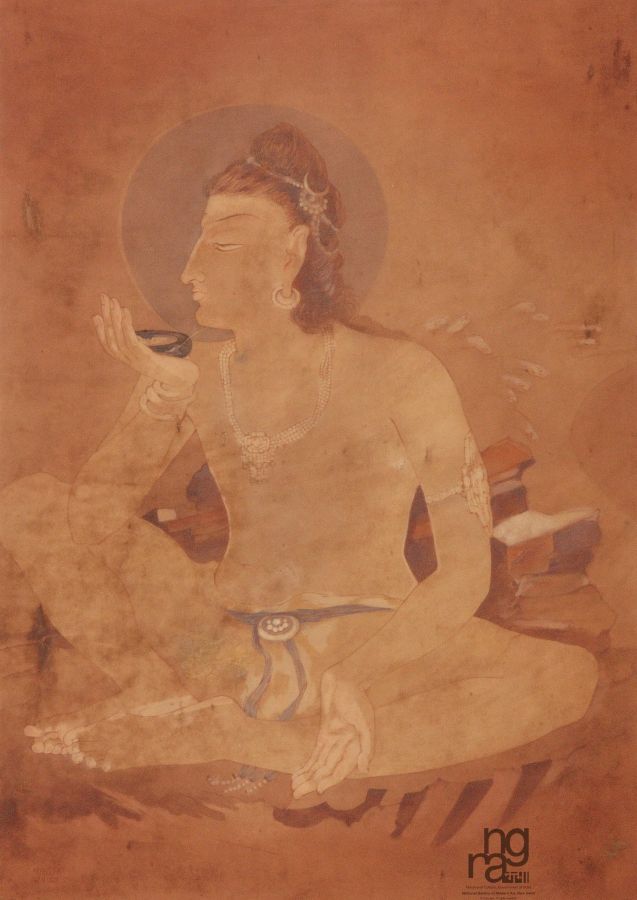 ×Nandalal's work reflects changing landscapes, portraits of people, sketches from life and places at the time of changing outlook in the modern Indian cultural domain. His nature to explore the various materials and mediums allowed him to make a prolific body of work in different mediums. Along with his explorations of art learning from the style of Rabindranath TagoreâÂÂs art and AbanindranathâÂÂs art, he also imbibed the techniques of art from the European indigenous tradition and the Japanese wash technique. This work of his made in the wash technique on paper depicts Shiva drinking poison.
×Nandalal's work reflects changing landscapes, portraits of people, sketches from life and places at the time of changing outlook in the modern Indian cultural domain. His nature to explore the various materials and mediums allowed him to make a prolific body of work in different mediums. Along with his explorations of art learning from the style of Rabindranath TagoreâÂÂs art and AbanindranathâÂÂs art, he also imbibed the techniques of art from the European indigenous tradition and the Japanese wash technique. This work of his made in the wash technique on paper depicts Shiva drinking poison. -
Painting
 ×Nandalal's work reflected changing landscapes, portraits of people, sketches from life and places at the time of changing outlook in the modern Indian cultural domain. His nature to explore the various materials and mediums allowed him to make a prolific body of work in different mediums. Along with the techniques of art he imbibed from the European indigenous tradition and the Japanese wash technique, he also explored the art of Rabindranath Tagore, Abnindranath, who was his teacher. Thus the techniques of their art also reflect in Nandalal's visual expressions.
×Nandalal's work reflected changing landscapes, portraits of people, sketches from life and places at the time of changing outlook in the modern Indian cultural domain. His nature to explore the various materials and mediums allowed him to make a prolific body of work in different mediums. Along with the techniques of art he imbibed from the European indigenous tradition and the Japanese wash technique, he also explored the art of Rabindranath Tagore, Abnindranath, who was his teacher. Thus the techniques of their art also reflect in Nandalal's visual expressions. -
Painting
 ×Nandalal had a strong affinity for sketching, his subjects being the surrounding environs, people in their everyday life or anything that he found fascinating. The above painting by the artist depicts a village woman milking a cow. The graceful figure is rendered with firm yet fluid brush strokes filled with colours, articulating the contours and bringing about the corporeality of the form.
×Nandalal had a strong affinity for sketching, his subjects being the surrounding environs, people in their everyday life or anything that he found fascinating. The above painting by the artist depicts a village woman milking a cow. The graceful figure is rendered with firm yet fluid brush strokes filled with colours, articulating the contours and bringing about the corporeality of the form. -
Painting
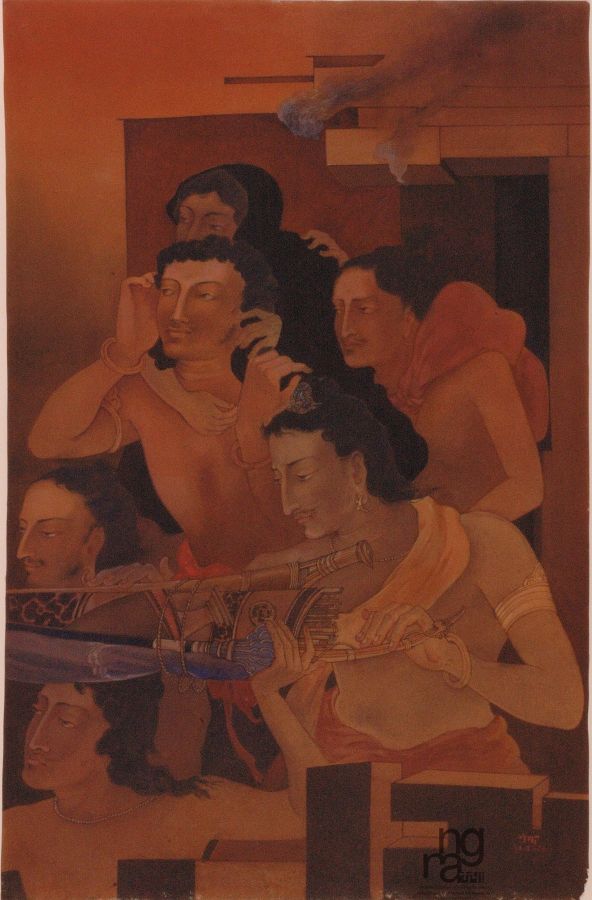 ×Nandalal's work reflected changing landscapes, portraits of people, sketches from life and places at the time of changing outlook in the modern Indian cultural domain. His nature to explore the various materials and mediums allowed him to make a prolific body of work in different mediums. Along with the techniques of art he imbibed from the European indigenous tradition and the Japanese wash technique, he also explored the art of Rabindranath Tagore, Abnindranath, who was his teacher. Thus the techniques of their art also reflect in Nandalal's visual expressions. This painting, with the kind of the portrayal of the people and the rendering of the space on the paper, reflects the similitude with the Ajanta Murals which was the inspiration in Abanindranath's works also.
×Nandalal's work reflected changing landscapes, portraits of people, sketches from life and places at the time of changing outlook in the modern Indian cultural domain. His nature to explore the various materials and mediums allowed him to make a prolific body of work in different mediums. Along with the techniques of art he imbibed from the European indigenous tradition and the Japanese wash technique, he also explored the art of Rabindranath Tagore, Abnindranath, who was his teacher. Thus the techniques of their art also reflect in Nandalal's visual expressions. This painting, with the kind of the portrayal of the people and the rendering of the space on the paper, reflects the similitude with the Ajanta Murals which was the inspiration in Abanindranath's works also. -
Painting
 ×The above painting is a perceptible representation of a ferocious avatar of the Hindu goddess ‘Durga’ mounted on her lion. She is depicted with multiple arms, each with weapons, against the blue background having white flowers. The painting is rendered with the use of colours, delineating the contours and adding to her ferocious form.
×The above painting is a perceptible representation of a ferocious avatar of the Hindu goddess ‘Durga’ mounted on her lion. She is depicted with multiple arms, each with weapons, against the blue background having white flowers. The painting is rendered with the use of colours, delineating the contours and adding to her ferocious form. -
Painting
 ×Nandalal has a strong affinity for sketching, his subjects being the surrounding environs, people in their everyday life or anything that he found fascinating. In the above sketch the artist has depicted Mahishasur mardini, one of the avatar's of goddess Durga. The ferocious figure is rendered with linear, firm yet fluid ink strokes articulating the detail contours and suggesting the demeanour of the subject.
×Nandalal has a strong affinity for sketching, his subjects being the surrounding environs, people in their everyday life or anything that he found fascinating. In the above sketch the artist has depicted Mahishasur mardini, one of the avatar's of goddess Durga. The ferocious figure is rendered with linear, firm yet fluid ink strokes articulating the detail contours and suggesting the demeanour of the subject. -
Painting
 ×Nandalal's work reflects changing landscapes, portraits of people, sketches from life and places at the time of changing outlook in the modern Indian cultural domain. His nature to explore the various materials and mediums allowed him to make a prolific body of work in different mediums. Along with his explorations of art learning from the style of Rabindranath Tagore's art and Abanindranath's art, who was his teacher, he also imbibed the techniques of art from the European indigenous tradition and the Japanese wash technique. Nandalal's experiments in mural painting along with his students on the walls of various buildings in Shantiniketan gave rise to remarkable works of art. On such site with his murals is at the Kirti Mandir, Baroda made in 1946. This Image shows the studies of the same panel Abhimanue Badha, where the hero from Mahabharata is tragically slain.
×Nandalal's work reflects changing landscapes, portraits of people, sketches from life and places at the time of changing outlook in the modern Indian cultural domain. His nature to explore the various materials and mediums allowed him to make a prolific body of work in different mediums. Along with his explorations of art learning from the style of Rabindranath Tagore's art and Abanindranath's art, who was his teacher, he also imbibed the techniques of art from the European indigenous tradition and the Japanese wash technique. Nandalal's experiments in mural painting along with his students on the walls of various buildings in Shantiniketan gave rise to remarkable works of art. On such site with his murals is at the Kirti Mandir, Baroda made in 1946. This Image shows the studies of the same panel Abhimanue Badha, where the hero from Mahabharata is tragically slain. -
Painting
 ×Nandalal's work reflects changing landscapes, portraits of people, sketches from life and places at the time of changing outlook in the modern Indian cultural domain. His nature to explore the various materials and mediums allowed him to make a prolific body of work in different mediums. Along with his explorations of art learning from the style of Rabindranath Tagore's art and Abanindranath's art, who was his teacher, he also imbibed the techniques of art from the European indigenous tradition and the Japanese wash technique. Nandalal's experiments in mural painting along with his students on the walls of various buildings in Shantiniketan gave rise to remarkable works of art. On such site with his murals is at the Kirti Mandir, Baroda made in 1946. This Image shows the studies of the same panel Abhimanue Badha, where the hero from Mahabharata is tragically slain.
×Nandalal's work reflects changing landscapes, portraits of people, sketches from life and places at the time of changing outlook in the modern Indian cultural domain. His nature to explore the various materials and mediums allowed him to make a prolific body of work in different mediums. Along with his explorations of art learning from the style of Rabindranath Tagore's art and Abanindranath's art, who was his teacher, he also imbibed the techniques of art from the European indigenous tradition and the Japanese wash technique. Nandalal's experiments in mural painting along with his students on the walls of various buildings in Shantiniketan gave rise to remarkable works of art. On such site with his murals is at the Kirti Mandir, Baroda made in 1946. This Image shows the studies of the same panel Abhimanue Badha, where the hero from Mahabharata is tragically slain. -
Painting
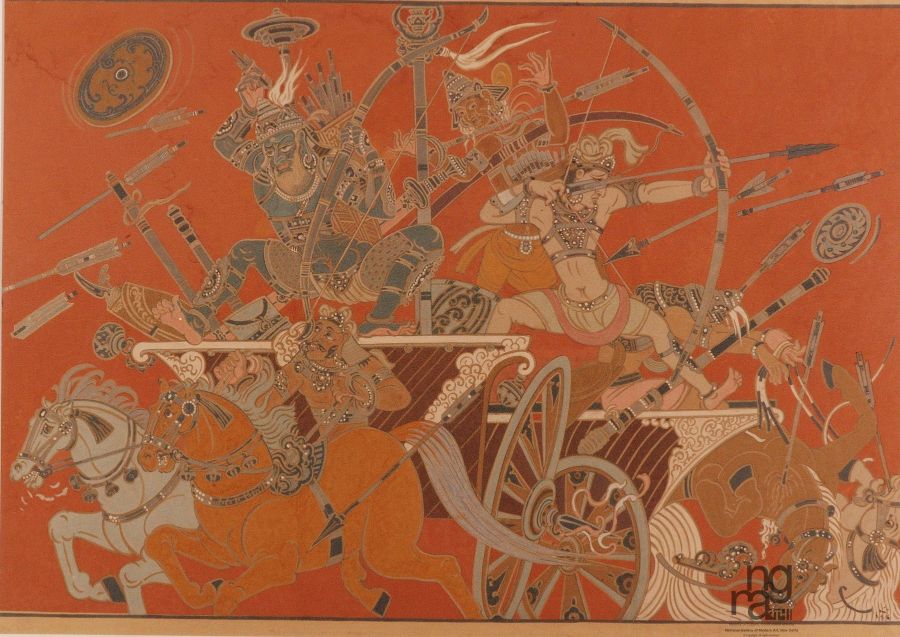 ×Nandalal's work reflects changing landscapes, portraits of people, sketches from life and places at the time of changing outlook in the modern Indian cultural domain. His nature to explore the various materials and mediums allowed him to make a prolific body of work in different mediums. Along with his explorations of art learning from the style of Rabindranath Tagore's art and Abanindranath's art, who was his teacher, he also imbibed the techniques of art from the European indigenous tradition and the Japanese wash technique. Nandalal's experiments in mural painting along with his students on the walls of various buildings in Shantiniketan gave rise to remarkable works of art. On such site with his murals is at the Kirti Mandir, Baroda made in 1946. This Image shows the studies of the same panel Abhimanue Badha, where the hero from Mahabharata is tragically slain.
×Nandalal's work reflects changing landscapes, portraits of people, sketches from life and places at the time of changing outlook in the modern Indian cultural domain. His nature to explore the various materials and mediums allowed him to make a prolific body of work in different mediums. Along with his explorations of art learning from the style of Rabindranath Tagore's art and Abanindranath's art, who was his teacher, he also imbibed the techniques of art from the European indigenous tradition and the Japanese wash technique. Nandalal's experiments in mural painting along with his students on the walls of various buildings in Shantiniketan gave rise to remarkable works of art. On such site with his murals is at the Kirti Mandir, Baroda made in 1946. This Image shows the studies of the same panel Abhimanue Badha, where the hero from Mahabharata is tragically slain. -
Painting
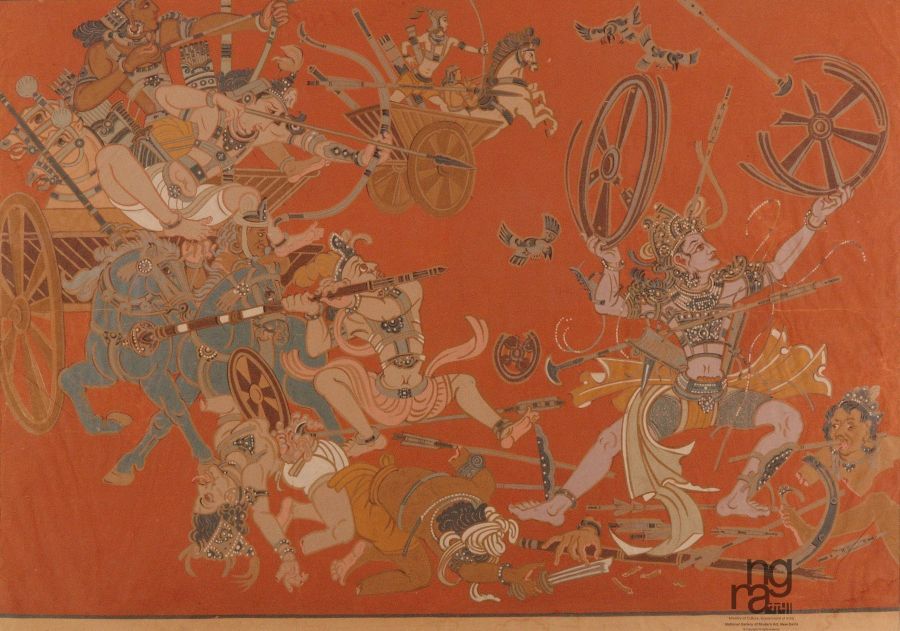 ×Nandalal's work reflects changing landscapes, portraits of people, sketches from life and places at the time of changing outlook in the modern Indian cultural domain. His nature to explore the various materials and mediums allowed him to make a prolific body of work in different mediums. Along with his explorations of art learning from the style of Rabindranath Tagore's art and Abanindranath's art, who was his teacher, he also imbibed the techniques of art from the European indigenous tradition and the Japanese wash technique. Nandalal's experiments in mural painting along with his students on the walls of various buildings in Shantiniketan gave rise to remarkable works of art. On such site with his murals is at the Kirti Mandir, Baroda made in 1946. This Image shows the studies of the same panel Abhimanue Badha, where the hero from Mahabharata is tragically slain.
×Nandalal's work reflects changing landscapes, portraits of people, sketches from life and places at the time of changing outlook in the modern Indian cultural domain. His nature to explore the various materials and mediums allowed him to make a prolific body of work in different mediums. Along with his explorations of art learning from the style of Rabindranath Tagore's art and Abanindranath's art, who was his teacher, he also imbibed the techniques of art from the European indigenous tradition and the Japanese wash technique. Nandalal's experiments in mural painting along with his students on the walls of various buildings in Shantiniketan gave rise to remarkable works of art. On such site with his murals is at the Kirti Mandir, Baroda made in 1946. This Image shows the studies of the same panel Abhimanue Badha, where the hero from Mahabharata is tragically slain. -
Painting
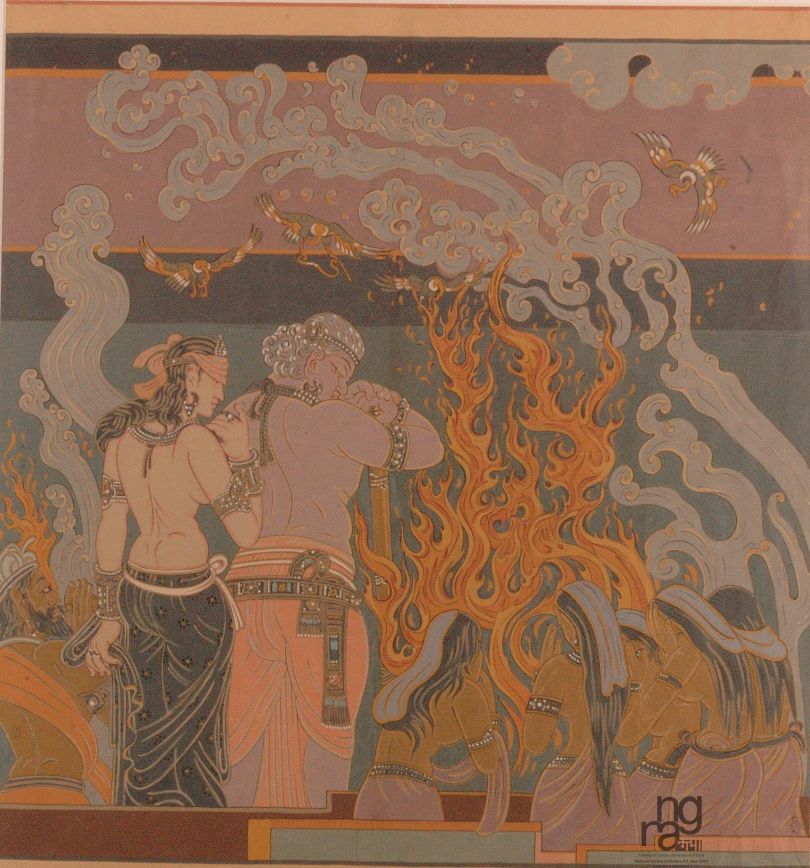 ×Nandalal's work reflects changing landscapes, portraits of people, sketches from life and places at the time of changing outlook in the modern Indian cultural domain. His nature to explore the various materials and mediums allowed him to make a prolific body of work in different mediums. Along with his explorations of art learning from the style of Rabindranath Tagore's art and Abanindranath's art, who was his teacher, he also imbibed the techniques of art from the European indigenous tradition and the Japanese wash technique. Nandalal's experiments in mural painting along with his students on the walls of various buildings in Shantiniketan gave rise to remarkable works of art. On such site with his murals is at the Kirti Mandir, Baroda made in 1946. This Image shows the studies of the same panel Abhimanue Badha, where the hero from Mahabharata is tragically slain.
×Nandalal's work reflects changing landscapes, portraits of people, sketches from life and places at the time of changing outlook in the modern Indian cultural domain. His nature to explore the various materials and mediums allowed him to make a prolific body of work in different mediums. Along with his explorations of art learning from the style of Rabindranath Tagore's art and Abanindranath's art, who was his teacher, he also imbibed the techniques of art from the European indigenous tradition and the Japanese wash technique. Nandalal's experiments in mural painting along with his students on the walls of various buildings in Shantiniketan gave rise to remarkable works of art. On such site with his murals is at the Kirti Mandir, Baroda made in 1946. This Image shows the studies of the same panel Abhimanue Badha, where the hero from Mahabharata is tragically slain. -
Painting
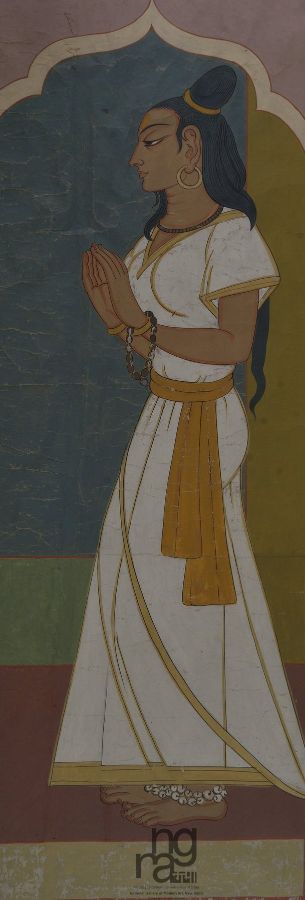 ×Nandalal had a strong affinity for sketching, his subjects being the surrounding environs, people in their everyday life or anything that he found fascinating. In this painting, he has depicted Meerabai standing with folded hand, rendered with the use of flat colours, delineating the contours of the figure and adding depth in the composition.
×Nandalal had a strong affinity for sketching, his subjects being the surrounding environs, people in their everyday life or anything that he found fascinating. In this painting, he has depicted Meerabai standing with folded hand, rendered with the use of flat colours, delineating the contours of the figure and adding depth in the composition. -
Painting
 ×Nandalal had a strong affinity for sketching, his subjects being the surrounding environs, people in their everyday life or anything that he found fascinating. In this painting, he has depicted Ahilya (referring to the character from the epic Ramayana) bowing down to lord Rama, for his blessings. Rendered with the use of colours in tonal variation, delineating the contours of the figures and adding depth to the composition.
×Nandalal had a strong affinity for sketching, his subjects being the surrounding environs, people in their everyday life or anything that he found fascinating. In this painting, he has depicted Ahilya (referring to the character from the epic Ramayana) bowing down to lord Rama, for his blessings. Rendered with the use of colours in tonal variation, delineating the contours of the figures and adding depth to the composition. -
Painting
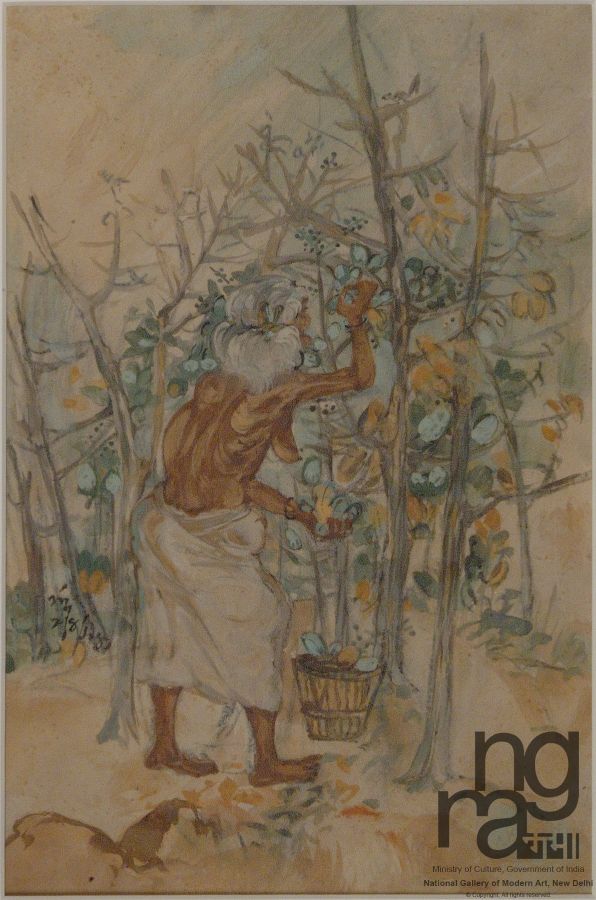 ×Nandalal had a strong affinity for sketching, his subjects being the surrounding environs, people in their everyday life or anything that he found fascinating. In this painting, he has depicted a tribal woman Sabari (referring to the character from epic Ramayana) plucking fruits from the trees and collecting it in her bucket. Rendered with the use of colours in tonal variation, delineating the contours of the figure and adding depth to the composition.
×Nandalal had a strong affinity for sketching, his subjects being the surrounding environs, people in their everyday life or anything that he found fascinating. In this painting, he has depicted a tribal woman Sabari (referring to the character from epic Ramayana) plucking fruits from the trees and collecting it in her bucket. Rendered with the use of colours in tonal variation, delineating the contours of the figure and adding depth to the composition. -
Painting
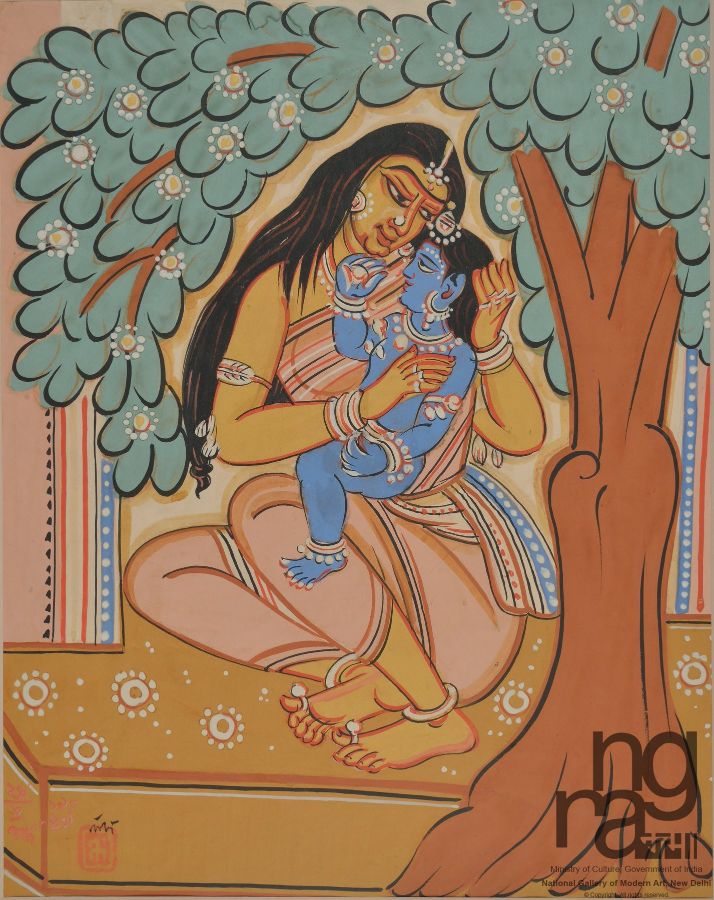 ×Nandalal had a strong affinity for sketching, his subjects being the surrounding environs, people in their everyday life or anything that he found fascinating. In this painting, he has depicted Yashoda holding her child ‘Krishna’ in her arms with tenderness (referring to the Hindu mythological character) sitting in the veranda. Rendered with the use of colours in tonal variation, delineating the contours of the figures and adding depth to the composition.
×Nandalal had a strong affinity for sketching, his subjects being the surrounding environs, people in their everyday life or anything that he found fascinating. In this painting, he has depicted Yashoda holding her child ‘Krishna’ in her arms with tenderness (referring to the Hindu mythological character) sitting in the veranda. Rendered with the use of colours in tonal variation, delineating the contours of the figures and adding depth to the composition. -
Print
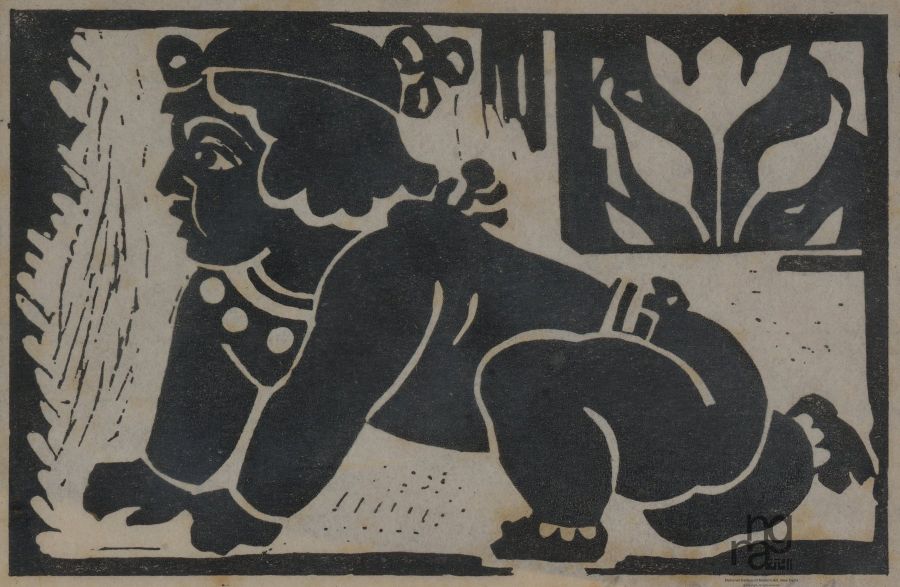 ×Nandalal's work depicts changing landscapes, portraits of people, sketches from life and places at the time of changing outlook in the modern Indian cultural domain. His nature to explore the various materials and mediums allowed him to make a prolific body of work in different mediums. This work is a Linocut print, depicting the image of child Krishna, by the artist.
×Nandalal's work depicts changing landscapes, portraits of people, sketches from life and places at the time of changing outlook in the modern Indian cultural domain. His nature to explore the various materials and mediums allowed him to make a prolific body of work in different mediums. This work is a Linocut print, depicting the image of child Krishna, by the artist. -
Print
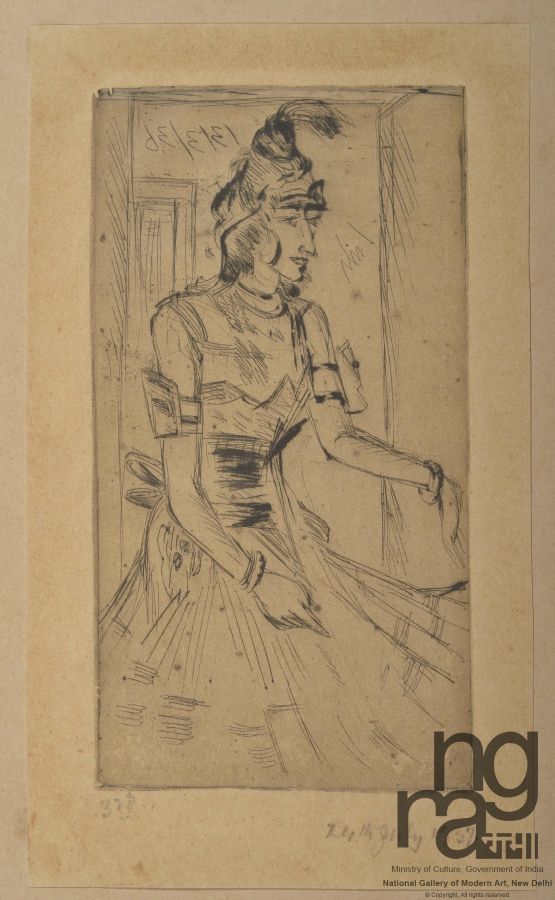 ×Nandalal preferred drawing from life, often sketching outdoors with the subject being life, nature studies, landscapes, figure drawings and animals. This particular print depicts a Hindu mythological character Chitrangada, wife of Arjuna standing gracefully. The svelte structure is rendered with linear, firm yet fluid lines incised on the hard surface preferably copper plate, imprinted on a paper with the help of black ink. The sharp strokes articulate the contours and suggests her demeanour.
×Nandalal preferred drawing from life, often sketching outdoors with the subject being life, nature studies, landscapes, figure drawings and animals. This particular print depicts a Hindu mythological character Chitrangada, wife of Arjuna standing gracefully. The svelte structure is rendered with linear, firm yet fluid lines incised on the hard surface preferably copper plate, imprinted on a paper with the help of black ink. The sharp strokes articulate the contours and suggests her demeanour. -
Print
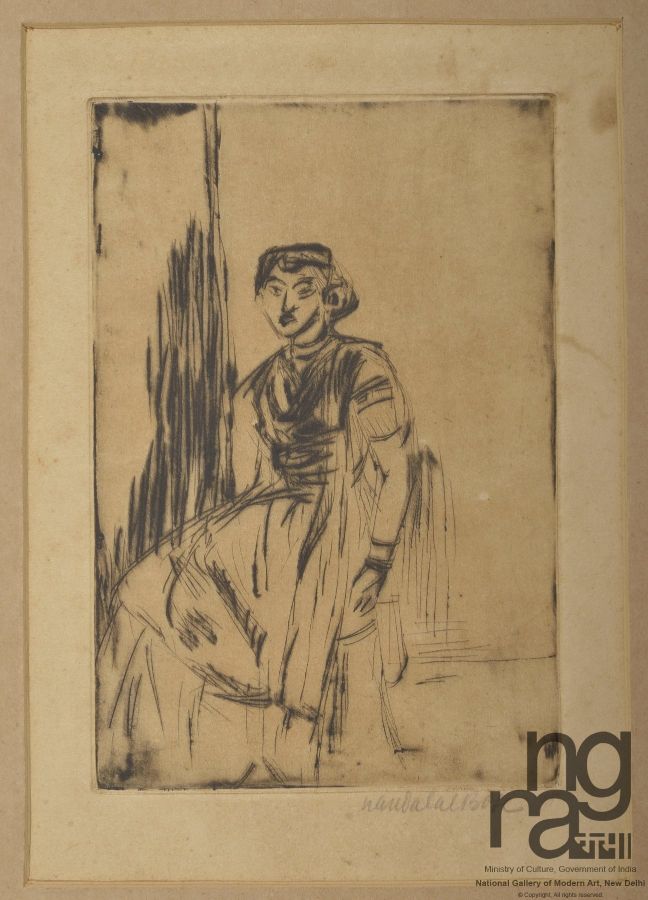 ×Nandalal preferred drawing from life, often sketching outdoors with the subject being life, nature studies, landscapes, figure drawings and animals. This particular print depicts an actor waiting her turn to play the Hindu mythological character of Chitrangada. The composition is rendered with linear, firm yet fluid lines incised on the hard surface, probably a copper plate, imprinted on a paper with the help of black ink. The sharp strokes articulate the contours and suggest her demeanour.
×Nandalal preferred drawing from life, often sketching outdoors with the subject being life, nature studies, landscapes, figure drawings and animals. This particular print depicts an actor waiting her turn to play the Hindu mythological character of Chitrangada. The composition is rendered with linear, firm yet fluid lines incised on the hard surface, probably a copper plate, imprinted on a paper with the help of black ink. The sharp strokes articulate the contours and suggest her demeanour. -
Painting
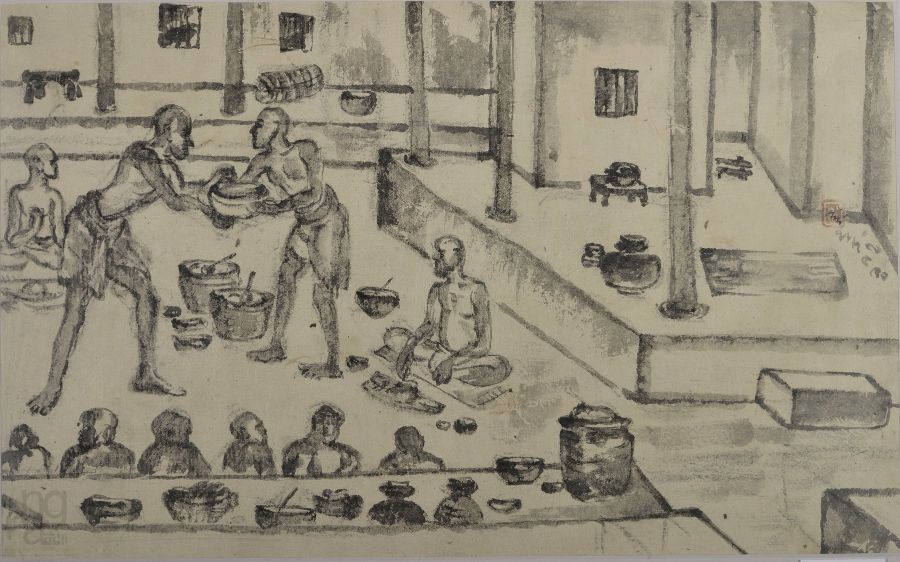 ×The above monochrome watercolour illustration by Nandalal depicts two men serving Mahaprasad to a group of people sitting in a row on the floor. The composition is rendered with bold, fluid brush strokes to delineate the contours of the forms. The strokes are diluted further to achieve tonal variation from darker to grey, a technique Nandalal learned from the arts of the Far East.
×The above monochrome watercolour illustration by Nandalal depicts two men serving Mahaprasad to a group of people sitting in a row on the floor. The composition is rendered with bold, fluid brush strokes to delineate the contours of the forms. The strokes are diluted further to achieve tonal variation from darker to grey, a technique Nandalal learned from the arts of the Far East. -
Painting
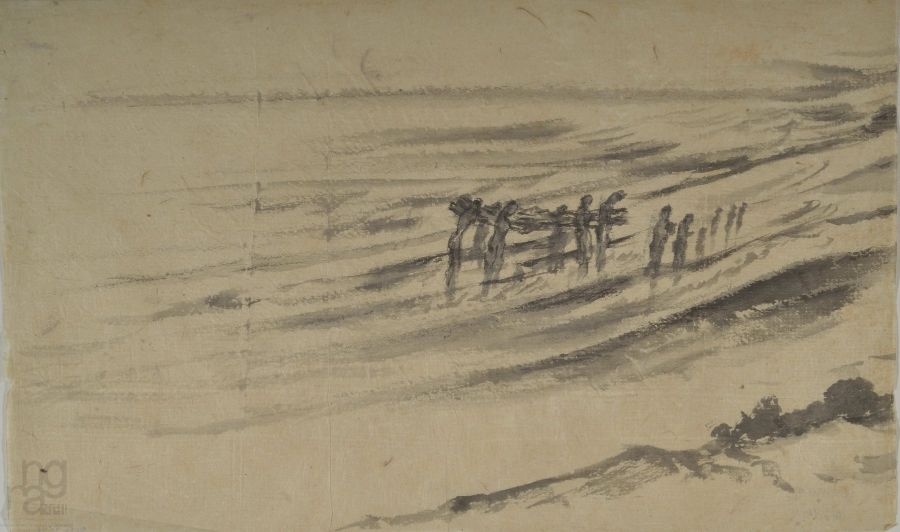 ×This painting belongs to a series of monochromatic ink and watercolour paintings inspired by the Sumi-e Japanese technique the artist employed in the last phase of his life. These compositions were stripped to the bare minimum where only a few strokes of ink were employed to create natural forms in an effortless approach. The above painting belongs to the 'Nirvan -II' series. The artist has executed a scene of Nirvan, with a range of strokes in tonal variations capturing the rhythm and pattern of the image. This painting was purchased from the collection of Shri Biswaroop Bose and Smt. Nivedita Bose, children of Nandalal Bose.
×This painting belongs to a series of monochromatic ink and watercolour paintings inspired by the Sumi-e Japanese technique the artist employed in the last phase of his life. These compositions were stripped to the bare minimum where only a few strokes of ink were employed to create natural forms in an effortless approach. The above painting belongs to the 'Nirvan -II' series. The artist has executed a scene of Nirvan, with a range of strokes in tonal variations capturing the rhythm and pattern of the image. This painting was purchased from the collection of Shri Biswaroop Bose and Smt. Nivedita Bose, children of Nandalal Bose. -
Painting
 ×This painting belongs to a series of monochromatic ink and watercolour paintings inspired by the Sumi-e Japanese technique the artist employed in the last phase of his life. These compositions were stripped to the bare minimum where only a few strokes of ink were employed to create natural forms in an effortless approach. The above painting belongs to the 'Pilgrim' series. The artist has executed a period of exile, with a range of strokes in tonal variations capturing the rhythm and pattern of the image. This painting was purchased from the collection of Shri Biswaroop Bose and Smt. Nivedita Bose, children of Nandalal Bose.
×This painting belongs to a series of monochromatic ink and watercolour paintings inspired by the Sumi-e Japanese technique the artist employed in the last phase of his life. These compositions were stripped to the bare minimum where only a few strokes of ink were employed to create natural forms in an effortless approach. The above painting belongs to the 'Pilgrim' series. The artist has executed a period of exile, with a range of strokes in tonal variations capturing the rhythm and pattern of the image. This painting was purchased from the collection of Shri Biswaroop Bose and Smt. Nivedita Bose, children of Nandalal Bose. -
Painting
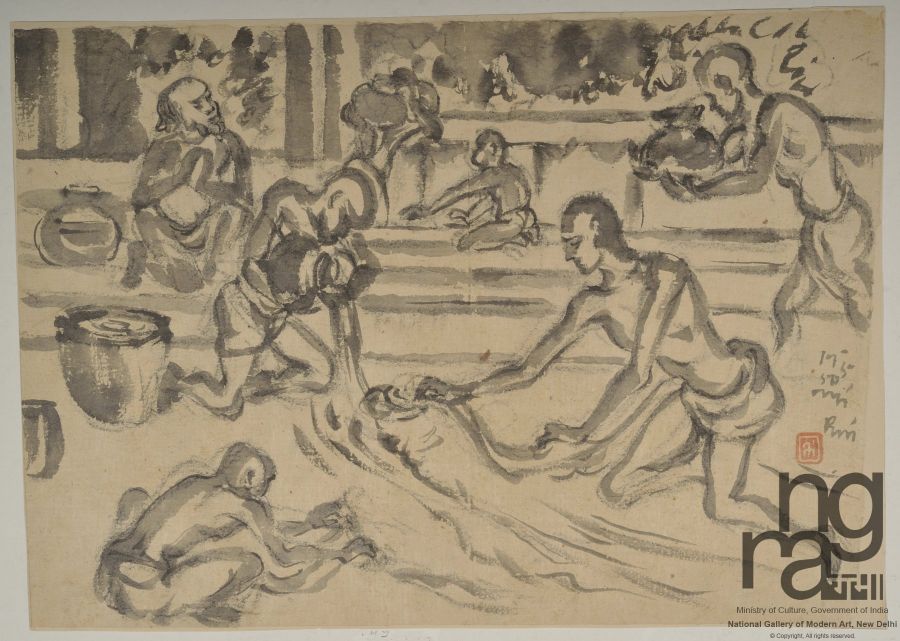 ×This painting belongs to a series of monochromatic ink and watercolour paintings inspired by the Sumi-e Japanese technique the artist employed in the last phase of his life. These compositions were stripped to the bare minimum where only a few strokes of ink were employed to create natural forms in an effortless approach. The above painting belongs to the 'Cleaning the Temple' series. The artist has executed a group of people cleaning the temple, with a range of strokes in tonal variations capturing the rhythm and pattern of the image. This painting was purchased from the collection of Shri Biswaroop Bose and Smt. Nivedita Bose, children of Nandalal Bose.
×This painting belongs to a series of monochromatic ink and watercolour paintings inspired by the Sumi-e Japanese technique the artist employed in the last phase of his life. These compositions were stripped to the bare minimum where only a few strokes of ink were employed to create natural forms in an effortless approach. The above painting belongs to the 'Cleaning the Temple' series. The artist has executed a group of people cleaning the temple, with a range of strokes in tonal variations capturing the rhythm and pattern of the image. This painting was purchased from the collection of Shri Biswaroop Bose and Smt. Nivedita Bose, children of Nandalal Bose. -
Painting
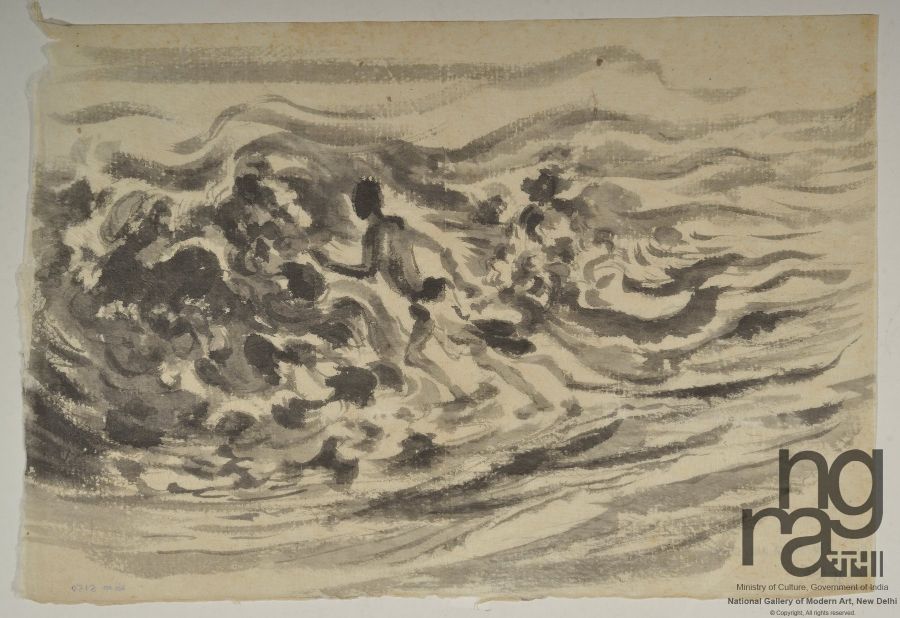 ×This painting belongs to a series of monochromatic ink and watercolour paintings inspired by the Sumi-e Japanese technique the artist employed in the last phase of his life. These compositions were stripped to the bare minimum where only a few strokes of ink were employed to create natural forms in an effortless approach. The above painting belongs to the 'Chaitanya and Surf' series. The artist has executed Chaitanya moving in the same rhythm as the waves of the sea creating a harmony with the surf, with a range of strokes in tonal variations capturing the rhythm and pattern of the image. This painting was purchased from the collection of Shri Biswaroop Bose and Smt. Nivedita Bose, children of Nandalal Bose.
×This painting belongs to a series of monochromatic ink and watercolour paintings inspired by the Sumi-e Japanese technique the artist employed in the last phase of his life. These compositions were stripped to the bare minimum where only a few strokes of ink were employed to create natural forms in an effortless approach. The above painting belongs to the 'Chaitanya and Surf' series. The artist has executed Chaitanya moving in the same rhythm as the waves of the sea creating a harmony with the surf, with a range of strokes in tonal variations capturing the rhythm and pattern of the image. This painting was purchased from the collection of Shri Biswaroop Bose and Smt. Nivedita Bose, children of Nandalal Bose. -
Painting
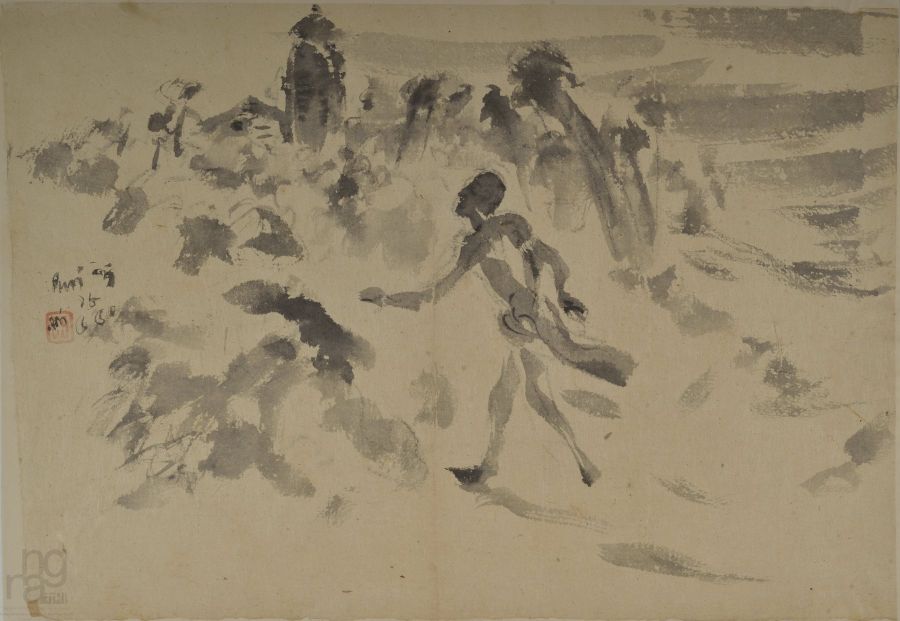 ×This painting belongs to a series of monochromatic ink and watercolour paintings inspired by the Sumi-e Japanese technique the artist employed in the last phase of his life. These compositions were stripped to the bare minimum where only a few strokes of ink were employed to create natural forms in an effortless approach. The above painting belongs to the 'Temple Attracting Chaitanya' series. The artist has executed Chaitanya moving towards a temple seen at a distance, with a range of strokes in tonal variations capturing the rhythm and pattern of the image. This painting was purchased from the collection of Shri Biswaroop Bose and Smt. Nivedita Bose, children of Nandalal Bose.
×This painting belongs to a series of monochromatic ink and watercolour paintings inspired by the Sumi-e Japanese technique the artist employed in the last phase of his life. These compositions were stripped to the bare minimum where only a few strokes of ink were employed to create natural forms in an effortless approach. The above painting belongs to the 'Temple Attracting Chaitanya' series. The artist has executed Chaitanya moving towards a temple seen at a distance, with a range of strokes in tonal variations capturing the rhythm and pattern of the image. This painting was purchased from the collection of Shri Biswaroop Bose and Smt. Nivedita Bose, children of Nandalal Bose. -
Painting
 ×This painting belongs to a series of monochromatic ink and watercolour paintings inspired by the Sumi-e Japanese technique the artist employed in the last phase of his life. These compositions were stripped to the bare minimum where only a few strokes of ink were employed to create natural forms in an effortless approach. The above painting belongs to the 'Chaitanya Fainting at the Temple' series. The artist has executed Chaitanya fainting at the temple stairs and two persons helping him, with a range of strokes in tonal variations capturing the rhythm and pattern of the image. This painting was purchased from the collection of Shri Biswaroop Bose and Smt. Nivedita
×This painting belongs to a series of monochromatic ink and watercolour paintings inspired by the Sumi-e Japanese technique the artist employed in the last phase of his life. These compositions were stripped to the bare minimum where only a few strokes of ink were employed to create natural forms in an effortless approach. The above painting belongs to the 'Chaitanya Fainting at the Temple' series. The artist has executed Chaitanya fainting at the temple stairs and two persons helping him, with a range of strokes in tonal variations capturing the rhythm and pattern of the image. This painting was purchased from the collection of Shri Biswaroop Bose and Smt. Nivedita -
Painting
 ×This painting belongs to a series of monochromatic ink and watercolour paintings inspired by the Sumi-e Japanese technique the artist employed in the last phase of his life. These compositions were stripped to the bare minimum where only a few strokes of ink were employed to create natural forms in an effortless approach. The above painting belongs to the ""Prayer in the Temple"" series. The artist has executed group of people performing prayer at the temple, with a range of strokes in tonal variations capturing the rhythm and pattern of the image. This painting was purchased from the collection of Shri Biswaroop Bose and Smt. Nivedita Bose, children of Nandalal Bose.
×This painting belongs to a series of monochromatic ink and watercolour paintings inspired by the Sumi-e Japanese technique the artist employed in the last phase of his life. These compositions were stripped to the bare minimum where only a few strokes of ink were employed to create natural forms in an effortless approach. The above painting belongs to the ""Prayer in the Temple"" series. The artist has executed group of people performing prayer at the temple, with a range of strokes in tonal variations capturing the rhythm and pattern of the image. This painting was purchased from the collection of Shri Biswaroop Bose and Smt. Nivedita Bose, children of Nandalal Bose. -
Painting
 ×This painting belongs to a series of monochromatic ink and watercolour paintings inspired by the Sumi-e Japanese technique the artist employed in the last phase of his life. These compositions were stripped to the bare minimum where only a few strokes of ink were employed to create natural forms in an effortless approach. The above painting belongs to the 'Nirvan -I' series. The artist has executed a scene of Nirvan, with a range of strokes in tonal variations capturing the rhythm and pattern of the image. This painting was purchased from the collection of Shri Biswaroop Bose and Smt. Nivedita Bose, children of Nandalal Bose.
×This painting belongs to a series of monochromatic ink and watercolour paintings inspired by the Sumi-e Japanese technique the artist employed in the last phase of his life. These compositions were stripped to the bare minimum where only a few strokes of ink were employed to create natural forms in an effortless approach. The above painting belongs to the 'Nirvan -I' series. The artist has executed a scene of Nirvan, with a range of strokes in tonal variations capturing the rhythm and pattern of the image. This painting was purchased from the collection of Shri Biswaroop Bose and Smt. Nivedita Bose, children of Nandalal Bose. -
Painting
 ×This painting belongs to a series of monochromatic ink and watercolour paintings inspired by the Sumi-e Japanese technique the artist employed in the last phase of his life. These compositions were stripped to the bare minimum where only a few strokes of ink were employed to create natural forms in an effortless approach. The above painting belongs to the 'Carrying Mahaprasad' series. The artist has executed a group of people carrying mahaprasad, with a range of strokes in tonal variations capturing the rhythm and pattern of the image. This painting was purchased from the collection of Shri Biswaroop Bose and Smt. Nivedita Bose, children of Nandalal Bose.
×This painting belongs to a series of monochromatic ink and watercolour paintings inspired by the Sumi-e Japanese technique the artist employed in the last phase of his life. These compositions were stripped to the bare minimum where only a few strokes of ink were employed to create natural forms in an effortless approach. The above painting belongs to the 'Carrying Mahaprasad' series. The artist has executed a group of people carrying mahaprasad, with a range of strokes in tonal variations capturing the rhythm and pattern of the image. This painting was purchased from the collection of Shri Biswaroop Bose and Smt. Nivedita Bose, children of Nandalal Bose. -
Painting
 ×This painting belongs to a series of monochromatic ink and watercolour paintings inspired by the Sumi-e Japanese technique the artist employed in the last phase of his life. These compositions were stripped to the bare minimum where only a few strokes of ink were employed to create natural forms in an effortless approach. The above painting belongs to the 'Daridranarayan Bhoj' series. The artist has executed a group of Daridranaryan?s sitting on the floor and a person serving them food, with a range of strokes in tonal variations capturing the rhythm and pattern of the image. This painting was purchased from the collection of Shri Biswaroop Bose and Smt. Nivedita Bose, children of Nandalal Bose.
×This painting belongs to a series of monochromatic ink and watercolour paintings inspired by the Sumi-e Japanese technique the artist employed in the last phase of his life. These compositions were stripped to the bare minimum where only a few strokes of ink were employed to create natural forms in an effortless approach. The above painting belongs to the 'Daridranarayan Bhoj' series. The artist has executed a group of Daridranaryan?s sitting on the floor and a person serving them food, with a range of strokes in tonal variations capturing the rhythm and pattern of the image. This painting was purchased from the collection of Shri Biswaroop Bose and Smt. Nivedita Bose, children of Nandalal Bose. -
Painting
 ×The above painting is a perceptible representation of a ferocious avatar of the Hindu goddess Durga mounted on her lion. She is depicted with multiple arms, each with weapons, against the red background adding to the ferociousness of the goddess. The illustration is rendered with bold, linear ink strokes articulating the aggressive avatar of the goddess.
×The above painting is a perceptible representation of a ferocious avatar of the Hindu goddess Durga mounted on her lion. She is depicted with multiple arms, each with weapons, against the red background adding to the ferociousness of the goddess. The illustration is rendered with bold, linear ink strokes articulating the aggressive avatar of the goddess. -
Painting
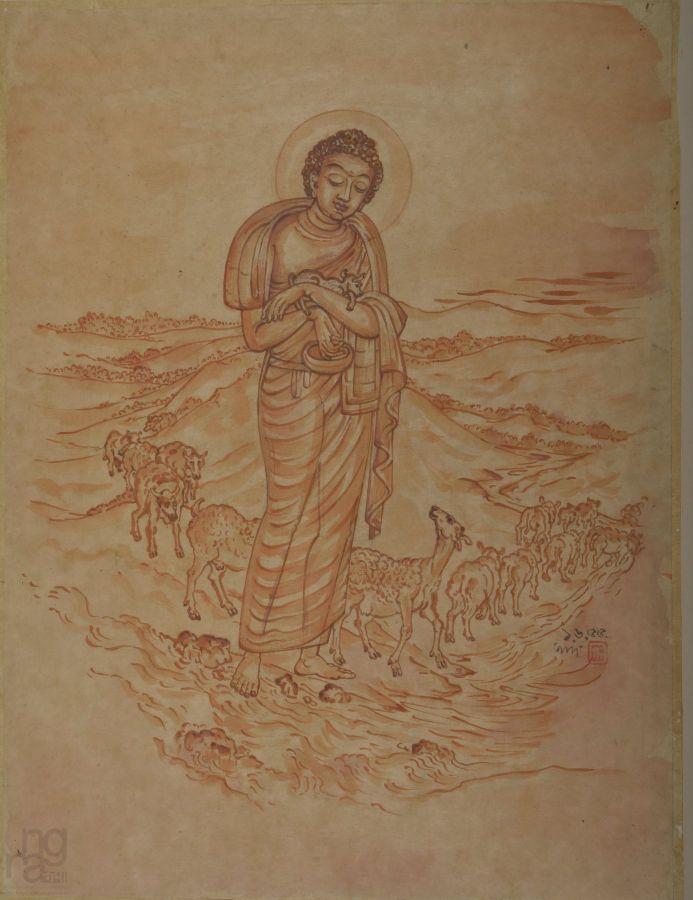 ×Nandalal is known to have fervently sketched on postcard sized papers mostly using ink and brush, recording his surroundings. The above sketch by the artist depicts lord Buddha standing on a hilly region while holding a lamb, against the backdrop of herd of sheep walking in a line towards the horizon. The composition is rendered with linear, soft brush strokes delineating the somber forms and suggesting the demeanour of the subject.
×Nandalal is known to have fervently sketched on postcard sized papers mostly using ink and brush, recording his surroundings. The above sketch by the artist depicts lord Buddha standing on a hilly region while holding a lamb, against the backdrop of herd of sheep walking in a line towards the horizon. The composition is rendered with linear, soft brush strokes delineating the somber forms and suggesting the demeanour of the subject. -
Painting
 ×Nandalal had a strong affinity for sketching, his subjects being the surrounding environs, people in their everyday life or anything that he found fascinating. The above sketch by the artist is a perceptible representation of one of the sculptures of Konark temple. The composition depicts an adorned horse in movement, with two men looking at the viewers. The figures are delineated with continuous, bold brush strokes articulating the basic contours and suggesting their demeanours.
×Nandalal had a strong affinity for sketching, his subjects being the surrounding environs, people in their everyday life or anything that he found fascinating. The above sketch by the artist is a perceptible representation of one of the sculptures of Konark temple. The composition depicts an adorned horse in movement, with two men looking at the viewers. The figures are delineated with continuous, bold brush strokes articulating the basic contours and suggesting their demeanours. -
Painting
 ×In this sketch, Nandalal depicts lord Ganesh in a simple line drawing, with detail ornamental representation of the Goddess. He employs swift, brush strokes that define its characteristic features and add grace to the form.
×In this sketch, Nandalal depicts lord Ganesh in a simple line drawing, with detail ornamental representation of the Goddess. He employs swift, brush strokes that define its characteristic features and add grace to the form. -
Painting
 ×Nandalal prefered drawing from life, often sketching outdoors with the subject being life, nature studies, landscapes, figure drawings and animals. In the above sketch the artist depicts Yashodha dressing Lord Krishna. The lean figures are rendered with thin, bold brush strokes delineating the contours of the forms and suggesting the demeanour of the subjects.
×Nandalal prefered drawing from life, often sketching outdoors with the subject being life, nature studies, landscapes, figure drawings and animals. In the above sketch the artist depicts Yashodha dressing Lord Krishna. The lean figures are rendered with thin, bold brush strokes delineating the contours of the forms and suggesting the demeanour of the subjects. -
Painting
 ×This painting belongs to a series of monochromatic ink and watercolour paintings inspired by the Sumi-e Japanese technique the artist employed in the last phase of his life. These compositions were stripped to the bare minimum where only a few strokes of ink were employed to create natural forms in an effortless approach. The above painting belongs to the 'Two Monks' series. The artist has executed two monks walking together, holding a stick and a bowl in their hand in the foreground, with a range of strokes in tonal variations capturing the rhythm and pattern of the image. This painting was purchased from the collection of Shri Biswaroop Bose and Smt. Nivedita Bose, children of Nandalal Bose.
×This painting belongs to a series of monochromatic ink and watercolour paintings inspired by the Sumi-e Japanese technique the artist employed in the last phase of his life. These compositions were stripped to the bare minimum where only a few strokes of ink were employed to create natural forms in an effortless approach. The above painting belongs to the 'Two Monks' series. The artist has executed two monks walking together, holding a stick and a bowl in their hand in the foreground, with a range of strokes in tonal variations capturing the rhythm and pattern of the image. This painting was purchased from the collection of Shri Biswaroop Bose and Smt. Nivedita Bose, children of Nandalal Bose.





